This website uses cookies to improve your browsing experience and analyze the use of the website. Learn More


Self-Guided Rome Walking Tours

In this post, we provide you with free, self-guided central Rome walking tours with a printable sightseeing map as well as an audio tour option for smartphones.
You can use these to discover the city at your own pace (or) as a preview for what you will see on a live-guided tour.
Check out our free walking tours of Rome .
We have 4 other self-guided tours that we hope you will consider.
- Vatican City + St. Peter's Basilica
- Jewish Ghetto
SELF-GUIDED TOUR OF ROME'S CENTRE
This self-guided tour will lead you through some of Rome’s main attractions, from the Spanish Steps through Trevi Fountain to Campo de’ Fiori.
All in all, there are lots of sights along the way covering more than two thousand years of history.
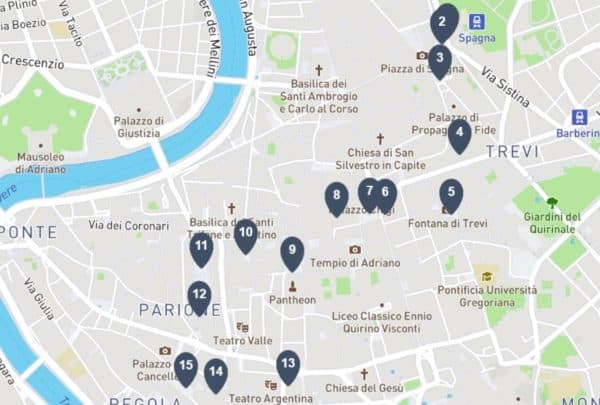
Here are a few of the sites you can expect to see on this tour:
- Piazza Navona
- The Pantheon
- Trevi Fountain
- Spanish Steps
- Venice Square
- Campo de’ Fiori
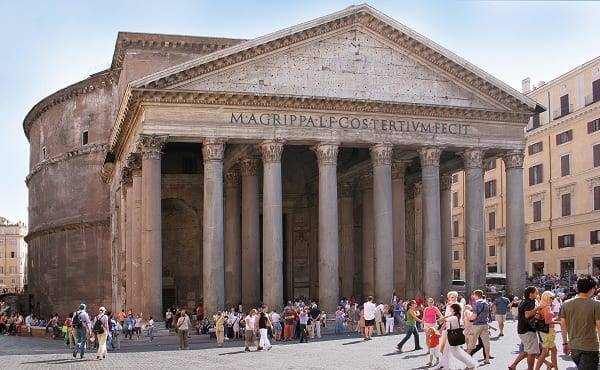
We also have our own audio tour where you can find a more in-depth GPS-led audio tour version. Here's a sample.
Purchase an audio tour here
There are also daily guided free tours both day and night that really operate on the pay-what-you-like model.
Tours listed below are run through us. More guided tours are available here .
Searching Availability...
This 15-stop, self-guided tour will lead you through some of Rome’s main attractions, from the Spanish Steps through Trevi Fountain to Campo de’ Fiori, with lots of sights along the way covering more than two thousand years of history.
It’s best to set aside 2-3 hours for walking this route.
You’ll be seeing plenty of both tourists and Romans as you walk, and both groups make good people-watching, not to mention plenty of chances for photos, coffee, gelato, and historical color.

Click on the map to enlarge or download it to a smartphone.
If you haven’t done much walking in the older parts of Rome yet, the ancient layout of these streets can be confusing.
Streets are winding, pedestrians and cars often share space, and you’ll regularly find your way into piazzas, the large open squares Rome is organized around.
You can get this tour with directions in 3 ways:
- Download this tour to the Google Maps App ( link ).
- Download a PDF version .
- Purchase an Audio Tour
We will be orienting you relative to buildings and with the help of street names, which you’ll see on signs up above eye level.
As far as timing, this tour can be enjoyed any time the sun is up, and some of the piazzas are lively even after dark.
Crowds can be a limiting factor throughout this walk; if you want to start things off on a quiet note, the Spanish Steps, one of our first stops, tend to be at their quietest early in the morning, briefly during lunch, and around sunset.

The tour begins at the Spagna metro station.
As you emerge from the western side of the building, you can look to your right and get a full view of the Villa Medici, not far down the street.

1. VILLA MEDICI
The Villa Medici, along with the Villa Borghese (which houses the Galleria Borghese) beyond it, stands on the site of the Gardens of Lucullus, created more than two thousand years ago, back when Romans saw gardening as a strange new hobby imported from Persia.
But the house you see today is built in 1576 after the land had been a quiet vineyard for centuries.

Villa Medici Rear
Houses like the Villa Medici were designed with ancient styles in mind, and inside, they often displayed the ancient relics found in the earth dug up to lay foundations.
The Medicis and Borgheses were some of Italy’s most powerful families during the Renaissance and beyond.
The Medici clan included bankers, nobility, and popes. But they’re remembered mostly for their support for the arts and sciences.
The Villa Medici offers guided tours daily, lasting about 90 minutes and available in different languages at different times.
It’s open every day but Monday and standard admission is 12 Euros.
Villa Borghese is home to the third-largest public park in Rome; admission is free and it’s accessible from dawn to dusk daily.
There are several things to see and do here in the park.

Most notably, it’s home to the Galleria Borghese , where you can see plenty of art and artifacts from both the Classical and Renaissance eras, plus several other museums and galleries.
The Villa Giulia contains a museum to the Etruscans, a rival culture of the early Romans.
In addition to the museums, there’s a zoo and a replica of Shakespeare’s Globe Theater on the grounds.
2. SPANISH STEPS
For many foreigners, the Spanish Steps are visual shorthand for Rome; they’re used in lots of movies and TV shows, starting with Roman Holiday back in 1953.
This was a natural hillside as recently as 1723. Before the steps were built, this was the slope of the Pincio Hill, one of many hills around Rome.
The 138 steps were built in the 18th century and got their name due to the adjacent Spanish Embassy.
Unfortunately as of 2019, you can no longer sit on the Spanish Steps. Violaters can receive a fine as high as €400.
Eating on the steps is also banned.
At the bottom of the steps sits the Piazza di Spagna and the Fontana della Barcaccia , which means “Fountain of the Long Boat.”
The legend goes that the design of the fountain comes from a boat washed into this piazza by a flood of the Tiber River.

This is the first of many fountains that we’ll see, and it’s designed by Pietro Bernini in the 17 th century, before the steps.
Pietro Bernini is the father of famous architect Gian Lorenzo Bernini, whose work we’ll also see plenty of.
When you get to the bottom, look up the stairs for a view of that French church at the top, called Trinita dei Monti.
If you look to the right side of the steps from the bottom, you’ll see a peach-colored building, the Keats-Shelley Museum. English poet John Keats arrived to live here in 1820.
If a café stop is in order before you go any further, the Antico Caffe Greco near the bottom of the stairs was one of his hangouts.
When you’re done here, walk away from the steps and past the fountain. Turn left and you’ll see the piazza narrowing toward a freestanding column, the Column of the Immaculate Conception.
3. COLUMN OF THE IMMACULATE CONCEPTION AND PIAZZA MIGNANELLI
The Column of the Immaculate Conception is the centerpiece of the small Piazza Mignanelli that opens from the corner of the Piazza di Spagna.

The statue on top of the column is a bronze Virgin Mary. Mary, the mother of Jesus, occupies a central place in Catholic belief.
And this statue of her was built in 1857 to commemorate the Pope’s recent declaration of the Doctrine of the Immaculate Conception: the idea that Mary, uniquely among human beings, was born without original sin.
Original sin is visible in the monument in the form of the snake Mary is stepping on.
Below her are the authors of the four Biblical gospels, and still further down are four prophets said to have foretold her birth, with reliefs depicting four phases of her story below them.
Depending on when you’re here, there’s a small chance you’ll see a wreath of flowers on the statue.
December 8th is the Feast of the Immaculate Conception; each year on that day, the Pope visits this spot along with the head of the fire department, which originally erected the column, and they leave the wreath behind.
The building beyond the column is the Palazzo di Propaganda Fide – the Palace of the Propagation of the Faith.
This is a Vatican property – you can tell from the yellow flag on the front – and for a long time, it was the home of a church division responsible for missionary work and evangelism.
4. AQUEDUCT RUINS
Looking down at this spot, you can see something that an ancient Roman would have had to look up at.
The aqueducts – imperial Rome’s famous system for bringing clean water into the city – relied on gravity to work.
So, water was sometimes flowing over the heads of the people who were going to consume it, with roads passing under the arches you can see the top of from here.
Being by a river, Rome has flooded many times through the millennia, piling sediment each time, hiding but also preserving the ancient city.
The fence here limits the view, but above the arch, you can maybe see an inscription with the word “Germanicus” just readable at the near end.
This is one of the names of the emperor Claudius, who the inscription credits with rebuilding this stretch of the Aqua Virgo, the system of aqueducts built to bring water to the newly urbanizing Campus Martius after it was incorporated into the city.
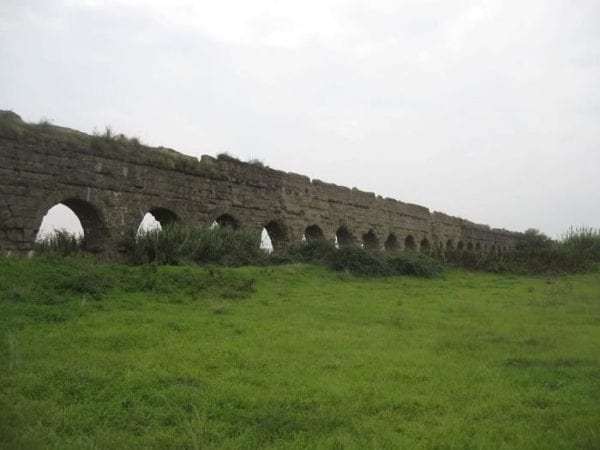
To achieve this, Roman engineers had to build a system of gentle slopes across long distances of irregular terrain, including crossing rivers, bringing convenience, comfort, and health within reach of Rome’s residents.
This knowledge was lost with the fall of Rome; with the Renaissance, writings about the aqueducts were rediscovered.
Across Via del Nazareno from these ruins is a tiny door, used to enter the rebuilt Acqua Vergine, the Renaissance replacement for the ancient system.
And in a moment, you’ll see another piece of that system: a fountain meant to put this reborn marvel of engineering on display.
5. TREVI FOUNTAIN
There’s likely to be a crowd around when you reach the Trevi Fountain, and even in the absence of people, the water can make it a loud spot. Find a view of the fountain from the front.

The main statue in the fountain depicts the god Oceanus. Below him, you can see his retinue of tritons, men mixed with fish.
The one on the right is blowing a shell to announce their arrival. And the wild creature each of them is struggling with is called a hippocampus, a horse mixed with a fish.
In this case, they also have wings. Greco-Roman mythology tells that horses were the creation of the god of the ocean.
The fountain is the end of the Acqua Vergine aqueduct, the recreation of the ancient Aqua Virgo aqueduct. And the design of the fountain tells that story.
Above the statues, on either side, you can see reliefs – the one on the left is a man with a scroll, showing plans for the aqueducts, and on the right, a woman points out a flow of freshwater to a group of men.
She’s the Virgo, the young woman, in Aqua Virgo – the legend is that when Roman surveyors looked for a source of water, a young woman led them to a spring, and the resulting aqueduct was named for her.
The statue on the left of Oceanus represents Abundance – she has a cornucopia full of fruit, and on the ground beside her is an urn spilling water.
On the right is Health, who’s holding a bowl with a snake drinking from it – snakes were ancient symbols of medicine.
Overall, the story is of the power of Rome to tame the forces of nature and bring them to the benefit of the city’s people.
As you see it, the fountain dates from 1762, and it started as a showpiece for the Renaissance project of rebuilding the aqueducts.
But it was such a massive endeavor that it took more than a century, plus many financiers and designers, to make it happen.
And it takes steady renovations to keep it looking sharp – as of the latest one in 2015, the fountain is lit at night.
Like the Spanish Steps, the Trevi Fountain owes some of its fame to a film – in this case, La Dolce Vita by Federico Fellini (see the video above).
If you’ve seen the movie, you won’t be surprised to hear that dancing in the fountain, or entering it in any way, is illegal.
And as for drinking: yes, these fountains were once the source for public drinking water, but for your own sake, wait for one of Rome’s other great works of water infrastructure, the nasoni – little drinking fountains located all over town.
Trevi Fountain is home to lots and lots of coins - visitors observe a tradition of throwing change into the fountain, hoping for good luck and the promise of a return to Rome.
Usually, coins are thrown backward over your shoulder, so make sure the coast is clear before you participate in this tradition, and watch out for other coin-tossers nearby.
And the money, totaling more than three thousand Euros per day, goes to Caritas Roma, a Catholic charity supporting the poor and homeless.
6. GALLERIA ALBERTO SORDI
All that’s columned is not ancient, as evidenced by this shopping mall, opened in 1922 and built in a style of Art Nouveau that borrows from multiple phases of Rome’s historic architecture.

That design continues into the inside, where you can find a stained glass ceiling above stores selling plenty of Rome’s signature high-end fashion.
It’s an easy place to step inside if you need to cool off or to use the restrooms.
You can also find several places serving the classic cappuccino and cornetto - Italian croissants, which locals eat in the morning, and tourists are allowed any time of day.
The mall got its current name in 2003 after the death of Alberto Sordi, a classic actor of Italian comedy films.
When you’re ready to move on, go back outside the way you came in and cross the street toward the Marcus Aurelius Column.
7. MARCUS AURELIUS COLUMN
The Marcus Aurelius column is much thicker than many similar monuments you’ll see around the city.
That’s because it’s hollow, with a spiral stairway inside that once allowed a climb to the top.

The spiral is also on the outside – you can see an unbelievably detailed relief up and down the length of the column. It shows battles led by Marcus Aurelius against the barbarians.
“Barbarian” is a broad term today, and it was broad for the Romans, too. These particular wars were against Germanic and Persian groups.
But the collective term “barbarian” could apply to almost any culture, and the word comes from “barbar,” meaning “blah blah” – so “barbarian” just meant “people who talk languages that don’t make sense.”
And the sculpture does not spare the details of the barbarian experience – towns are burning, women and children are running, and surviving soldiers are bent and horrified at the power of the empire.

The column was probably finished after Marcus Aurelius’ death, and at that time, it would have been the least of his honors in this area – near here stood the Temple of Marcus Aurelius.
After their deaths, most Roman emperors were declared gods and worshipped.
Nothing remains of that temple now, but temples to other Roman emperors do still remain.
Like all the ancient structures in the area, this column has been affected by floods and rising sediment, so several meters of it are below ground.
The statue on top is not Marcus Aurelius, but the Christian St. Paul, added when this monument received its own Renaissance restoration.
8. PALAZZO MONTECITORIO AND OBELISK OF MONTECITORIO
This obelisk is genuinely Egyptian, made in the 6 th century BC and brought here five centuries later.
Earlier we mentioned that obelisks represented the divinity of Egyptian pharaohs.
The head of the Egyptian gods was Ra, the god of the sun, and this obelisk was used in Rome as part of an enormous sundial.

Like the others, it fell, was buried, and then was rediscovered, and like the others, it doesn’t stand at its original location
Today, there’s a meridian on the ground, pointing toward the piazza’s largest building, to nod at its former use.
The building that meridian points toward is the Palazzo Montecitorio. This palace is the home of the Chamber of Deputies, one of Italy’s two houses of Parliament.
Rome has been Italy’s capital since 1870, shortly after the Italian unification, when the many small, conflicting states in the region, separate since the fall of the Roman Empire, first joined into a single country.
The building itself, at least the part you can see, is much older – it’s another Renaissance creation.
And it’s originally the work of Gian Lorenzo Bernini, a Baroque architect, and sculptor we’ve mentioned, who also had a hand in the Trevi Fountain.
I also mentioned his father, who was another sculptor and who saw talent in Gian Lorenzo from a young age, giving him the benefit of early study and a long, prolific career.
Bernini’s sculptures are around the world, and his architecture is all over Rome.
He’s responsible for parts of St. Peter’s Basilica, the piazza outside of it, and a fountain in the Piazza Navona, which we’ll see soon, just to name a few.
This building shows the style he cultivated and which many others imitated, but if you got past the front door, everything you’d see is 20 th -century Art Nouveau.
Apart from the façade, the building was completely remade to suit the needs of parliament.
9. PANTHEON
The name “Pantheon” is Greek, not Latin, meaning “for all the gods.”
The source of the name is uncertain – most temples were dedicated just to one god, not all of them together.
And there’s no record of how it was used in the 2 nd century AD when it was finished under Emperor Hadrian.

And Hadrian was rebuilding an earlier temple, and the inscription above the entrance still dates from that nearly 2,000-year-old version.
You can still read the name of Agrippa, who ordered the original temple built.
You can also tell its age because it sits below the level of most of the ground around it, whereas originally it was elevated.
There are a couple of reasons why it’s lasted so long.
First, in the 7 th century, when many ancient buildings were being abandoned or destroyed, the Pantheon became a Christian church, dedicated to St. Mary and the Martyrs; for a while it even had bell towers on the outside.
Even then, its refitting as a church meant the removal and destruction of many objects its new users considered unholy.
The other factor in its preservation is that the structure itself is built to last.
The dome on top is made of concrete, with thicker layers of heavier materials near the bottom, then gradually thinner and lighter going up.
It’s still the largest unreinforced concrete dome in the world.

You can’t see it from outside, but at the very top of the dome is an opening, called the oculus or the eye.
Besides lightening the weight of the structure, it also means that from inside, you can see the sky and whatever the sky is doing.
Around noon, a dramatic beam of light becomes the centerpiece, assuming the sky is clear.
If the sky is not clear, then the weather comes in.
Standing inside during rain or snow can be magical ( video ), and also relatively peaceful since many visitors to town won’t want to make the trek to the Pantheon on foot during a storm.
If you go inside, you’ll see the altar, apses, and other markers of an active Catholic church.
Among the statues are markers of burial places, including the artist Raphael and the first two kings of unified Italy: Vittorio Emmanuele II and his son, Umberto I.
You can get lots more detail on the many features of the interior by taking a tour.
Live tours are plentiful, and just inside, you can get access to an official audio tour that’s affordable and detailed. There’s also an excellent free audio tour from Rick Steves .
If you just want to absorb the visuals, you can go in on your own. Regardless, you’re asked to keep silent while you’re inside.
It’s open Monday through Saturday, 8:30 am - 19:30 (7:30 pm), and Sunday 9:00 am - 18:00 (6 pm).
The Pantheon also hosts mass twice a week, at 17:00 (5 pm) on Saturday and 10:30 am on Sunday.
Outside the Pantheon is another obelisk, this one originally standing at a Temple of Ra in Heliopolis, Egypt, then at a temple to the Egyptian goddess Isis here in Rome, and then, finally, here in the Piazza della Rotonda.
10. CHURCH OF ST. LOUIS OF THE FRENCH
The Church of San Luigi delle Francese is dedicated to several saints, but the name refers to Louis IX, the sainted king of France.
It’s another beneficiary of the Medici family’s donations and one of many cases of European powers creating and having an honorary connection to major buildings in Rome.

Among the many separate states that used to make up present-day Italy, there were the Papal States.
These were territories ruled by the pope in a non-religious capacity, on top of his role as a religious leader across the whole Catholic world.
Rome was the center of the Papal States, and today, it still contains the church’s political territory, Vatican City.
But when the Holy See was the main power here, churches like these represented a kind of embassy from other Catholic countries.
The church you see today dates from 1589, but it’s on a site used for the same purpose for possibly centuries before.
At ground level on the left, you can see a statue of Charlemagne, King of the Franks and Holy Roman Emperor.
11. PIAZZA NAVONA
As you enter Piazza Navona, there are lots of possible first impressions, but I’ll suggest starting with the big picture.
You’ve seen piazzas in plenty of irregular shapes, but this one has the form of a long, narrow oval.
In the first century AD, this was a racecourse, part of the Stadium of Domitian, Rome’s first permanent stadium for athletic competitions.
If you go a block out of the piazza to the north – to your right – from the smaller Piazza di Tor Sanguigna, looking south, you can see some ruins of the stadium under a modern building. There is also a museum .
Besides those ruins, the oldest thing you can see is the Palazzo Pamphilj, the building on the opposite side from where you arrived on the far left.
This was the family home of 17 th -century Pope Innocent X, and most of what you see in the piazza came from him improving his stomping grounds.
His work benefitted the general public in a way since this piazza was the city’s official public market.
But on the other hand, famines in that era meant that as these buildings were under construction, there wasn’t always food in those markets. Innocent’s home is now the Brazilian Embassy.

Sant’ Agnese in Agone (center) Palazzo Pamphilj (left)
He’s also responsible for the church to the right of his home, Sant’ Agnese in Agone. The Saint Agnes in the name of the church has a legendary connection with the Stadium of Domitian.
The Stadium contained brothels, and in the early years of Christianity, when the religion was still illegal in the Roman empire.
Agnes is said to have been punished for her religion by being sent there, only to have her hair miraculously grow to cover her body when she was stripped.

Fontana del Nettuno
The other famous feature of the Piazza Navona is its fountains.
At your right is the Fontana del Nettuno or the Fountain of Neptune, which shows the god of the ocean wrestling a sea monster, along with our old friend the hippocampus, and other water creatures.
The fountain itself is part of that 17 th -century burst of improvements, but the statues are added much later.
On your left is the Fontana del Moro or Fountain of the Moor, added at the same time, again with later statuary.
Fontana del Moro
And in the middle is the Fontana dei Quattro Fiumi or the Fountain of the Four Rivers. Here we’re in Bernini’s hands again, and we get to see him as both architect and sculptor.
The Four Rivers in the name are the four corners of the monument, each representing a river in what Romans of the 17 th century considered the four parts of the world: the Danube in Europe, the Nile in Africa, the Ganges in Asia, and the Rio de la Plata in South America.
Italian explorers were very much in demand for expeditions to the New World, even if they sailed under other flags.
The details around each statue give a hint of which is which, and you can also see the expressiveness and sense of movement that Bernini’s sculptures are famous for.
All four are in submission, more or less willingly, to the obelisk at the center, which, like others we’ve seen, has a cross on top and so symbolizes the divine authority of the Church in Rome.
If you’d like a view of Piazza Navona from on high, the Brazilian Embassy has a rooftop bar that’s open to the public, and there’s also an optional view from our next stop.
When you’re ready, we’ll leave the piazza from the southern end, by the Fontana del Moro.
Once you have all three fountains behind you, turn right and leave the piazza on the Via di Pasquino, along the edge of the Brazilian Embassy.
When you reach an intersection, look on your left for a damaged statue behind a small chained barricade.

This is Pasquino, the namesake of the street. He’s older than any building you’ve seen, dug up and put on display in the 15 th century.
He’s one of Rome’s “talking statues” – several places where it’s popular to post statements of protest, often in poetic form, and to get attention for your thoughts while remaining anonymous.
12. MUSEO DI ROMA – PALAZZO BRASCHI
The Palazzo Braschi was built as a home for the nephew of Pope Pius IX.
Along with the Piazza Navona, this was an example of popes exercising their political power to the benefit of their own family, and in this case, unlike the piazza, it was a purely private benefit.

Uses of power like this were part of what drove the wave of revolutions across Europe in the late 18 th century and onward.
And that laid the groundwork for the Italian unification, which took some material power away from the popes. But the chance to abuse power fell into other hands.
In the early 20 th century, this building was the headquarters of Benito Mussolini, the head of Italy’s fascist government.
During that time, the building had a massive image of Mussolini’s face on the side.
When that government fell after World War II, the city of Rome took over this property, and today it’s part of the Museum of Rome.
If you’re thinking about entering the museum, one of the attractions is a view over Piazza Navona from the second and third floors. You can also get a view of the piazza’s past from here.

The museum’s modest collection includes documentation of many bygone Roman scenes, including what Piazza Navona looked like before Pope Innocent, as well as what many historic sites looked like before a burst of demolitions in the early 20 th century.
If your interest in Rome is at all to do with the layers of its history and how a modern city lives alongside the relics of its own past, this museum is worth your time, and the interior of the building itself is a beautiful bonus.
Information is available in English as well as Italian. It’s open 10:00 am - 19:00 (7 pm) every day but Monday and costs 11 Euros to enter.
13. LARGO DI TORRE ARGENTINA
Innocuous as it is, this spot is one of the most read-about places in Rome, if not the most visited.
The ruins here include part of the Portico of Pompey, the place where Julius Caesar was stabbed to death in 44 BC.
Pompey, the building’s namesake, who you’ll hear more about soon, was Julius Caesar’s rival in a civil war, and after Caesar’s victory, Caesar was declared dictator.

Just a few years later, he was murdered, leading to a period of war that ended Rome’s time as a republic.
If you’re familiar with the story, you may remember that Julius Caesar was stabbed on the steps of the Senate.
At the time, the senate was temporarily meeting here, since the usual senate building was under a renovation that Caesar had ordered.
The spot was lost until 1929 when a demolition uncovered it. It also contains the remains of four temples, devoted to Roman gods that are less famous today.
But emperors and gods aside, people usually show up for the main attraction – cats!
As soon as the site was unearthed, a horde of homeless cats moved in, and today, it’s a shelter for mostly the injured and abused. Volunteers take care of feeding, healthcare, and spaying and neutering.
There’s a stairway that leads down into a gift shop and adoption area , where you can donate, meet volunteers, or hang out with the cats themselves.
14. THEATER OF POMPEY
You have to use your imagination for this part. Ancient Roman theaters were semicircular, with dozens of tiers of seats looking down toward a central half-circle stage.
An actor walking the lip of the stage could look at all the thousands of people in the theater in just a few steps.
Most theaters were temporary, but the first permanent one was the Theater of Pompey, and you’re walking the edge of its stage. That shape is the only remnant of the theater visible from here.

We mentioned Pompey at our last stop – his name was on the building where Julius Caesar was stabbed.
Pompey was a contemporary of Caesar’s, also a war hero to the Romans. After one of his victories, he announced he would build a theater for the public.
Theaters were popular but regarded as centers of vice, so permanent theater buildings were illegal within the city.
But Pompey built his in the Campus Martius, outside the city, and combined in a single facility a theater, a temple to Venus, a garden, and a sort of museum, with art representing great Roman works of the past and the many places Pompey had helped conquer for Rome.
So the place was also sort of a temple to Pompey himself. You’ll be able to see a tiny vestige from our next stop.
15. CAMPO DE’ FIORI
As you emerge into Campo de’ Fiori, look over your right shoulder at the short side of the piazza.
From the short buildings nearest to you, they get gradually taller to the left, and the walls meet at odd angles.
At one spot, you can see exposed, corroded brick – that’s a fragment of the Temple of Venus that once stood at the top of the Theater of Pompey.
The name Campo de’ Fiori is also ancient – before the theater was built, this area was a campo, meaning a field, of fiori, meaning flowers.
From there, we jump to the 16 th century, which is the era of the shrouded figure you see standing on a pedestal halfway along the piazza.
That’s Giordano Bruno, a Dominican priest who was schooled in Naples, but became a wanderer of Europe after he found out the Inquisition was investigating him.
As a student, he had read forbidden works and argued unpopular positions, and his vagabond life sent him further down that road.
He claimed that the earth revolved around the sun, that the universe was infinite and contained many little systems like ours, and that everything big and small was made of tiny, similar particles arranged in different ways, with an invisible force holding them together – which in his eyes was God.
After years on the road, he returned home, and the Inquisition imprisoned him for seven years, tried him as a heretic, and burned him at the stake where the statue stands now.
The statue dates from soon after the unification and therefore secularization of Italy, and it was arranged by a group of Roman students, who sought out the help of a few famous writers in bringing attention to the cause.
They positioned it facing toward Vatican City. The inscription in Latin reads, “To Bruno, from the era he predicted, here where the fire burned.”
It’s still a rallying point for all kinds of nonconformist groups and causes today.
The beauty of an Italian piazza is that a story like that can be commemorated in the middle and a million other things are going on all around it.
Campo de’ Fiori is an eventful marketplace with cafes, restaurants, and people-watching galore. After all this exploring, maybe it’s time for those things, in which case you have lots of choices within view.
Choose a Destination... I want them all PLUS general travel tips. Amsterdam Berlin Boston Charleston Chicago Dubai Lisbon London Los Angeles Miami Nashville New York City New Orleans Paris Philadelphia Prague Rome San Francisco Washington DC
About The Author

Stephen Pickhardt
North america, united kingdom & ireland, middle east & india, asia & oceania.

Best Self-guided Walks in Rome, Italy: 9 Suggested Routes + Tips
If you’re searching for the best self-guided walks in Rome, Italy , search no more! You are already in the right place.
The Eternal City of Rome is a veritable treasure trove of everythint good – from fashion and food to art, history, and culture!
With a history that spans over 2.5 millennia, the city is a must-visit for those who want to delve into the past and discover ancient ruins, museums , art galleries, and other cultural treasures.
Rome boasts many opportunities self-guided walking tours, but here we have nine of the best self-guided walks in Rome, which are also ideal for first-time visitors.
Table of Contents
What To Know About Self-guided Walks in Rome

The freedom from a tour guide or group limits makes self-guided walks in Rome an excellent way to get to know the city.
The following are some things to take note of when going on walking tours around Rome on your own.
• Benefits of Self-guided Walks
Self-guided strolls present an excellent chance to discover Rome on your own terms, liberated from the constraints of a rigid itinerary or predetermined route, which can sometimes be a bummer.
With self-guided walks, you have the freedom to tailor your travel plans to your liking. Take all the time you need at each stop, and feel free to take a break whenever you feel like it!
• Popular Routes
The Eternal City boasts an abundance of well-trodden self-guided walking paths that traverse its iconic landmarks and lesser-known treasures. The crème de la crème of routes comprises the iconic historic center, the charming Trastevere, the legendary Appian Way, and the holy Vatican.
• Maps and Guides
For a successful solo stroll, it’s imperative to equip yourself with a map or guide to deftly navigate the urban landscape. A plethora of free map resources is at your disposal, ranging from urban cartography to mobile applications and digital manuals.
You can get free maps from the following:
• Rome Toolkit • Rome Walking Maps
… or download these apps:
• Rome Offline Map • Footpath Route Planner
• Planning Your Route
You must plan your route and research the sights you wish to see before beginning your self-guided tour.
When planning your trip, make sure to take into account the various attractions’ opening hours, as well as their distance and topography.
• Walking Essentials
Since walking around Rome can be exhausting, it is important to wear comfortable shoes, dress appropriately for the weather, and carry a water bottle and sunscreen with you at all times.
You may want to take pictures of the breathtaking scenery, so remember to bring a camera or your phone!
• Time Management
Rome is such a busy city, so its most famous landmarks frequently experience high visitor volumes, particularly during the city’s busiest times of the year. Your self-guided walk should be planned, and you should give yourself plenty of time to view each attraction.
When planning your walk, be sure to take into consideration opening times and wait periods.
• Neighborhoods To Explore
The Eternal City has many enchanting districts that are simply begging to be discovered, including the likes of Trastevere, Monti, and Testaccio. Do not hesitate to wander away from the conventional route and discover the hidden lanes and byways!
• Safety and Etiquette
As with any urban center, Rome has its own set of safety considerations.
Exercise prudence by ensuring that your prized possessions are within reach, steering clear of dimly lit spots, and maintaining vigilance of your environment.
It is imperative to honor the city’s rich traditions and customs, including adhering to dress codes while exploring religious landmarks and refraining from creating any unnecessary commotion in residential neighborhoods.
• Enjoy the Experience
Going on a self-guided stroll in Rome presents an exceptional chance to immerse oneself in the city’s rich history, captivating culture, and breathtaking aesthetics.
Allow yourself ample time to relish the breathtaking views and indulge in the pleasure of discovering the wonders of one of the most legendary metropolises on the planet.
Best Self-Guided Walks in Rome, Italy
Now without further ado, let’s jump into the best self-guided walks in Rome. Are you ready?
1. The Colosseum and the Roman Forum
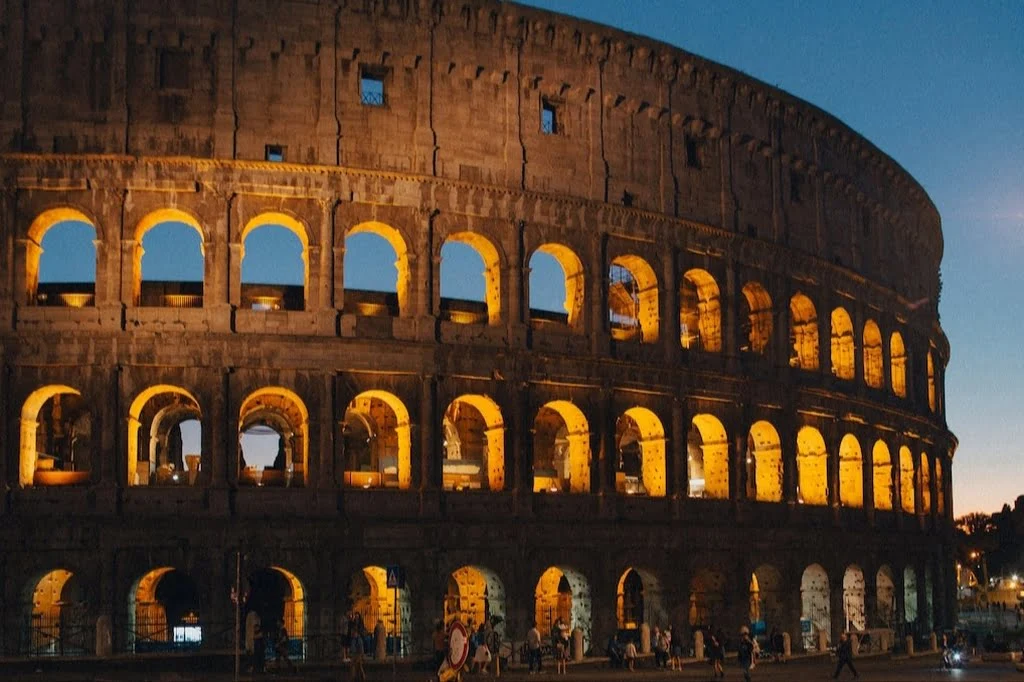
A self-guided tour of the Colosseum and Roman Forum is an excellent opportunity to learn about Rome’s ancient history. But before that, learn some fun facts about the Colosseum before you go!
Here’s a route suggestion:
• Begin at the Colosseum
Right. The magnificent amphitheater where gladiator combat and other performances were formerly held.
To prevent long lineups, buy your tickets in advance.
• Explore its levels
Explore the numerous levels of the Colosseum, including the underground chamber where gladiators and animals were held before the festivities.
• Exit the Colosseum
…. and then proceed to the Arch of Constantine. It’s a triumphal arch built to commemorate the emperor’s victory in the Battle of Milvian Bridge.
• Walk toward the Roman Forum
From the Arch of Constantine, walk toward the Roman Forum – a large collection of ruins that was once the center of political and social activity in ancient Rome.
• Explore the Forum
The Roman Forum features the Temple of Julius Caesar, the Basilica of Maxentius and Constantine, and the Temple of Saturn. It will be a fun exploration!
• Walk up Palatine Hill
Palatine Hill is one of Rome’s seven hills. Walk up there from the Forum and see the ruins of the imperial palace and other historic structures.
• Take in the views
Enjoy stunning views of Rome from Palatine Hill before returning to the Forum.
• Visit the Capitoline Museums
Finish your self-guided tour by visiting the Capitoline Museums, which house an extensive collection of ancient Rome art and artifacts.
2. The Spanish Steps, the Trevi Fountain, and The Pantheon

The Spanish Steps and the Trevi Fountain are two of Rome’s most famous attractions, and a self-guided tour of them is an excellent way to see them.
Depending on how long you linger at each location, this self-guided stroll could take anywhere from three to four hours.
Here’s a possible tour plan:
• Climb the Spanish Steps
The famous Spanish Steps may be found in Piazza di Spagna, your first stop in Rome. The views of Rome from the top of the hill are well worth the 135 steps it takes to get there.
• Check out the Trinita dei Monti
The Trinita dei Monti is a gorgeous Renaissance church located at the top of the Spanish Steps.
• Visit the Trevi Fountain
Trevi Fountain is one of the most well-known fountains in the world. You can visit it by descending the Spanish Steps. There’s a myth that if you toss a coin into the fountain, you’ll be back to Rome someday.
• Enjoy the beautiful intricacies of the fountain
Admire the details of the Trevi while you toss a coin or two into the water.
• Walk toward the Pantheon
From the Trevi Fountain, resume your walking and reach the Pantheon, which is an old temple turned Christian church.
• See the tombs of famous people
Visit the Pantheon to see the tombs of notable artists and scientists as well as the majestic dome.
• Make your way to Piazza Navona
To see a majestic Baroque church and three beautiful fountains, Piazza Navona is the place to be!
• Eat at a trattoria
Stop by one of Piazza Navona’s many eateries for a break and some authentic Italian fare.
• Take a stroll through the historic district
To round out your independent tour, take in the area’s stunning architecture while you browse the unique stores.
3. The Vatican Museums and St. Peter’s Basilica

Embark on your journey at the Vatican Museums, where you will discover the ancient abodes of the Popes and the awe-inspiring Sistine Chapel! And then, the following:
• Visit the Borgo Pio
The Borgo Pio is a neighborhood where numerous Popes and notable Romans once owned magnificent abodes.
• Take in the magnificent sight of St. Peter’s Square and St. Peter’s Basilica
St. Peter’s Square is a large plaza that dates back to the 17th century. St. Peter’s Basilica is Vatican City’s most recognizable landmark. Together, they attract millions of tourists annually.
• Check out the papal tombs
The Basilica boasts the resting places of esteemed Popes of yore, while its Square stands out as one of the most bustling in the world, particularly during Mass and noteworthy Catholic occasions.
• Walk on the Passeggiata del Gelsomino
Nestled within Vatican City lies a captivating gem known as the Passeggiata del Gelsomino. This enchanting pathway spans a remarkable 300 meters and is situated atop a former railway network, adding to its allure.
• Stroll down Via Della Conciliazione
You simply must take a stroll down Via Della Conciliazione! It’s a grand boulevard that will lead you straight to the majestic Tiber River.
• Head to the Castel Sant’Angelo
Furthermore, the path will guide you toward Castel Sant’Angelo, a magnificent fortress constructed during the 2nd century under the reign of Emperor Hadrian.
• Stop by the Ponte Sant’Angelo
The stroll culminates at the Ponte Sant’Angelo (St. Angelo Bridge), which is adorned with a stunning array of ten angelic statues gracing each side of the bridge.
• Take pictures of the Santo Spirito district
This marks the end of your stroll and an exceptional location to capture stunning snapshots of the Santo Spirito district, which according to folklore, is believed to be the birthplace of Rome.
4. The Appian Way and the Catacombs

The historic Appian Way, one of the most significant thoroughfares in ancient Rome, is traversed on this hike; while the catacombs are underground cemeteries from the first century that anyone can visit.
Here’s your walk plan.
• Start at the Porta San Sebastiano
Get going at the historic gate of Porta San Sebastiano in the Aurelian Walls. It’s accessible through Metro Line A’s San Giovanni stop; from there, take Bus 218 to the entrance.
• Walk down the Appian Way
Take a stroll down the pedestrian-only Appian Way to see some ancient tombs, mausoleums, and ruins.
Along the journey, you’ll pass by the Circus Maximus and the Tomb of Cecilia Metella.
• 3 kilometers later, you’ll be at Catacombs of San Callisto
The Catacombs of San Callisto, one of the largest and most significant Christian catacombs in Rome, can be found after around 3 kilometers. The underground tombs, decorated with frescoes and inscriptions, are accessible via guided tour.
• Reach the Catacombs of San Sebastiano
The Catacombs of San Sebastiano can be reached by carrying on down the Appian Way. Although smaller than San Callisto, the Catacombs of San Sebastiano are also worth exploring.
The Basilica of San Sebastiano, a stunning basilica constructed atop the catacombs, is well worth a visit.
• Head back to Porta San Sebastiano
You can go back to Porta San Sebastiano from the Catacombs of San Sebastiano by taking a bus or a taxi, or you can walk there.
5. Trastevere and the Jewish Ghetto

This stroll takes you through both the hippie enclave of Trastevere and the ancient Jewish quarter of the Ghetto.
• Start your walk at the Piazza Trilussa
The Piazza Trilussa in Trastevere is the place to begin. From downtown, use Tram 8 or Bus H to get there.
• Follow the signs for Piazza Santa Maria
The signs in Trastevere will guide you as you make your way down the Viale di Trastevere. The gorgeous mosaics and beautiful fountain at this ancient cathedral have made it a Roman landmark for centuries.
• Cross the Tiber River
You may access the Ponte Sisto from the Piazza Santa Maria in Trastevere through della Scala. Crossing the Tiber on foot is a breeze thanks to this stunning bridge.
• Cross the Ponte Sisto to reach the Via del Portico d’Ottavia
You may reach the Via del Portico d’Ottavia after crossing the Ponte Sisto. There are several places to eat and shop along this main thoroughfare of the Jewish Ghetto.
• Visit the Jewish Ghetto
This Jewish Ghetto is the site of one of Europe’s earliest Jewish settlements. The largest Italian synagogue, the Synagogue of Rome, is among the many historic sites you’ll visit.
• Walk back to Trastevere
Make your back to Trastevere from the Jewish Ghetto to see the Basilica di Santa Cecilia. Dedicated to the patron saint of musicians, this church features stunning mosaics and frescoes.
• End your tour at the Piazza di Santa Maria
Your tour should conclude at the Piazza di Santa Maria in Trastevere, where you may choose from numerous excellent dining and drinking establishments.
6. The Aventine Hill

One of Rome’s seven hills, the Aventine is another excellent route for a self-guided walk. The old church of Basilica di Santa Sabina, as well as its lovely gardens and panoramic vistas of Rome, are well worth a visit.
Take a look at the suggested route below.
• Start at Piazza dei Cavalieri di Malta
Get your bearings at the Piazza dei Cavalieri di Malta, the site of the famed keyhole. The closest Metro stop is Circo Massimo on Line B, and from there it’s a 10-minute walk.
Peer through the keyhole and take in the stunning St. Peter’s Basilica dome.
• Walk on the Via di Santa Sabina
Follow the signs for Piazza Pietro d’Illiria down the Via di Santa Sabina. The Peter the Great statue in the middle of the square gives the plaza its name.
• Visit the Basilica of Santa Sabina
One of the oldest churches in Rome, the Basilica of Santa Sabina is worth a visit for its ornate murals and wooden doors.
• Make your way along the Via di Santa Prisca
Follow the signs for Piazza degli Cavalieri di Rodi as you make your way along the Via di Santa Prisca. The Grand Master of the Knights of Malta resides in this square in the Villa del Priorato di Malta.
• Stop by the Giardino degli Aranci
Giardino degli Aranci is a gorgeous garden with breathtaking panoramas of Rome. You may easily reach the Orange Garden, or Parco Savello, on foot. The orange trees and fountains in this park are legendary.
• Conclude your stroll at the Circo Massimo
The old Roman chariot racing stadium Circo Massimo is where you should finish your stroll. Discover the significance of this historical monument by exploring the remains.
7. The Janiculum Hill

This walk takes you through the Janiculum Hill, also known as the Gianicolo.
You can explore the beautiful gardens, the stunning views of Rome, and the Fontana dell’Acqua Paola, which is a beautiful Baroque fountain.
• Start at the Piazza Garibaldi
Piazza Garibaldi is a square dedicated to the Italian national hero Giuseppe Garibaldi. You can reach it by taking the Tram 8 from the city center.
• Walk up the hill toward the Piazzale Giuseppe Garibaldi
Piazzale Giuseppe Garibaldi is a large terrace that offers stunning views of Rome.
• Walk to the Fontana dell’Acqua Paola
From the Piazzale Giuseppe Garibaldi, walk to the Fontana dell’Acqua Paola. It is a beautiful fountain that was built in the 17th century.
• Walk down the Via di San Pancrazio
Keep walking until you reach the Villa Sciarra, which is a beautiful park that offers stunning views of Rome and is home to a historic villa.
• Walk to the Basilica di San Pietro
From the Villa Sciarra, walk to the Basilica di San Pietro in Montorio, which is a beautiful church that is known for its stunning courtyard and chapel.
• Walk to the Tempietto del Bramante
The Tempietto del Bramante nearby is a small temple that was built in the 16th century and is considered a masterpiece of Renaissance architecture.
• Conclude your walk at the Piazza della Madonna dei Monti
Your stroll ends at the Piazza della Madonna dei Monti, which is a charming square in the Monti neighborhood that is known for its beautiful church and lively atmosphere.
8. The Borghese Gallery and Gardens

This tour takes you through the Borghese Gallery and Gardens, one of Rome’s most renowned art galleries. You can examine the many artworks, which include Bernini sculptures and Caravaggio paintings.
• Begin at the Piazzale del Museo Borghese
The Piazzale del Museo Borghese serves as the gallery’s entrance. You can get there by taking Metro Line A to Spagna and then walking for around 10 minutes.
The Borghese Gallery houses an extraordinary art collection, including paintings by Caravaggio, Bernini, and Raphael. Tickets must be purchased in advance, as the entrance is limited to a set number of guests per day.
• Proceed to the Giardino del Lago
After touring the gallery, take a stroll to the nearby Giardino del Lago, a lovely lake surrounded by trees and flowers.
• Check out Villa Borghese
Walk to the neighboring Villa Borghese gardens, which are one of Rome’s largest parks. The gardens provide a calm respite from the city’s hustle and bustle.
• Visit the Temple of Aesculapius
This a modest temple on an island in the center of a lake dedicated to the Roman god of medicine.
• Walk to the Pincio Terrace
The Pincio Terrace has beautiful views of Rome and is famous for romantic walks.
• Finish your tour at the Piazza del Popolo
End your walk at one of Rome’s most renowned squares. Piazza del Popolo is home to several significant monuments, including the Egyptian obelisk and the twin churches of Santa Maria dei Miracoli and Santa Maria in Montesanto.
9. The Tiber River

Tiber River flows right through the center of Rome and is the third longest river in Italy. You can learn a lot about the city’s past and present simply by taking a stroll along the river.
Depending on how long you linger at each location, this self-guided stroll could take anywhere from three to four hours. If you’re going to be wandering around during the warmer months, make sure to pack some water and sunscreen.
To get where you need to go, try the following steps:
• Start at the Ponte Sant’Angelo
Ponte Sant’Angelo is a stunning bridge designed by Bernini and adorned with ten angel statues. Castel Sant’Angelo, a stronghold constructed by Emperor Hadrian, is visible in the distance.
• Take the Sassia route of Lungotevere
This route will take you all the way to the Vatican. You’ll see the famous Ponte Vittorio Emanuele II and the historic Palazzo di Giustizia.
• Head to Piazza del Popolo
To reach Piazza del Popolo, a vast area housing an Egyptian obelisk and two baroque churches, you must first cross the Ponte Principe Amedeo Savoia Aosta bridge.
• Walk along Via del Corso to Piazza Venezia
You may reach Piazza Venezia from Piazza del Popolo by taking a stroll along Via del Corso, which takes you through the stunning Piazza di Spagna and the Trevi Fountain.
When you get to Piazza Venezia, don’t forget to stop and take in the Altare della Patria, a colossal monument honoring Italy’s unification.
• Reach the Ponte Fabricio
If you keep walking down Lungotevere de’ Cenci, you’ll eventually come to Rome’s oldest bridge, Ponte Fabricio. Float over to the little island of Isola Tiberina in the middle of the Tiber.
Take in the sights of the river and the nearby buildings as you stroll around the island.
• Get to Trastevere
Trastevere is a bohemian district with narrow alleyways and charming eateries; to get there, you’ll need to cross the river again at Ponte Sisto and go along Lungotevere dei Tebaldi.
• Eat and rest at a trattoria
After your stroll, stop by one of Trastevere’s many trattorias for a great lunch and a drink of wine.
Tips When Doing Self-Guided Walks in Rome

Here are some suggestions to help you get the most out of your self-guided walks in Rome:
Do some research on the sights and places you wish to see in Rome before beginning your self-guided tour. Make a list of places you wish to see and map out a path that works for you.
• Download a map or guide
It’s not hard to get disoriented in such a large city as Rome. To assist you in navigating the city, you can either utilize a gadget that is equipped with GPS or download a map or guide of the area.
• Wear comfortable shoes
Since you’ll be walking quite a bit, you should be sure to choose comfy shoes. Bring a hat, some sunscreen, and a water bottle with you, and make sure you are prepared for the weather.
• Plan your route
Create a route using the information you’ve gathered and the map. Think about how much time and how far you’ll have to go between each landmark. Give yourself plenty of time to see everything and take breaks if you need them.
• Stay hydrated
When visiting Rome, especially during the months of summer, it is important to remember to pack enough water with you so that you can keep hydrated while walking around the city.
• Take your time
Since Rome is a city that has a lot to see and discover, it is important to take your time on your self-guided walks. Take your time to explore the city and take in all of its sights and sounds.
• Try the local cuisine
Enjoy some of Rome’s world-famous cuisine on your strolls through the city. Traditional Roman foods such as pasta alla carbonara, cacio e pepe, and suppli should not be missed.
• Explore neighborhoods
Trastevere and Monti are only two of the numerous interesting districts of Rome. Spend some time just wandering about and soaking up the atmosphere.
• Be respectful
The city of Rome is rich in heritage and tradition. Treat locals and buildings with the courtesy they deserve. Visit holy locations while dressed correctly, and don’t make too much noise in residential neighborhoods.
• Stay safe
Even though Rome is generally a secure city, you should always be alert to your surroundings and take measures to safeguard both yourself and your things.
A self-directed stroll through the charming streets of Rome presents a unique chance to discover the city’s hidden gems at your leisure. Savor the moment, relish in the beauty of your surroundings, and fully immerse yourself in this unforgettable experience.
Final Thoughts

A self-guided walk in Rome is a delightful and fulfilling approach to immerse oneself in the city’s charm. If you have time and are physically fit, you should explore the Eternal City through walking.
By strategizing ahead, donning comfy footwear, and embracing your inner explorer, you can relish the breathtaking vistas and captivating melodies of Rome on your own accord.
If you’re visiting Rome and need a place to stay, check out our list of the best Rome hotels here. The Italian capital has a wide range of dining options, so make sure to check out the best restaurants and gelato shops in the city . Rome also offers a slew of halal and vegan restaurants .
Before leaving the Eternal City, be sure to buy the best Rome souvenirs to bring home with you as keepsakes of your trip!
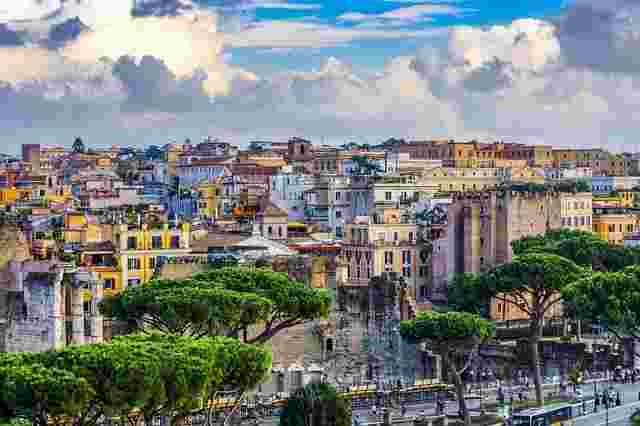
Rome Walking Tour, 15 Self Guided Tours with Map and Attractions
Use the Rome google map below to visit the attractions in the historic city center. The map is a complete self guided Rome walking tour map and guide to historic Rome attractions, including Towers, Squares, and Cathedrals. Follow the walking route on the interactive map to explore Rome at your own place. Spend a few hours or a full day depending on how long you want to spend at each attraction.
Click on the arrow icon to the left of the title to display the legend. Click on the Rome attractions map pins (green, red, brown, purple or blue pins) or on the legend (left icon on the title bar) or the PDF map that you download for additional information including images of the attractions. Each set of colored map pins can be used as a separate walking self guided route making it flexible to work into your schedule of other planned events or lunch breaks
For accompanying Rome attractions guide click HERE
To download pdf of rome attractions map click here, click on image of map for rome attractions guide.
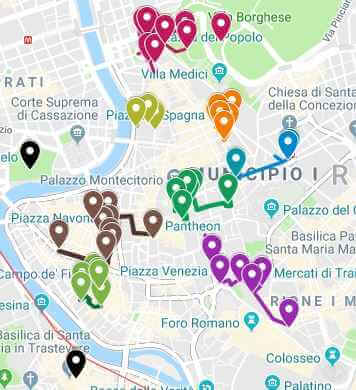
Interactive Rome Walking Tour map for as follows:
Each separate color on the interactive Rome Walking tour represents a different area in historic Rome. You can complete the self guided walking tour in one day or spread it over several days depending on the area of historic Rome you want to explore.
- Piazza del Popolo can be accessed by taking Metro line A and exiting at Flamino station. Explore Piazza del Popolo then climb the stairs to the Pincio Hill garden. From here, the Borghese Gardens are a 10 minute walk. Villa Borghese is immense and has nine different entry points (including from the top of the Spanish steps).
- Rome Walking Tour 2 : In dark grey color on the interactive attractions map above you will find attractions in the area of the Villa Borghese Gardens . The gardens are 80 hectares of beautifully landscaped park. There are numerous walking trails including options to rent a bike. Stop by at one of the cafes for lunch or have a picnic in the designated areas. Attractions include Villa Giulia , Museo Carlo Bilotti , Borghese Gallery and Museum , Shakespeare Globe Theater , the Water Clock and countless statutes, sculptures, squares, and Bioparco di Roma Zoo
- Rome Walking Tour 3 : The orange colored attractions map is centered on the Spanish Steps. On the interactive map, attractions are located around the Spanish Steps ( Piazza di Spagna ) . In this are of historic Rome, there several attractions including the famous Spanish Steps leading to the grand palace Palazzo di Montecitorio, the famous S panish Steps , and the popular Barcaccia Fountain . The Piazza Mignanelli is located next to the Piazza di Spagna.
- Rome Walking Tour 4 : The Lime (light green) attractions map has attractions related to the Emperor Augustus . This includes the Emperor Augustus Mausoleum and the intricately carved Altar
- From the Monuments of Emperor Augustus, it is a quick walk to Piazza Barberini , your next stop on the Rome attractions map. This is indicated by the color blue on the interactive map. Attractions in this area include the Bernini Fountains
- Rome Walking Tour 5 : The dark green on the interactive attractions map of Rome is the area in and around the famous Trevi fountain. Attractions include the Palazzo di Montecitorio and the Temple of Hadrian
- Rome Walking Tour 6 : The next set of attractions in the historic city are shown in dark brown on the interactive walking tour of historic Rome. Here you will find the Piazza Navorone , a public open space and what was the home of the Stadium of Domitan. Attractions such as the fountains, statutes and palaces are located in this square
- Rome Walking Tour 7 : The light green walking tour on the interactive map is the Piazza Campo de’Fiore . Campo de’ Fiori means “field of flowers” and describes how the landscape looked in the middle ages. The Piazza is just south of Piazza Navarone. In ancient Rome this land was undeveloped and eventually the Santa Brigida Church was built. Just south of the square the Palazzo Farnese was constructed. The palace was an imposing Italian palace when it was built for the prominent Farnese family in the 16th centaury. Eventually the square itself became the commercial center of Rome and the streets were named after the trades such as Via dei Baullari (coffer-makers), Via dei Balestrari ( crossbow -makers), Via dei Giubbonari (tailors), Via dei Cappellari (hat-makers), and Via dei Chiavari (key-makers).
- From Campo de’Fiore” head over to Largo di Torre Argentin . Largo di Torre Argentin is a square that includes a Square with Porticos. Colonnades, Curia, Roman Temples, the remains of Pompey’s theater and the place where Julius Caesar was murdered. He was assassinated in the Curia of Pompey. Excavation of this area began in 1929
- Rome Walking Tour 8 : The next stop on the Rome Walking tour is the attractions around the historic center of the ancient City of Rome. Attractions include Trajan’s Column, Trajan’s Market and Trajan’s Form . In the area is Palazzo Napoleon’s including the apartment he occupied while in Rome
Additional Rome Walking Tours:
- Self guided tour 9 will take you to the Roman Colosseum. Click on the Roman Colosseum attractions map HERE and accompanying Colosseum attractions guide HERE
- Rome attractions map and self guided tour 10 includes the Vatican City attractions map HERE and the Vatican attractions guide HERE
- Self Guided Walking tour 11 , explore the neighborhood of Trastevere with map of attractions HERE and guide of attractions HERE
- The 12th walking tour is of St Peters Basilica . Explore all the attractions in St Peter’s Basilica with the attractions guide HERE
- One of my favorite trips is that of the Roman Forum and Palatine Hill . The map of attractions is HERE and the self guided walking tour is HERE
- Visit Pompeii with a complete self guided tour map HERE and the attractions guide to the 49 points of interest HERE
- Spend the day in Florence , this was by far one of my best day trips. The self guided walking tour map is HERE and the attractions guide is HERE
Instructions to download the interactive map to a smart phone:
Take the map with you when you travel:.
Instructions on:
- Using it offline
- Using it online – We bring one of our older smart phones when we travel and buy a local SIM card. You can purchase a local tourist SIM card from one of the main local providers, they are usually pretty inexpensive. You may need your passport to purchase as its a tourist SIM if you are an international tourist. You should have them put it in your old smartphone and check that it works before leaving the store. Use it to follow the map online, its the best way to explore
Sign into google using your Gmail account on your smart phone and be connected to the internet. If you do not sign in, this process will not work . You will be downloading this map to save it. You will be saving it in google maps in two places:
- Save in “Your Places” for online use and
- Save in “Offline map” for offline use
- Youtube instructions on link as follows: https://youtu.be/_6j9koieMsU
Instructions to save above map:
- Click on the rectangle on the top right hand side of the above map [ ] – if you move your mouse to it, it will say “view larger map”
- It will take you into google maps on your smartphone and it will automatically save this map. You must be already be signed into google maps with your Gmail account, if you are not signed into google maps then the map will not be saved
- In google maps, click on the menu which is the three horizontal lines on the top left of the google map (it is to the left of the search box)
- From the menu, click on “Your Places”. This will take you to another screen with a menu at the top. From the top menu bar select “maps”. A list of your maps will be displayed including the map that was just saved. Select the map you just saved
- Make sure the map is still onscreen; do not close out of it as you will be downloading this map and it has to be onscreen to download. While the map is onscreen, click on menu again (three horizontal lines top left hand corner)
- Select “Offline maps” then select “custom map”
- Once you select “custom map”, the onscreen map will be displayed; select the area you want downloaded (zoom in or out to get all the data points into the blue square outline; pinch fingers for zooming)
- Click on “download” – this will save the map in an offline area that you can use when you are not connected to the internet
The map is now saved in two places. To see this, click on the menu (three horizontal line on top right hand corner) in google maps:
- Click on “Your Places” from the menu, then select “Custom Map”. The map will be listed and you can use the map while connected to the internet
- Click on “Offline Maps” from the menu. The map will be listed to use the map offline ie: not connected to the internet (make sure location services is turned on and your will see the blue dot indicating your location as you navigate with the offline map)
- After you download a map, use the Google Maps app just like you normally would. If your Internet connection is slow or absent, or if you are in “airplane mode” Google Maps will automatically use your offline maps to give you directions
- Skip to main content
- Skip to primary sidebar
- Skip to footer

Italy Travel Experts Tours and Vacations
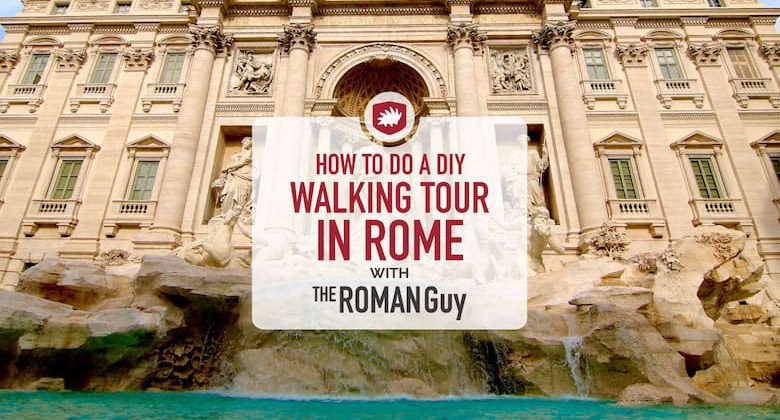
How to do a Self-Guided Walking Tour of Rome: 2 hours
Sean Finelli Last Updated: November 18, 2022
If you don’t have tons of time to spend in Rome, you should still knock out the city’s main sites. Here’s how to do a quick DIY walking tour of Rome featuring Il Pincio, Piazza del Popolo, the Spanish Steps, Piazza Navona, Trevi Fountain, and Pantheon. So, enjoy Rome with this walking tour itinerary and maps.
DIY Walking Tour of Rome Itinerary
This itinerary covers the major spots in Rome that you can see without a guided tour. We’ll guide you from location to location, giving you options that will help you have a personalised experience of Rome. Read on to find the routes with bustling streets, great views, or ways to conserve energy.
If you’re planning to see the Vatican and Colosseum, we highly recommend our Rome in a Day Tour that not only includes the sites mentioned below but also gets you skip-the-line access to the Vatican and Colosseum.
Start this walking tour at either Piazza Navona or Il Pincio / Piazza del Popolo. I highly recommend taking a taxi to Il Pincio, which is in Villa Borghese over top of Piazza del Popolo. You can walk there or get pretty close by metro, but we recommend getting a taxi up to the top so you can walk downhill for the rest of this journey. Trust us, you’ll have plenty of opportunities to exercise in Rome, so conserve your energy wherever you can. Here’s your self-guided itinerary:
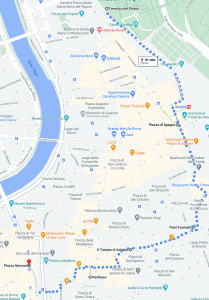
- Il Pincio and Piazza del Popolo
- The Spanish Steps, Piazza di Spagna, and Via Condotti
- The Trevi Fountain
- The Pantheon
- Piazza Navona
Distance: 1.5 miles (2.5km)
Walking Time : 30 minutes
Total Duration: 90 minutes to 2 hours
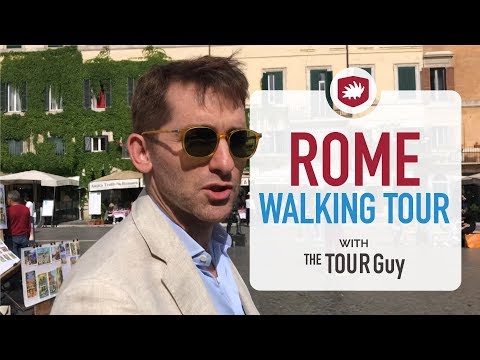
1. Il Pincio and Piazza del Popolo
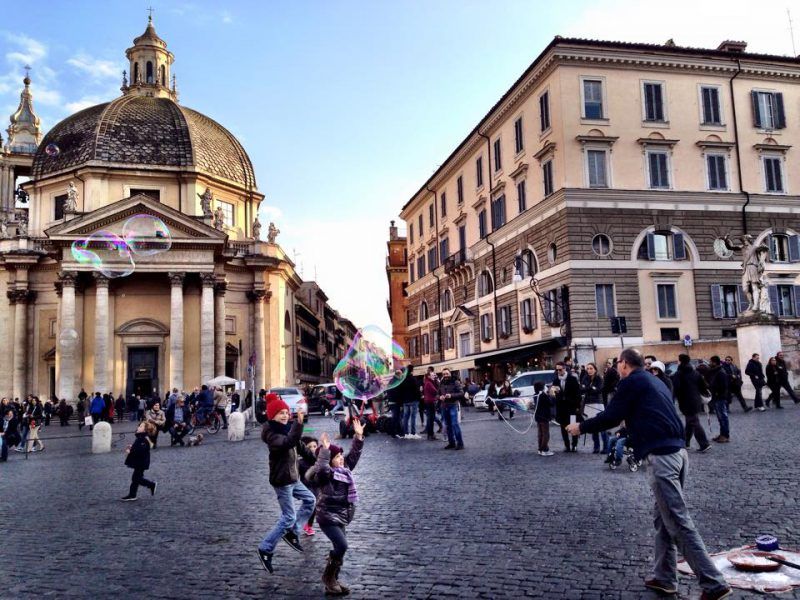
Terrazza del Pincio is one of those places you see all over social media but can’t actually find when visiting Rome. Good news, we’ve got you covered, and it’s actually very easy to get to. Go to Piazza del Popolo (Piazza of the People) and look for the big hill. Hidden behind the street leading up the hill is a staircase going up to Il Pincio.
Il Pincio is on the outskirts of Villa Borghese. You can start in Villa Borghese and make your way down to Piazza del Popolo or the opposite. Piazza del Popolo is a 10-minute walk from the Spanish Steps, from there it’s 10 minutes to Trevi Fountain, another 10 minutes to the Pantheon, which is 10 minutes from Piazza Navona, and so on. While you’re in the area, check out the top things to see near Piazza del Popolo .
2. Spanish Steps
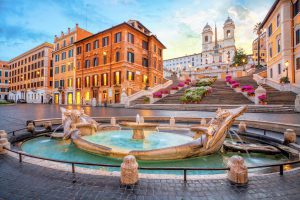
From Pincio to the Spanish Steps, you have two options. The first is to walk down from Il Pincio into Piazza del Popolo. This is the best option if you want to walk through Rome’s bustling streets.
Your second option is to walk down viale della Trinità dei Monti. This road is situated above the neighborhood and slowly slopes downward. You get a great view of the area without the crowds. Take a peek into the terraces of the Roman elite and, best of all, you’ll arrive at the top of the Spanish Steps.
As you approach the Spanish Steps , you’ll notice that you’re walking into Rome’s posh shopping district lined with high-end designers and brands. You’ll come to a large staircase leading up to the Trinita dei Monti church.
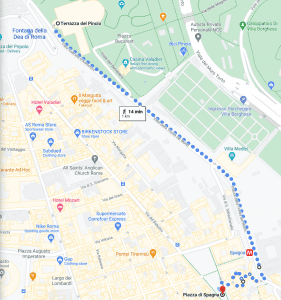
So why are they called the Spanish Steps if we’re in Italy? The Spanish Steps aren’t actually Spanish at all. They got their name because the Spanish Embassy to the Holy See is located at the base of the steps.
The official name of the steps is actually Scalinata dei Trinita dei Monti. At the base of the steps, you’ll find another one of Rome’s beautiful fountains, Fontana della Barcaccia, or Fountain of the Longboat.
If you take time to explore the area, you might notice the Keats-Shelley House, located right at the foot of the Steps. This museum commemorates iconic English romantic poets Jonathan Keats and Percy Bysshe Shelley, and houses countless poems, manuscripts, and other works by these authors. Check out the top things to see near the Spanish Steps .
3. Trevi Fountain
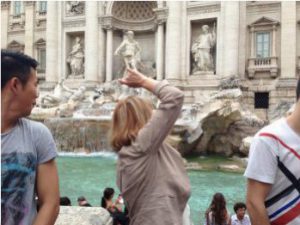
Above, you’ll see a map of the route we suggest taking from the Spanish Steps to the Trevi Fountain, which should take about 10 minutes. When you reach Piazza di Trevi, you’ll probably notice a large crowd of people taking the classic coin throw picture in front of the fountain.
Built in 1762 and designed by Nicola Salvi, Trevi Fountain or Fontana di Trevi translates to “Three Street Fountain.” Quite literally, the fountain is located where three roads meet and what used to be the end point of one of Rome’s earliest aqueducts.
The fountain depicts ancient Greek god Oceanus on a chariot being pulled by two horses. One is obedient and one is resistant, symbolizing the changing tides of the ocean.
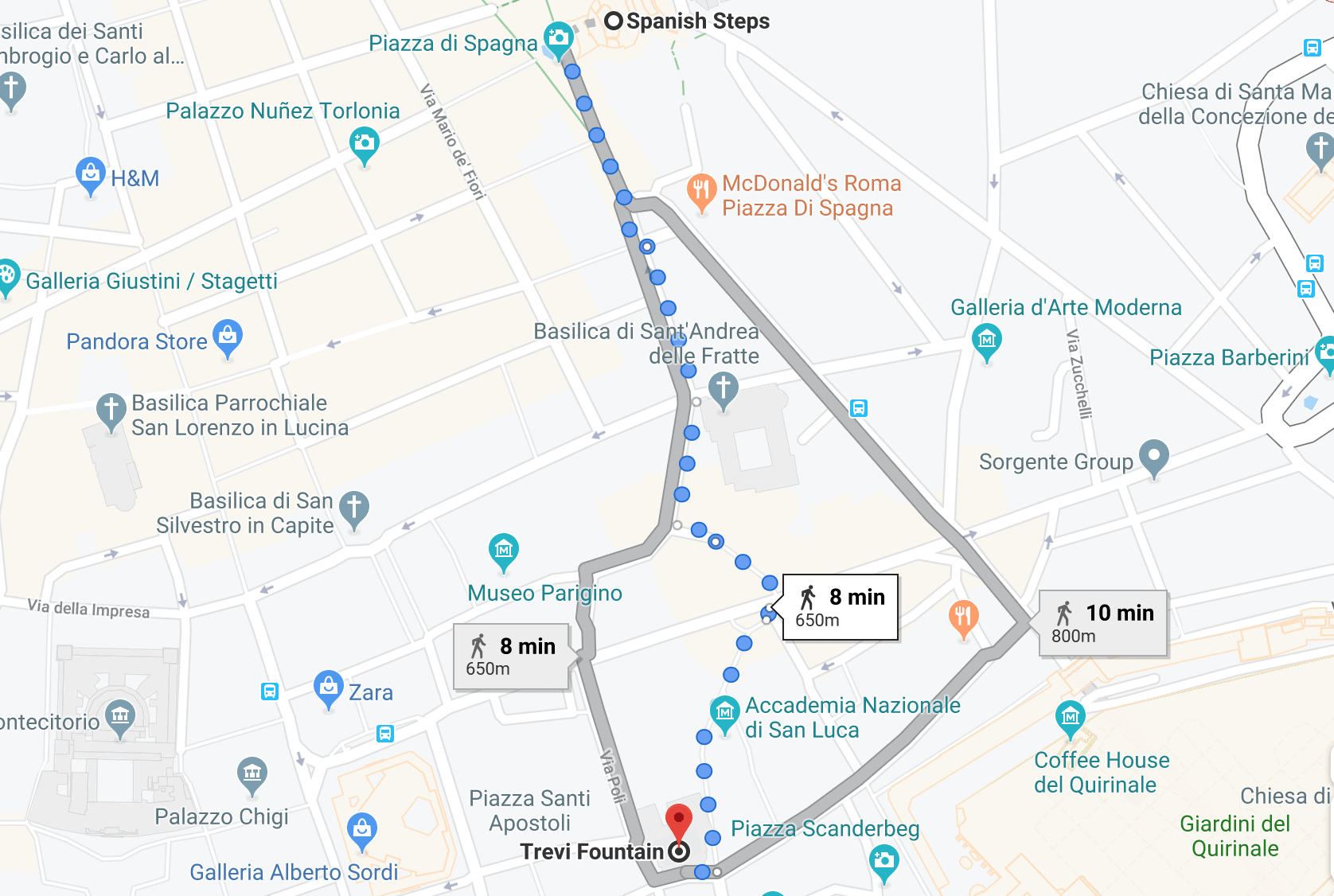
Legend has it that if you throw a coin into the fountain with your right hand over your left shoulder, you will return to Rome again. If you throw two, you’ll soon have a new romance in your life. And if you throw three, you’re guaranteed to get married. Since you’re here, check out the top things to see near Trevi Fountain .
4. Pantheon
You can follow this simple route to reach the Pantheon, which is about a seven-minute walk away.
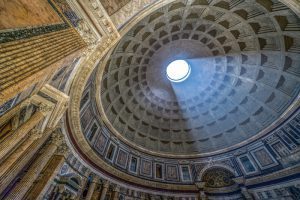
The Pantheon is typically considered Rome’s most well-preserved ancient building. This makes sense since the first two structures that stood in the Pantheon’s place were destroyed—one by the Great Fire of Rome and the other by lightning. When Emperor Hadrian built the third, he made sure it was extremely structurally sound.
We definitely recommend going inside the Pantheon to explore its beautiful rotunda. If you look up, you’ll notice an opening in the ceiling allowing sunlight in called the oculus.
The Pantheon is free to enter, and there is plenty to see inside. After exploring its Greco-Roman architecture from the outside, make sure you see Raphael’s tomb when you enter. If you have time, check out the top things to see near the Pantheon .
5. Piazza Navona
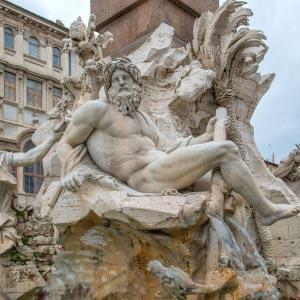
After exploring the Pantheon, walk four minutes away using this route to explore Piazza Navona.
The Piazza Navona is an incredibly beautiful square in the center of Rome lined by delicious eateries and shops. It sits on top of what used to be the Stadium of Domitian, where gladiatorial games and public executions used to take place in ancient Rome.
Built around A.D. 80, the Stadium of Domitian even served as a replacement venue for the Colosseum when it was struck by lightning in A.D. 217. The restaurants and storefronts that line the Piazza Navona today still preserve the shape of the ancient running track and all of the buildings surrounding the piazza were built atop the stadium’s seating.
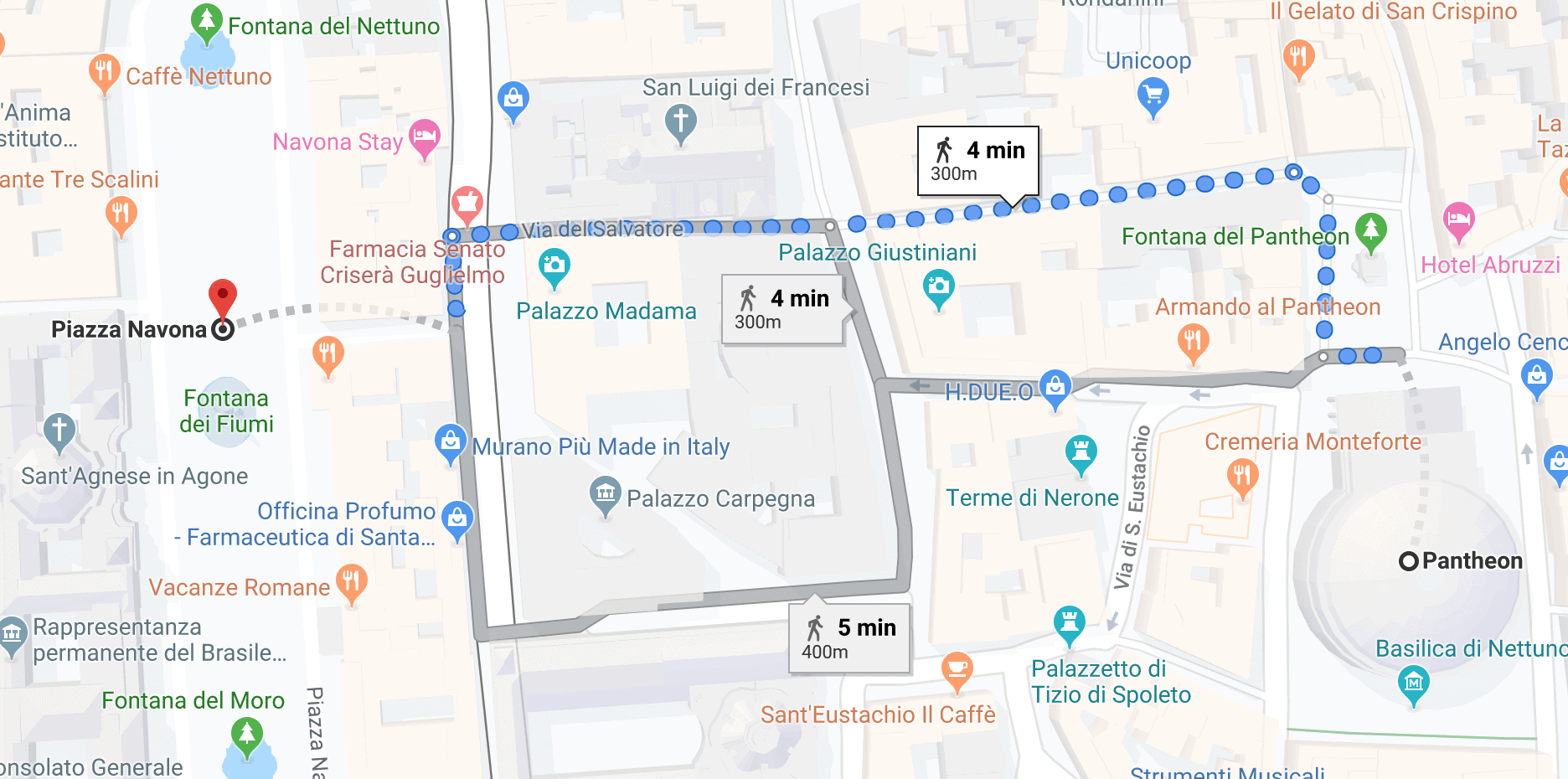
In the center of the Piazza Navona, you’ll notice a large obelisk with ancient hieroglyphs inscribed on its stone. Although originally located in Circus Maxentius, the obelisk now stands atop the Fountain of Four Rivers and features inscriptions that mention Emperor Domitian. Discover the top things to see near Piazza Navona .
By now, you’ll have worked up quite an appetite.
Finish With A Trastevere Food Tour
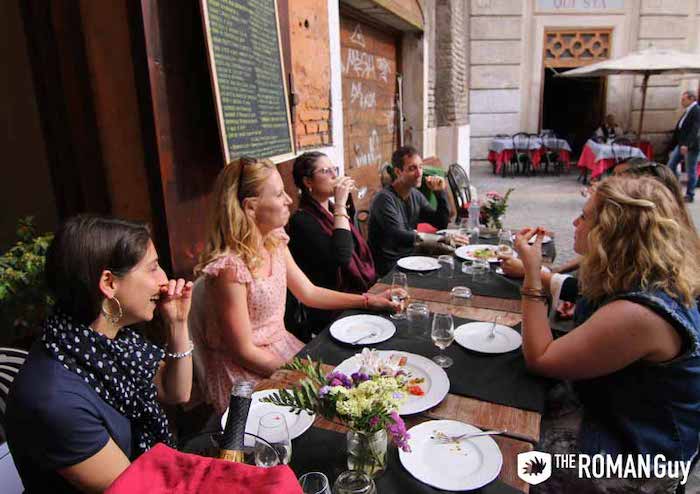
There’s really no better way to end your DIY walking tour of Rome than with a great meal! While there are plenty of restaurants and bars lining the piazza, we recommend joining our Trastevere Food Tour .
It meets just a few minutes away from Piazza Navona and features fantastic Rome street food and a traditional sit-down dinner, giving you a culinary experience that offers a more local take on the city’s cuisine.
Not ready to book a tour? Check out our guide to all things Rome as you plan your trip.
Here’s Where To Stay in Italy’s Most Popular Destinations
Rome , Florence , Venice , Amalfi Coast , and Capri
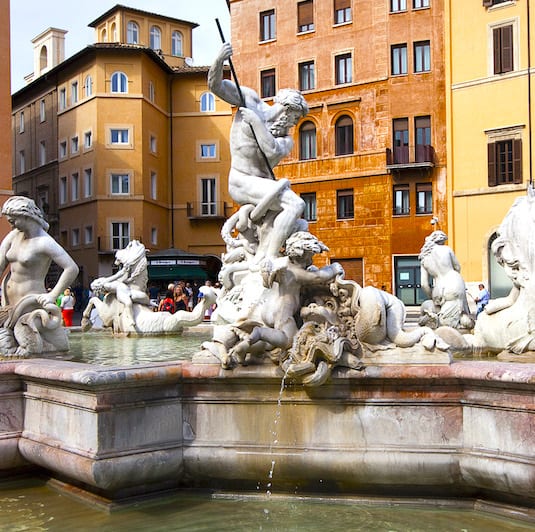
Best Hotels & Where to Stay
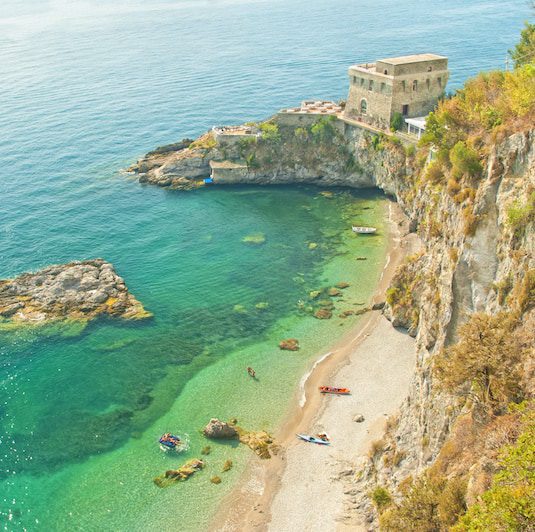
Reader Interactions
Leave a comment cancel reply.
Your email address will not be published. Required fields are marked *
- In The Press
POLICY & TERMS
- Cancellation Policy
- Terms & Conditions
- Privacy Policy
Black Friday: Up to 15% off selected tours
Prices shown include discount | Offer ends November 28th at 11:59pm PST
Home / Blog / Destination / Italy / Rome / Rome in a Day: Ultimate Self-Guided Walking Tour of Rome
Rome in a Day: Ultimate Self-Guided Walking Tour of Rome
Rome is a city with thousands of years of history, all layered together and visible in its stunning monuments, buildings and neighborhoods. The historic center in particular is full of things to do and see, and luckily they’re all within walking distance of one another. And even if you’ve only got one free day to explore the Italian capital, we’ve got you covered. This self-guided walking tour of Rome will help you hit all the main monuments and areas in just a few hours.
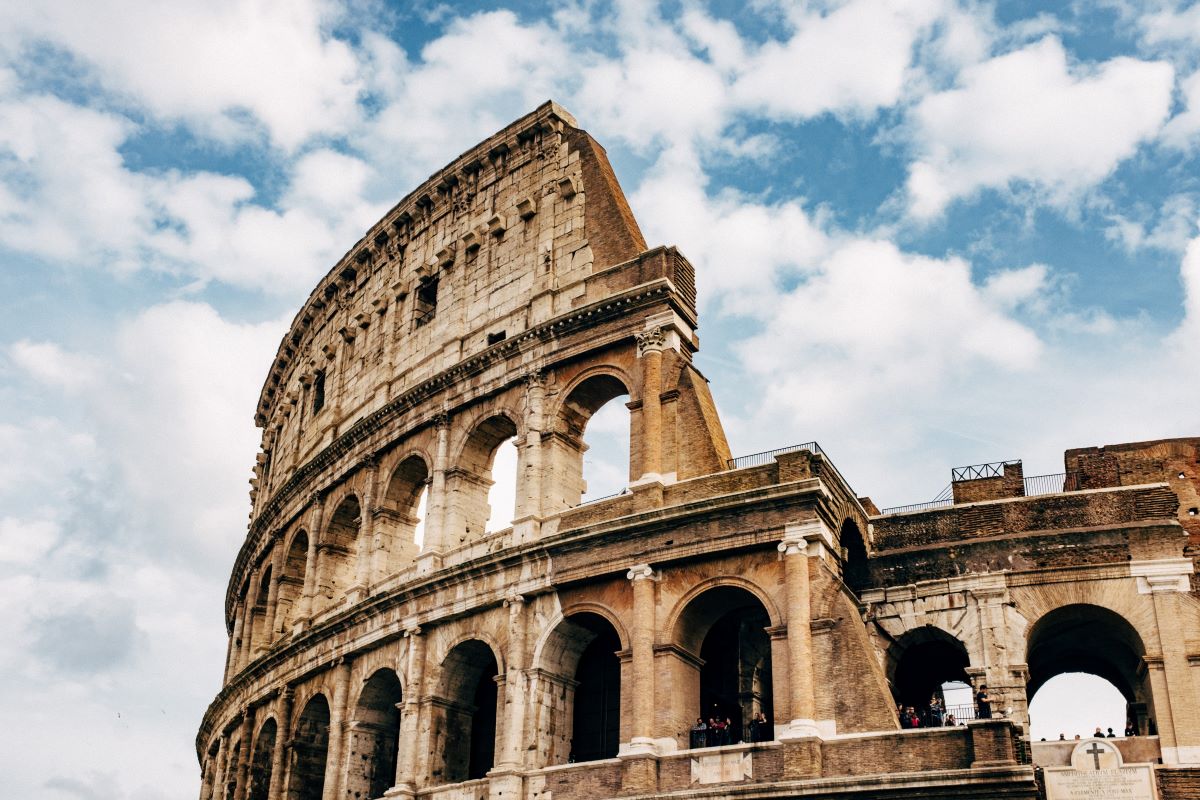
Of course, we think this city merits at least a few days of exploring. But in case you’re short on time, we’ve rounded up the top spots you simply can’t miss.
On this self-guided walking tour of Rome, we’re taking you from the Colosseum to the Vatican, with many stops in between. But feel free to spend as much time as you’d like at each place, and adapt it to fit with any other tours you might have scheduled.
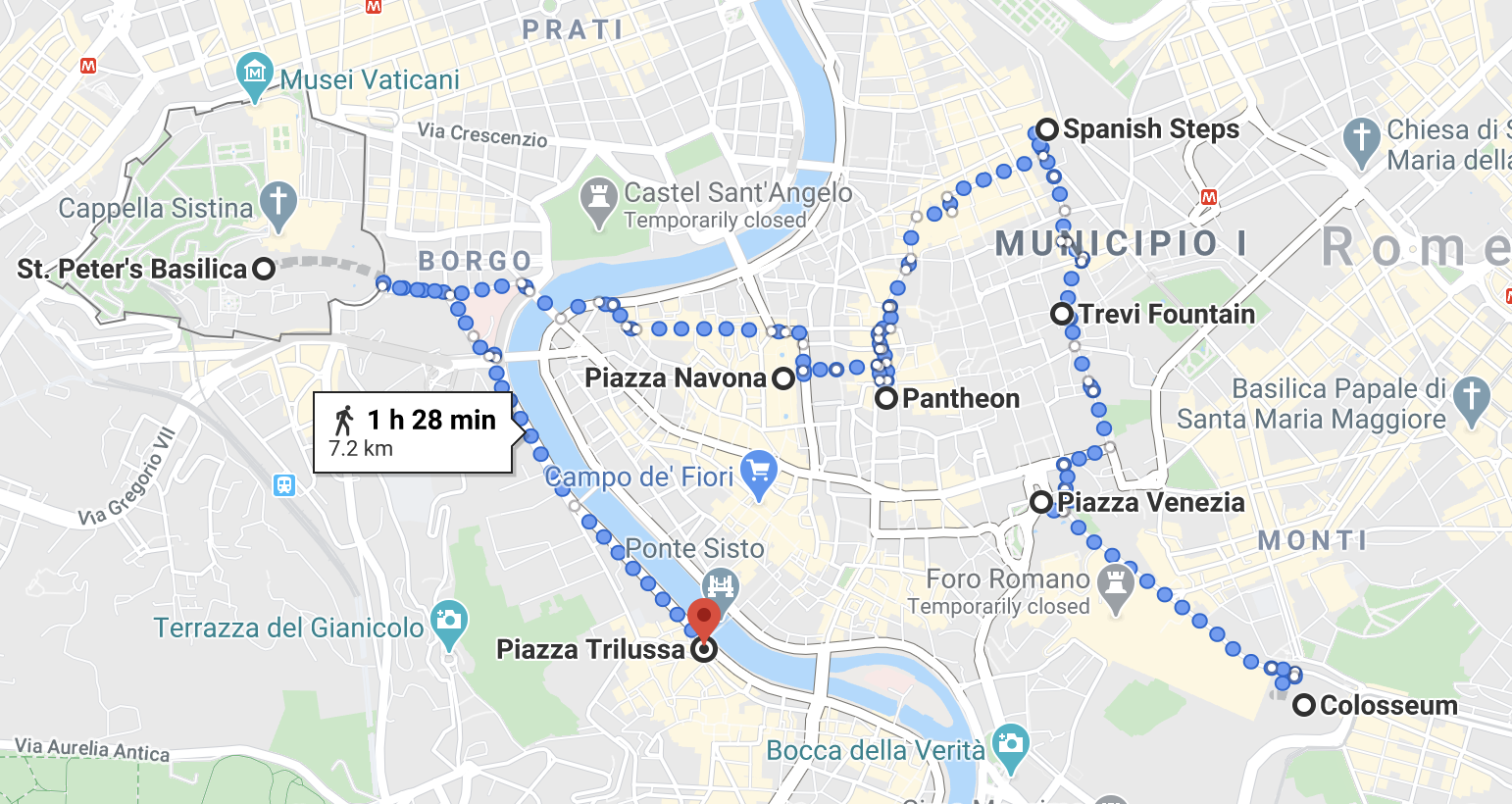
8 Essential Stops on a Self-Guided Walking Tour of Rome
Colosseum and roman forum.
Let’s start our day with one of Rome’s oldest monuments, the Colosseum . Even if you don’t have time to go inside, the park around the monument gives you a good look at the exterior. If you walk down the road a bit, you’ll be able to look down into the Roman Forum at the ruins as well.
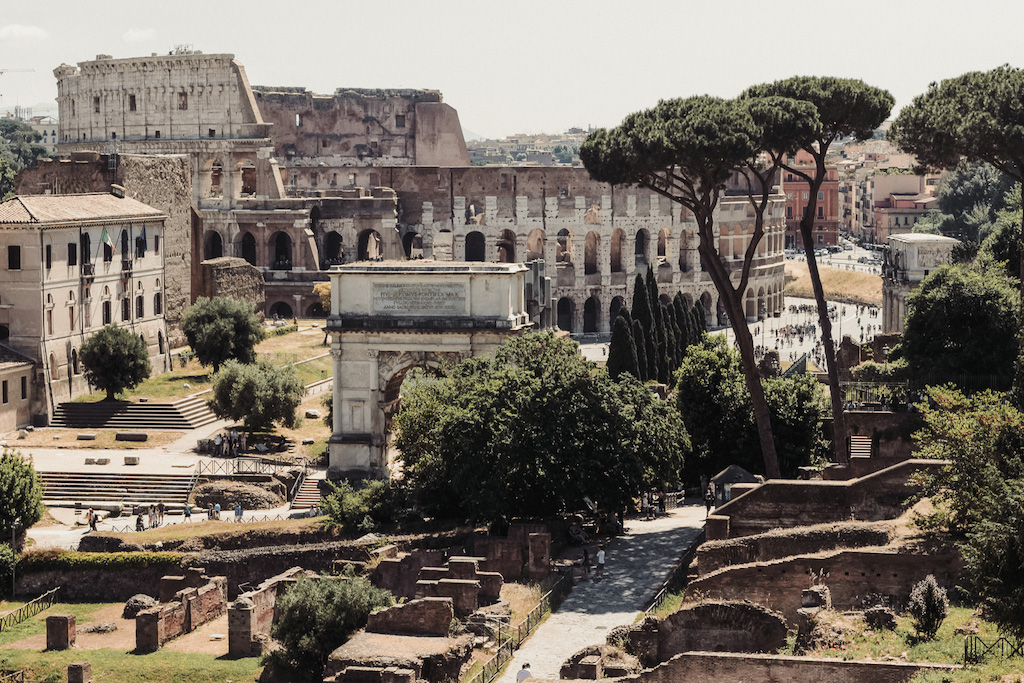
Piazza Venezia
Your next stop is the central hub of Rome, Piazza Venezia, where you’ll find the Vittorio Emanuele II monument—or as the Romans affectionately call it, “the wedding cake.” This multi-level, white marble monument was built to commemorate the unification of Italy under the reign of its first king, Vittorio Emanuele II.
Trevi Fountain
Not far from Piazza Venezia is one of the most popular sites in Rome, the Fontana di Trevi . Wandering along a small side street, you’ll hear the fountain before you see it. This stunning masterpiece is a must-see for any first-time visitors to Rome. Due to the popular tradition of throwing coins in the fountain, it earns about €3,000 a day to be given to the charity Caritas .
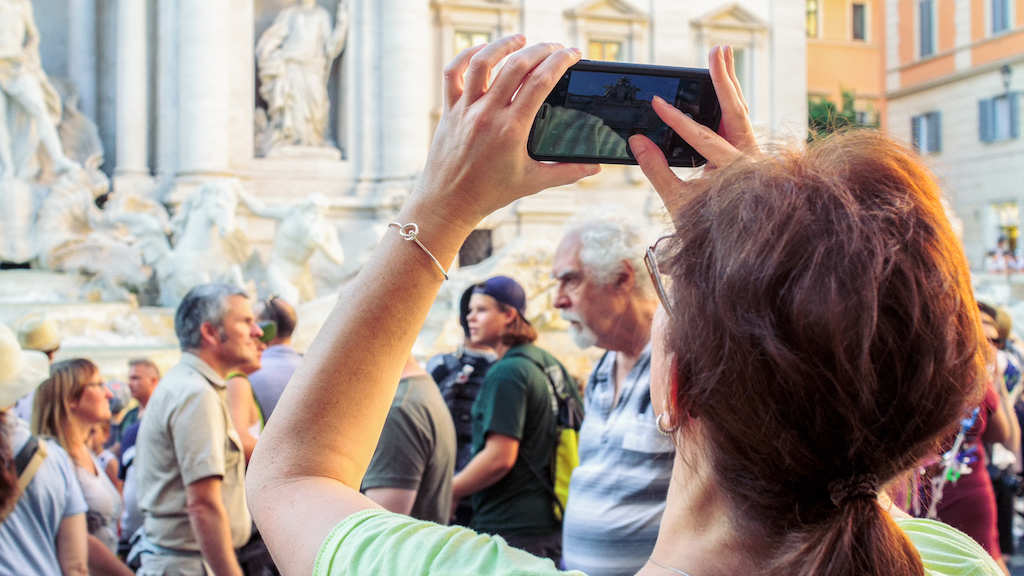
Insider’s tip: It’s best to visit as early (or late) as possible in the day to avoid the crowds. Think 5 or 6 a.m.!
Spanish Steps
From the Trevi Fountain, you’ll make your way to the Spanish Steps next (detour to Piazza Barberini if you’d like to see another of Bernini’s fountains along the way, the Fontana del Tritone ). Because recent restrictions prohibit any sitting or eating on the steps themselves, hold off until our next stop. In the meantime, you can take photos, grab a drink at the rooftop terrace above the steps, or do some shopping at the designer stores in the square.
This iconic building is next on your self-guided walking tour of Rome. You may know that the Roman Pantheon is famous for being the largest unreinforced concrete dome in the world. But did you know that the building burned down twice?? Or that painter Raphael’s fiancée is buried here? Before gazing up at that awe-inspiring ceiling, make sure to brush up on some little-known facts about the Pantheon !
And of course, we have plenty of recommendations for where to eat near the Pantheon. After you’ve admired the only source of light, a 7.8-meter oculus in the center of the dome, head outside to enjoy a refreshing gelato.
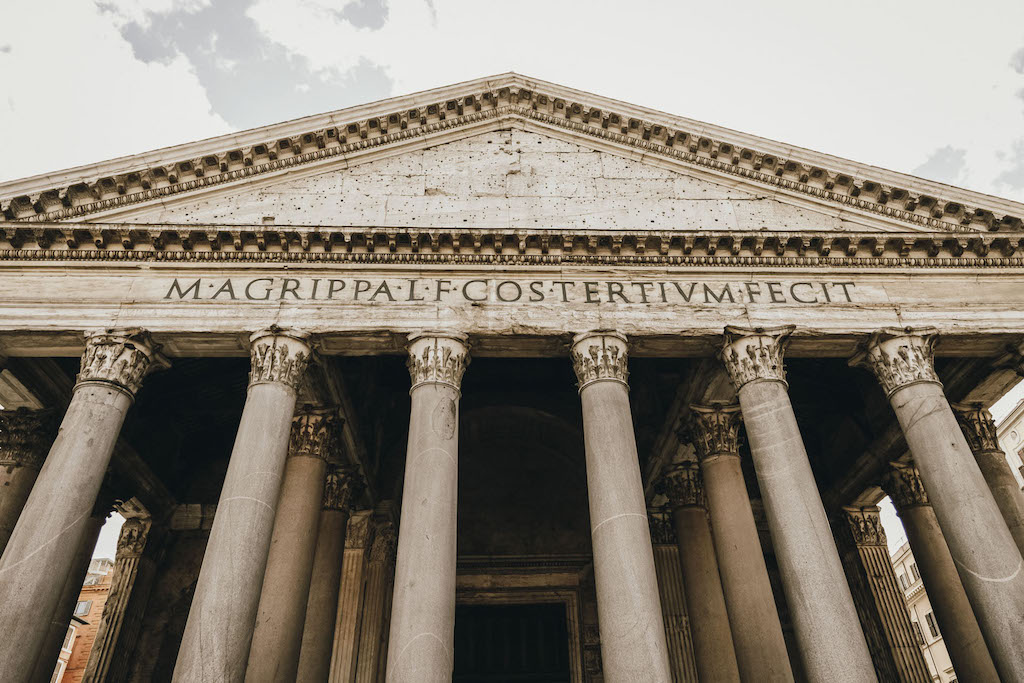
Piazza Navona
A short walk from the Pantheon will bring you to Piazza Navona . Just like the Circus Maximus, this square was originally used for chariot racing and other events in Ancient Roman times, before being built over in later eras. In the center is yet another of Bernini’s fountains, the Fontana dei Quattro Fiumi , which has inspired people with its beauty for centuries.
Remember, it’s best to skip dining at any restaurants in this area (most of which will be overpriced). But if you do want to sit and enjoy the view, grab a cappuccino or glass of wine at one of the many bars nearby.
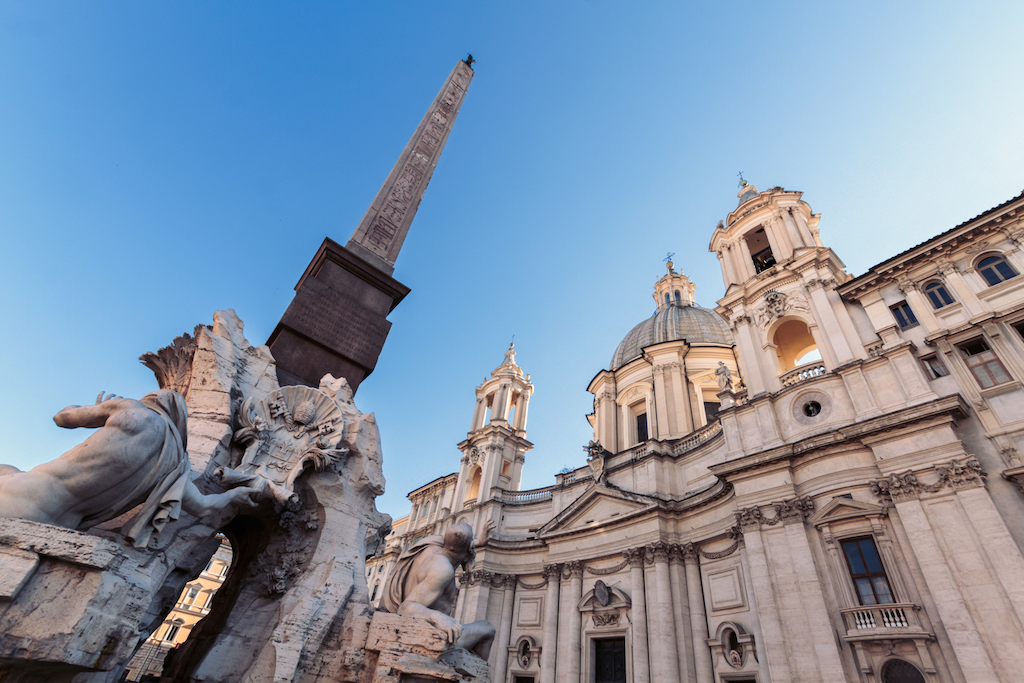
St. Peter’s and the Vatican
Depending on what time of year you’re visiting, the Vatican can easily take up an entire morning or afternoon. Be prepared for long lines (even if you buy a ticket ahead of time). You’ll want to dedicate at least a couple of hours if you do decide to venture into the Vatican Museums or the basilica. From the outside, however, you can see the entire square of St. Peter’s and enjoy the exterior architecture and sculptures.
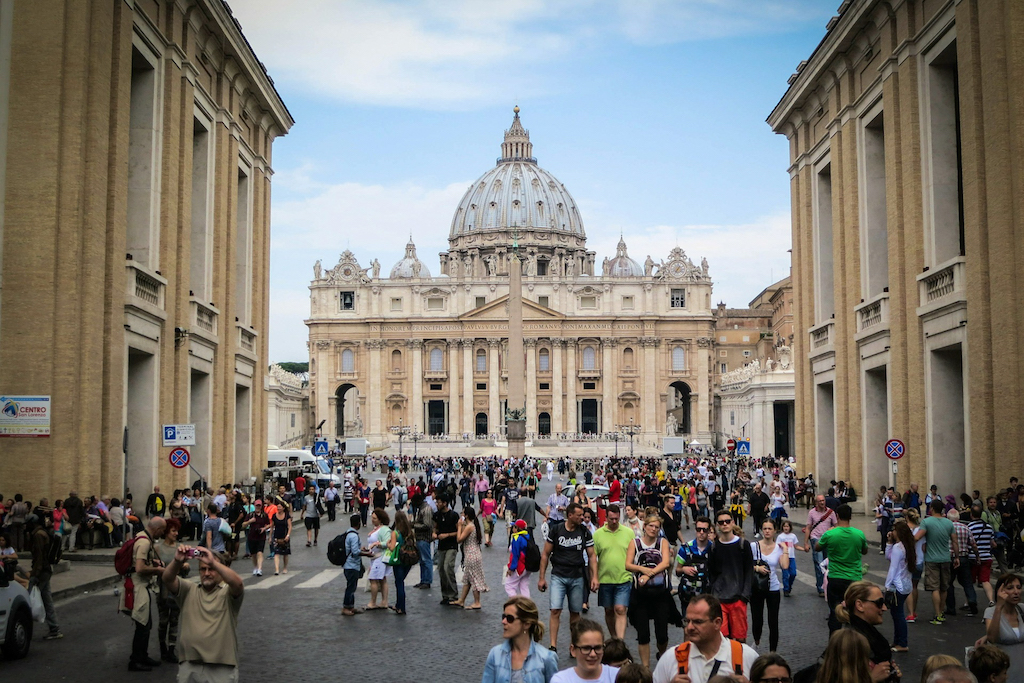
After a long day spent exploring the center of Rome and its historic treasures, heading to the Trastevere neighborhood for dinner, a drink and maybe a gelato is the perfect way to end the evening. Join us on our Trastevere at Sunset: Rome Food & Wine Tour or continue the DIY spirit of the day and choose from among Trastevere’s best restaurants .
Either way, you’ll end your tour of Rome in one of its most beautiful areas, where you’ll get to see a different side of this vibrant city.

Update notice: This article was updated on June 19, 2023.
And, if you offer a coin to the Trevi Fountain, you’ll be more likely to return to Rome. I left in 92, didn’t do the coin thing as I’d hoped to be back in 2 weeks (half my vacation), I never returned. When you’ve spent a few days in Rome, you’ll understand. A word to the wise.
Very wise words, Mary!
Leave a Reply Cancel reply
You must be logged in to post a comment.
- Shop Now! 🚚 Free Shipping on all orders in Europe, UK, Canada & US!
- 🇮🇹 Explore Italy on Foot
Best Self-Guided Walking Tour of Rome
The city of Rome, with its ancient history, astounding architecture, and vibrant street life, is truly a treasure trove for explorers. At Rome on Foot, we understand that the best way to fully immerse yourself in the character of this majestic city is by wandering its storied paths at your own pace. That’s where our expertly crafted self-guided walking tours come into play, allowing you to delve into Rome’s enchantments with the freedom that structured tours can’t offer. Want to start your adventurous journey? Check out our carefully formulated walking maps of Rome that will lead you to awe-inspiring discoveries.
A Day to Remember: Rome in One Sweep
For travelers eager to experience the heart of the city but tight on time, Rome on Foot provides a streamlined itinerary that encapsulates the essence of Rome in a single day. Starting from iconic transport hubs like Termini station, this walking tour swoops through the city’s major landmarks. Marvel at the Colosseum, stroll through the Roman Forum, toss a coin in the Trevi Fountain, and feel the spiritual splendor in Vatican City. Each step on this route is carefully planned to ensure that you don’t miss out on anything that this historic city has to offer.
Our interactive maps come equipped with numbered pins that act as your virtual guide through Rome’s cobblestoned alleys and piazzas. Simply click on each red pin as you reach your destinations for a quick pop-up description—no extra guidebook necessary. And if your feet tire, we provide information about public transport options that can whisk you to the next attraction in comfort.
Discovering Historical Icons: The Papal Basilicas and More
The essence of Rome isn’t just in its bustling streets but also in its serene and magnificent houses of worship. Among them stand out the Major Basilicas; with four located in Rome, these architectural marvels are a must-visit. Our walking maps highlight routes to the Archbasilica of St. John Lateran, St. Peter’s Basilica, the Basilica of St. Paul Outside the Walls, and the Basilica di Santa Maria Maggiore. Each of these Basilicas has a story to tell, one that’s deeply woven into the fabric of Roman and global history.
The beauty of self-guided tours is that you can spend as little or as much time as you’d like, absorbing the tranquility and artistic heritage of these places without the pressure to keep up with a group. And with Rome on Foot, you’ll have all the practical information at your fingertips, such as opening hours and entrance fees.
View this post on Instagram A post shared by #romeonfoot (@romeonfoot)
Rome’s Hidden Gems: Quirky Districts and Scenic Views
Venture beyond the well-trodden path and you will find neighborhoods bubbling with character and charm. Let the quaint Quartiere Coppedè enchant you with its whimsical buildings or experience the daytime buzz and nocturnal charm of Trastevere, often heralded as the ‘real’ Rome.
For those in search of breathtaking panoramas, our guides will take you to the city’s vantage points where Rome’s skyline unfolds majestically before your eyes. Be it the lavish terrace at Villa Borghese or the humble Aventine Keyhole, each spot offers a unique perspective on the city.
Armed with our comprehensive walking maps and insights, you’ll have everything you need to capture memories that last a lifetime. Whether your journey brings you amidst the grandeur of the past or the lively hum of the modern city, our self-guided tours are designed to offer you an authentic experience of Rome, at your own rhythm and pace.
Embrace the freedom of discovering Rome on foot, at the turn of every corner and with the sound of your footsteps echoing on ancient stones. Be sure to visit our website, Rome on Foot, where the best self-guided walking tour of Rome awaits, ready to guide you through a labyrinth of culture, history, and beauty. Explore, wander, and let the city’s eternal embrace captivate your wanderlust. With us, you’re not just a visitor, but a storyteller in the making, traversing through chapters of time and magnificence. Welcome to Rome—may your journey be as enchanting as the city itself.
Explore our walking maps of Rome:
Rome in a day.
📌 Allotted Time: 1 day 🐾 Walking time: 3-4 hours
Panoramic Views in Rome
📌 Allotted Time: 1 day 🐾 Walking time: Flexible
Fountains of Rome
📌 Allotted Time: 5 hrs 🐾 Walking time: 4-5 hours
You might be interested in …
Your ultimate guide to atms in italy, tour of castel sant’angelo: an unforgettable experience, rome’s living legacy: a guide to the city’s emblematic symbols, do you tip in rome.
Simply Wander
curated travel guides to help you wander simply and simply wander
Meet the Youngs
- Privacy Policy
Search this site
- Skip to primary navigation
- Skip to main content
- Skip to primary sidebar
Europe , Italy · April 11, 2019
The Best Self-Guided Walking Tour of Rome, Italy
Rome is called the Eternal City because ancient Romans believed that Rome was invincible.
They believed Rome was untouchable, that no matter what happened or how many empires came and collapsed, Rome would go on forever. And it has.
As soon as you step foot inside the city, you will be immediately drawn in by its cobblestone streets, outdoor cafes and fascinating history.
If you are planning your first trip, this self-guided walking tour of Rome includes the top tourist spots as well as an invitation to discover the true authentic beauty of Rome.
*This post contains affiliate links. If you book a guide through the link provided, we will earn a small commission at no extra cost to you. Thank you for your support!
The Best Self-Guided Walking Tour of Rome
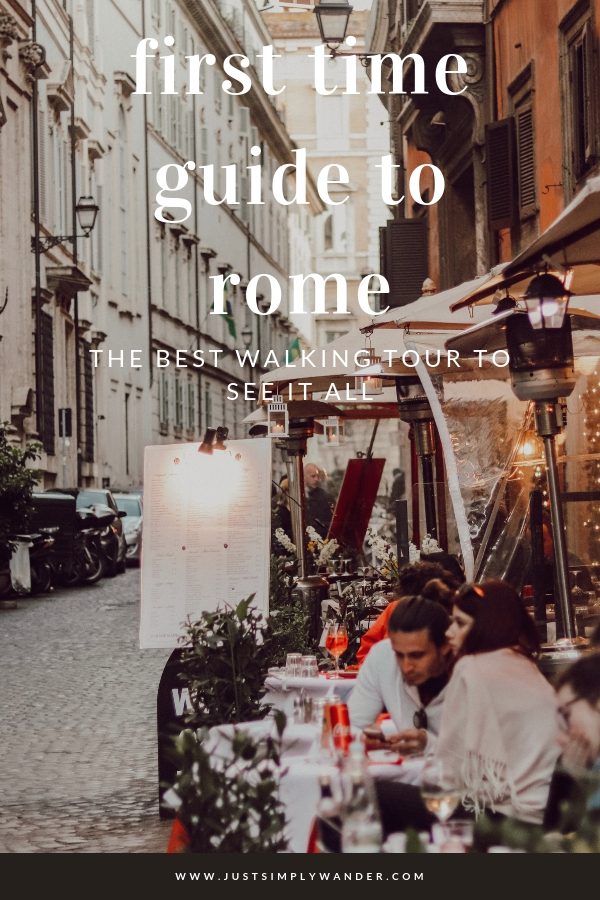
Table of Contents
Link to the self-guided tour map, 1. the colosseum, 2. roman forum, 3. trajan forum, 4. piazza venezia, 5. trevi fountain, 6. spanish steps, 7. the pantheon, 8. piazza navona and campo di fiori, 9. castel sant’ angelo and the tiber river, 10. the vatican city, 11. travestere.
I would recommend setting aside at least two days to visit all the sites on this walking tour of Rome.
The green markers on the map are food recommendations so that you can be sure to find some delicious Italian cuisine wherever you are on the walking tour.
We’ll start the walking tour at the Colosseum. This is one of the most recognizable landmarks and one of the most visited tourist attractions in the world.
It is interesting to note that the original facade was made of white travertine hauled by horse and cart from Tivoli for 4 years.
After the Colosseum was abandoned, much of it was removed and used to build St Peter’s Basilica and other churches and monuments.
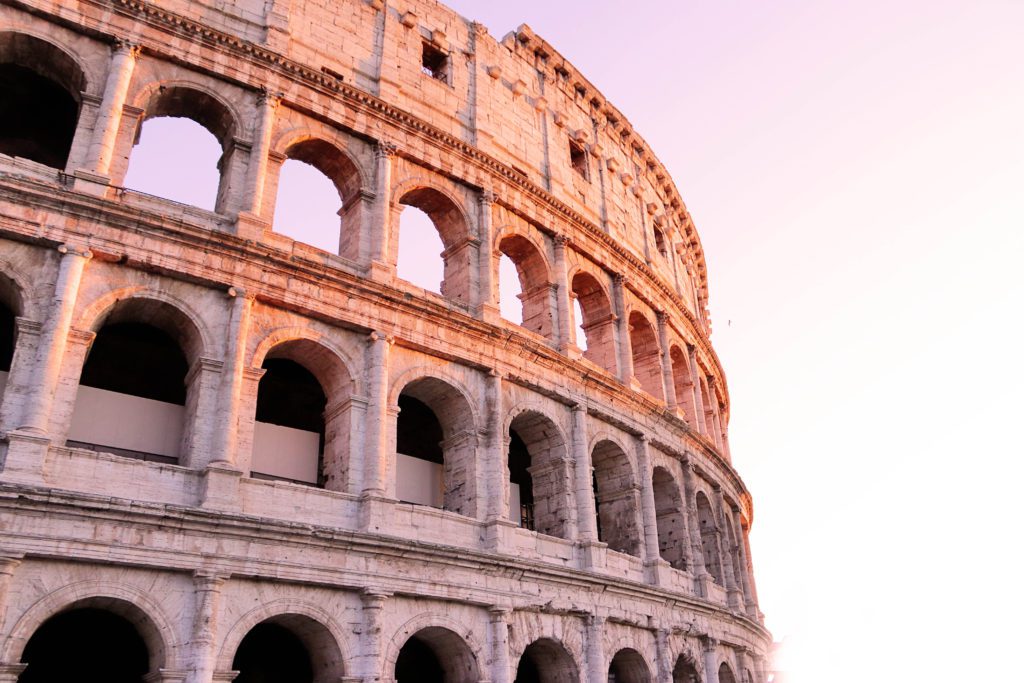
The Colosseum took 10 years to build at the hands of Jewish slaves. The Colosseum is most well known for its gruesome gladiator fights.
Participants included not only paid gladiators but also slaves and criminals who were sentenced to death.
Gladiators originated from the lower class but success in the arena could catapult them to stardom with riches and fame.
The massive amphitheater was also used for animal hunts, battle re-enactments, performances, and public executions. They would sometimes even flood the Colosseum to re-enact mock sea battles.
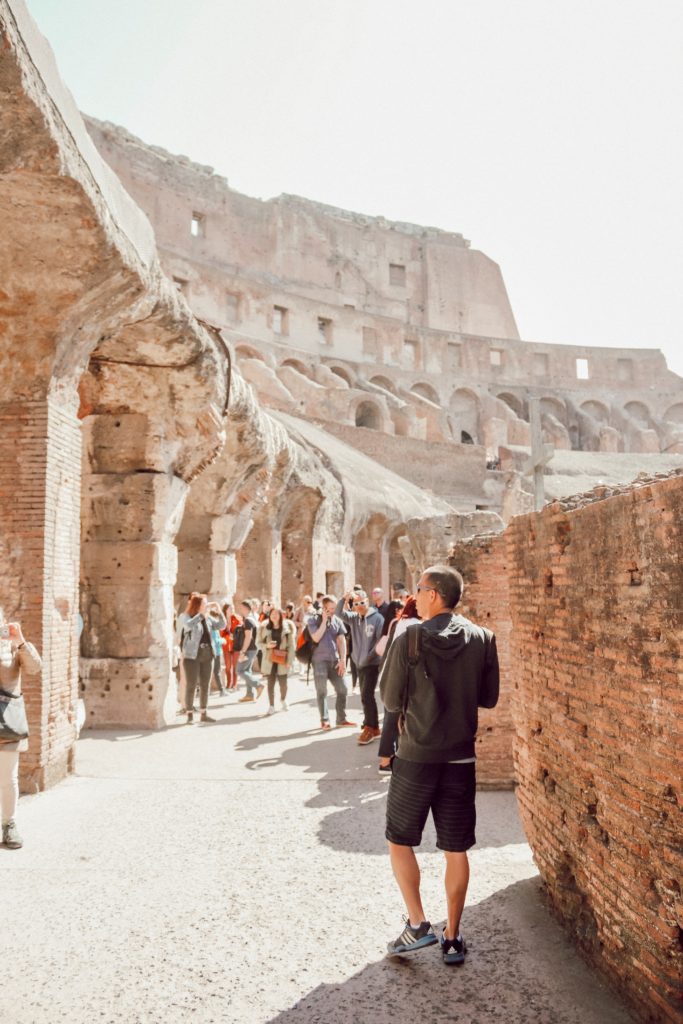
It is estimated that around 500,000 people and one million animals lost their lives during battles and games in the Colosseum.
The most epic games took place during a 123-day celebration of Emperor Trajan’s victories in Dacia. The brutal contests involved around 10,000 gladiators and 11,000 animals.
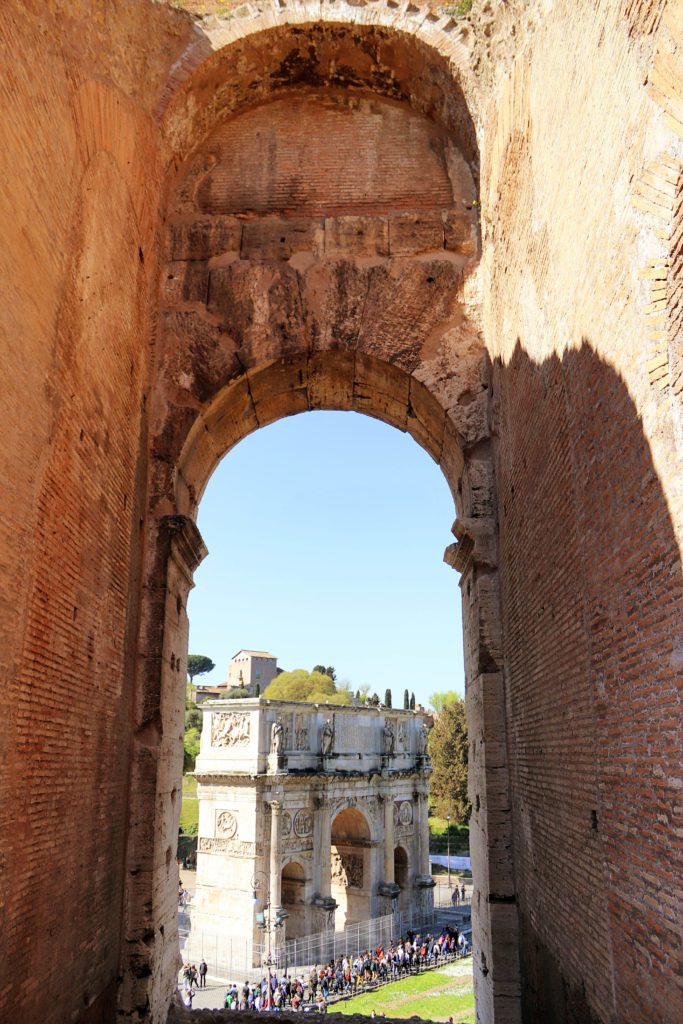
Animals were brought from all over to be slaughtered at the games. The most popular species were bears, hippos, elephants, tigers, lions, and jaguars.
As you can imagine, this had a devastating effect on the animal population. Entire species were wiped out during this period.
There are countless stories and historical facts just waiting to be absorbed. To make the most of your visit, book a guided or self-guided audio tour .
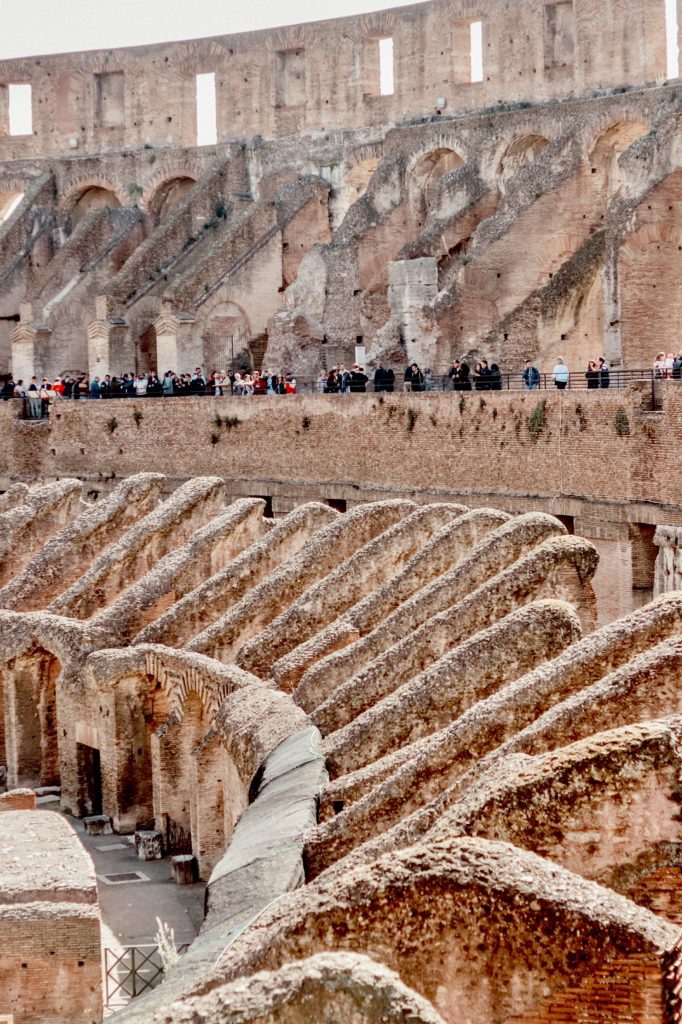
We recommend Get Your Guide as a reputable site. This is not sponsored, we just know there are plenty of sketchy tours and wanted to pass along a trustworthy recommendation.
I would highly recommend reserving a tour that includes a skip-the-line ticket.
I would also recommend downloading Rick Steve’s Audio Europe app. He includes an insightful self-guided audio tour of the Colosseum that I liked even better than the audio tour we purchased through the Colosseum.
If we were to do it again, I would save the money on the auido guide and just use the app.
For the best photo op, walk across the street and up a set of stairs to Via Nicola Salvi.
You’ll find some restaurants and a ledge that is perfect for capturing your photo in front of the Colosseum without the hordes of tourists and imminent construction.

Just outside the west end of the Colosseum, you’ll find the entrance to the Roman Forum.
Most Colosseum tickets include entrance to the Roman Forum and Palatine Hill as well, but you will need to go through a security checkpoint before entering the Forum.
Unfortunately, there are no “skip the line” ticket options here.
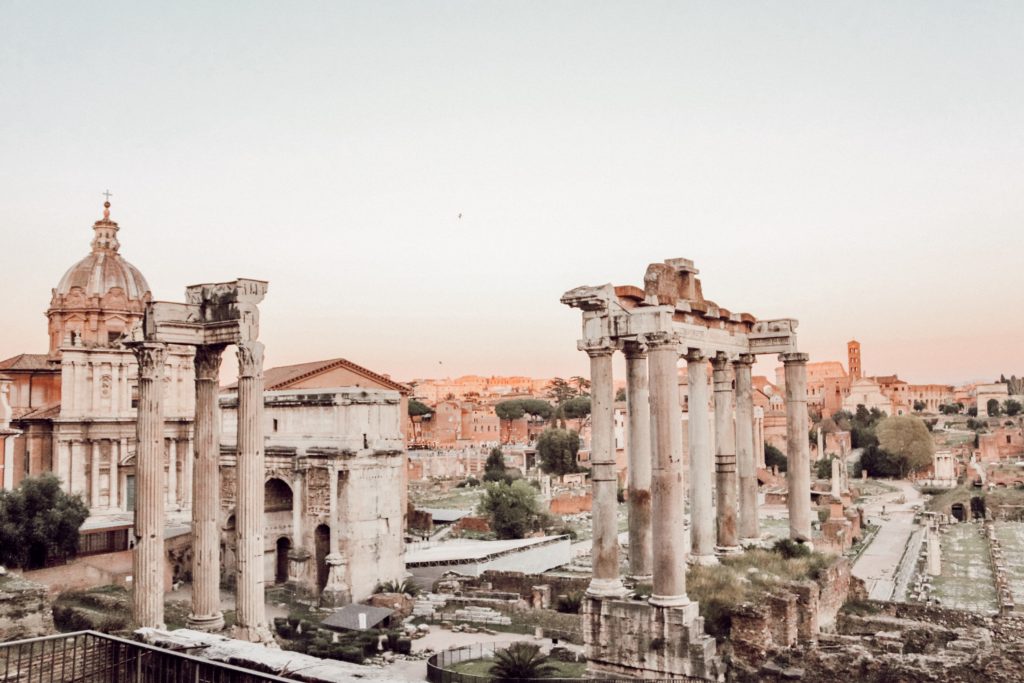
There are actually 3 separate entrances to the Forum, the one right off the Colosseum tends to be the busiest.
If the line is long, head over to the entrance at Largo della Salara Vecchia, just off at Via dei Fori Imperiali. Or the Palatine Hill entrance at Via di San Gregorio.
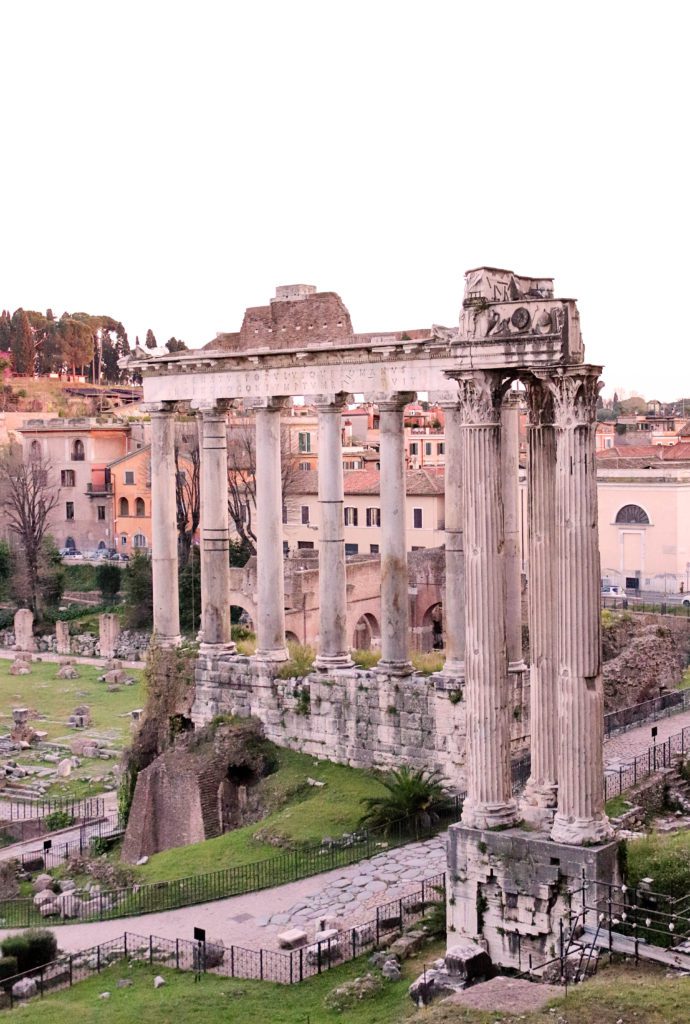
When purchasing your combo ticket, many of the audio guides are only for the Colosseum.
However, once again Rick Steves has an awesome free audio guide to the Roman Forum on his Audio Europe app that I would recommend downloading.
The Roman Forum was the beating heart of ancient Rome. It was the political, religious, social, and administrative center of the empire.
It took over 100 years to unearth the remains. As you walk among the ruins it feels like a hodgepodge of buildings. That is because over the centuries they would build over earlier ruins.
The Via Sacra is the main road through the Forum. It was part of the 50,000-mile etwork of paved roads throughout the empire.
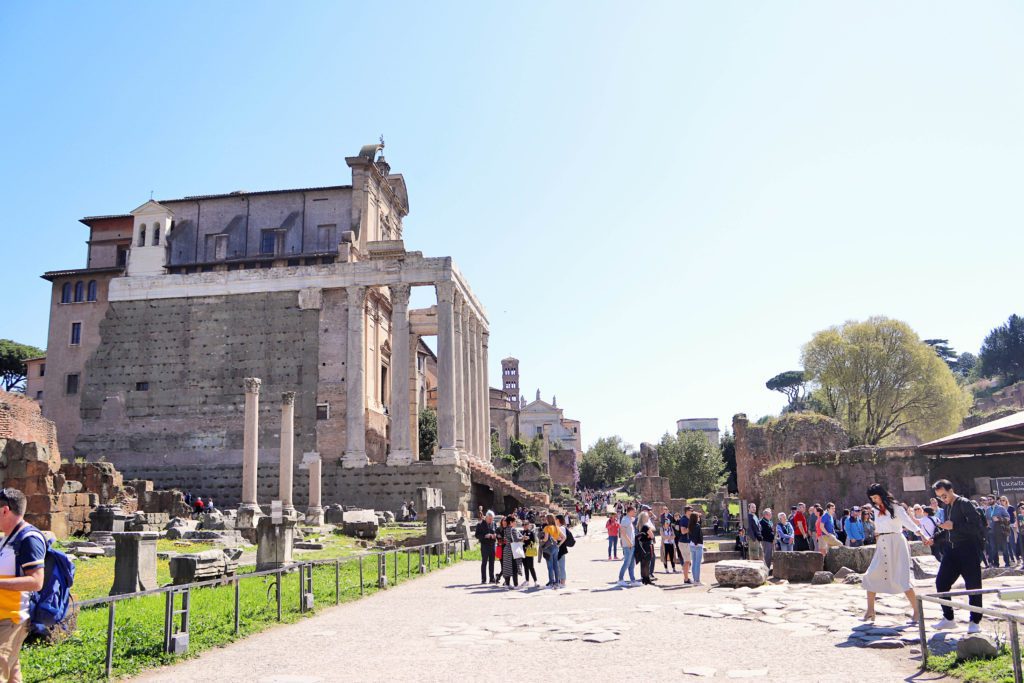
Most of the structures were built during the reign of Julius Caesar. Many important temples were erected here, the most prominent being the temple of Venus and Rome.
Three triumphal arches can also be found. The Forum was also home to banks, public bathhouses, market stalls, and political venues.
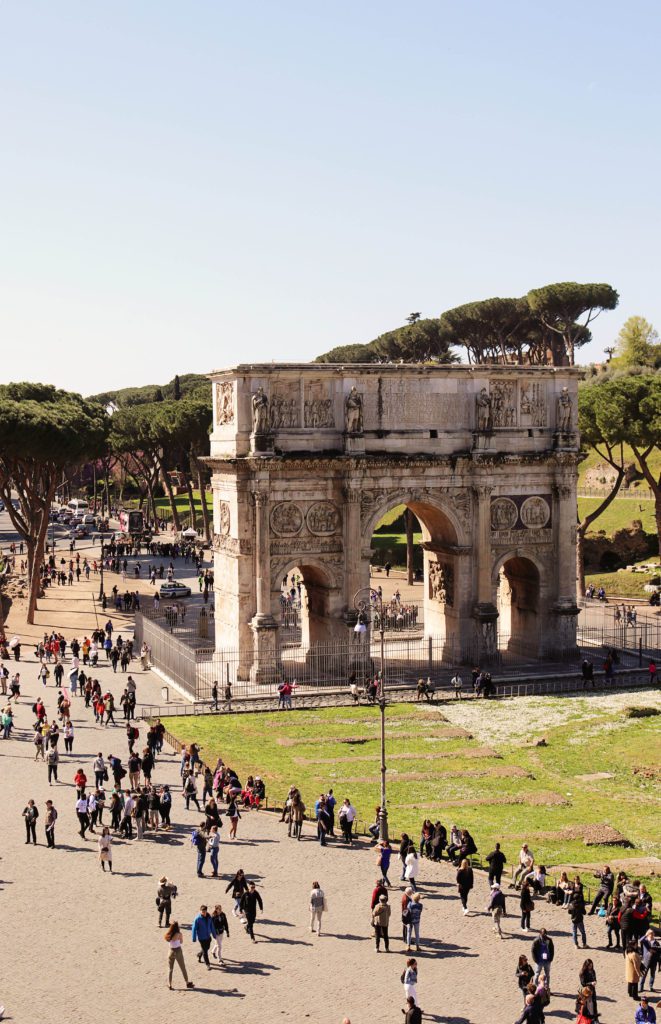
Another notable building is the Mamertine Prison where it is believed Peter and Paul were incarcerated in its dungeon.
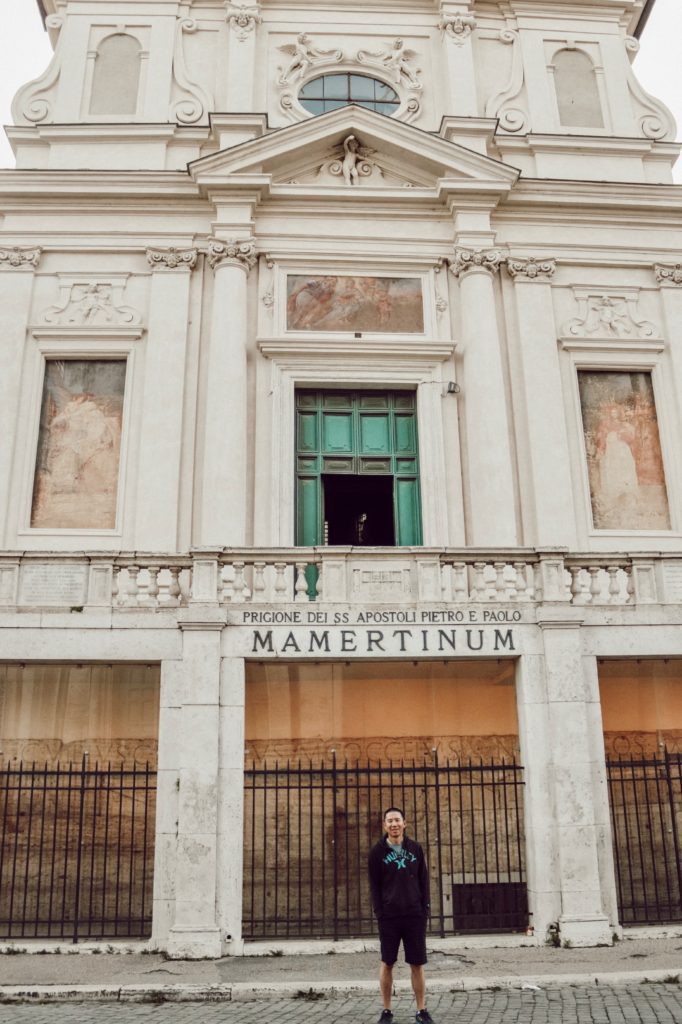
Palatine Hill is along the south side of the Forum and is considered to be the Beverly Hills of ancient Rome.
Boasting lavish palaces and manicured gardens overlooking the Forum, this was home to Roman society’s most elite.
Today you can walk up the stairs to a terrace with a large fountain overlooking the Forum.
The Forum truly is remarkable. Be sure to take advantage of a guided or self-guided audio tour to experience history coming alive.
Just north of the Forum, you’ll come across Trajan’s Forum. This forum was not only the last but also the largest and most elaborate of all the Imperial Forums.
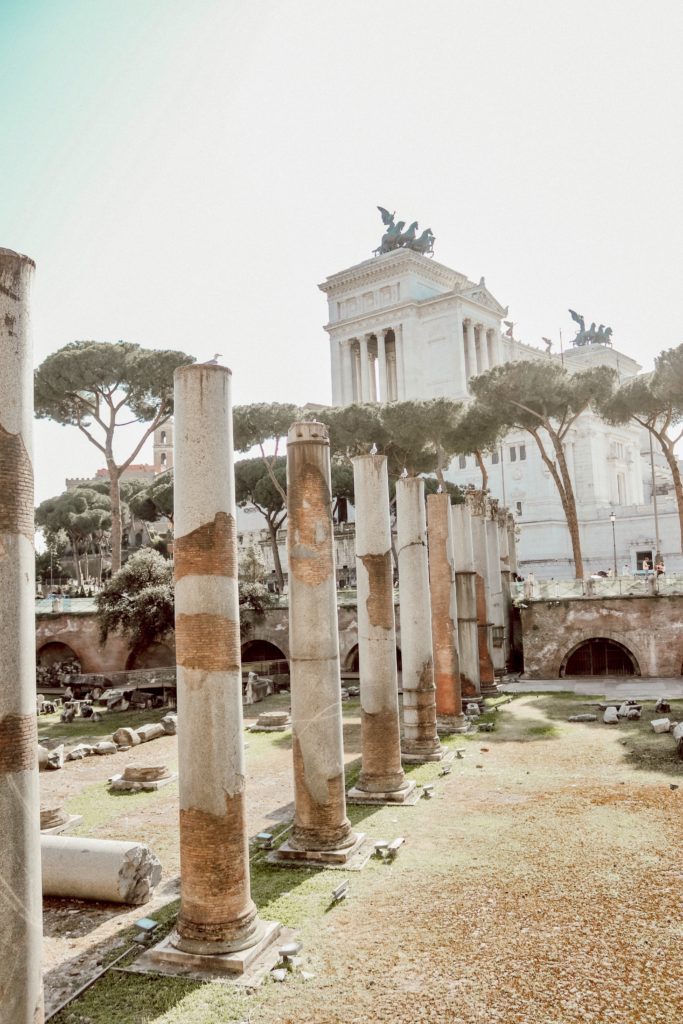
This Forum was seen as one of the architectural wonders of the world. It housed two massive basilicas, two libraries, and an impressive six-story market that would be the equivalent of today’s shopping mall. A temple was later added after Trajan’s death.
At the end of the road, you’ll come to Piazza Venezia. This is a busy square where four major roads intersect. It may have a chaotic feel to it, but this piazza actually holds historic significance.
Piazza Venezia is where Mussolini would rally up the crowds and is the spot where he declared the beginning of World War II.
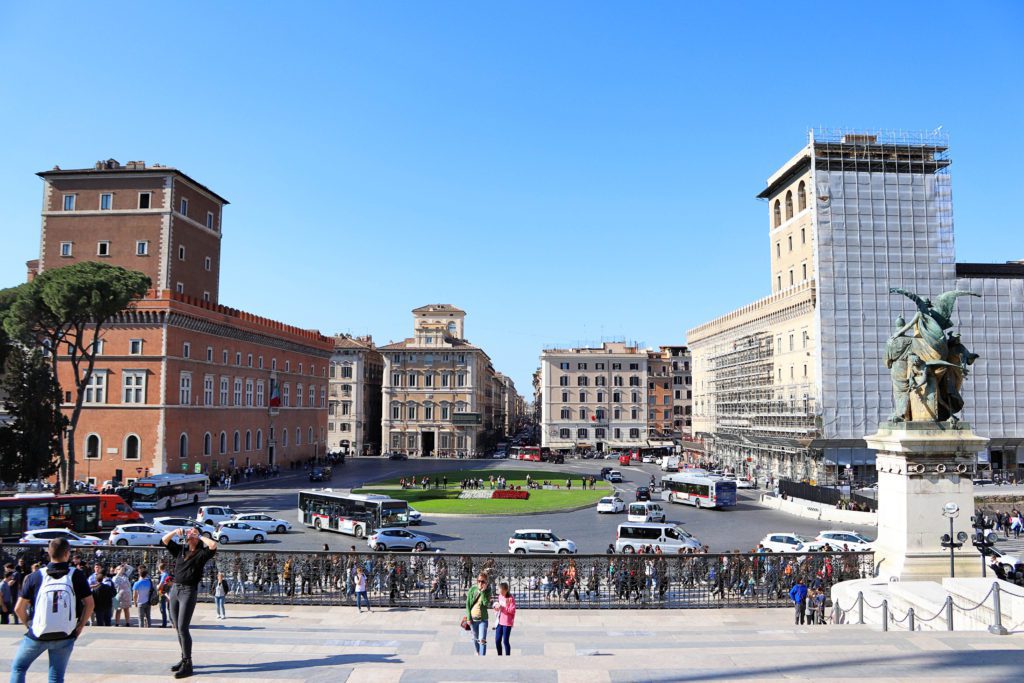
Overlooking the piazza on the south side, you’ll find the National Monument to Victor Emanuel II. This is Rome’s largest statue honoring the first king of United Italy.
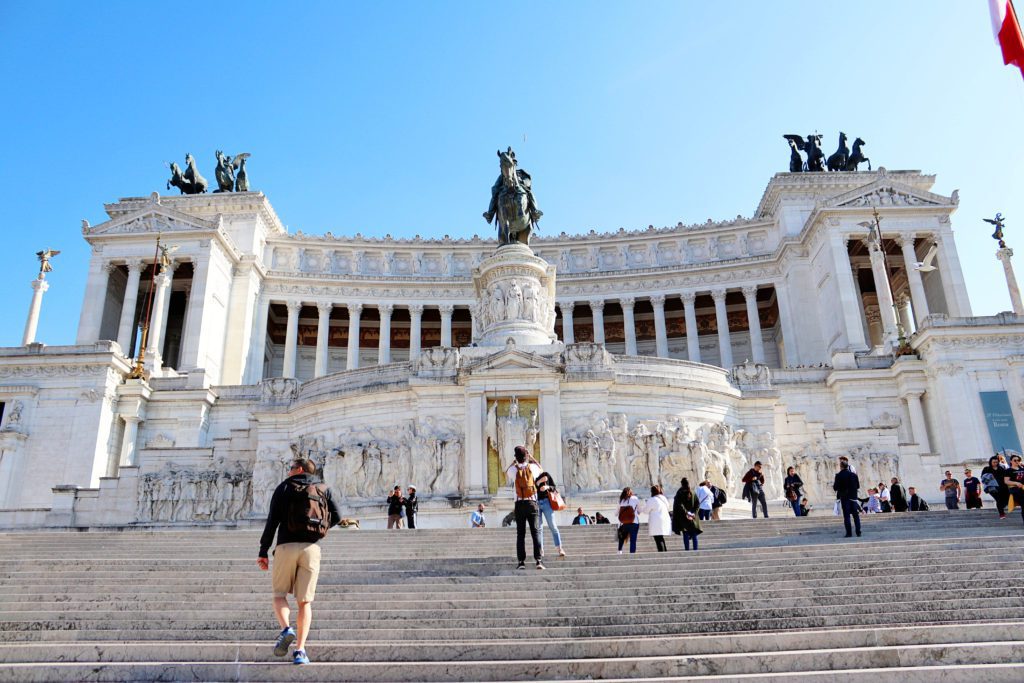
Underneath the statue, you’ll find the tomb of the unknown soldier.
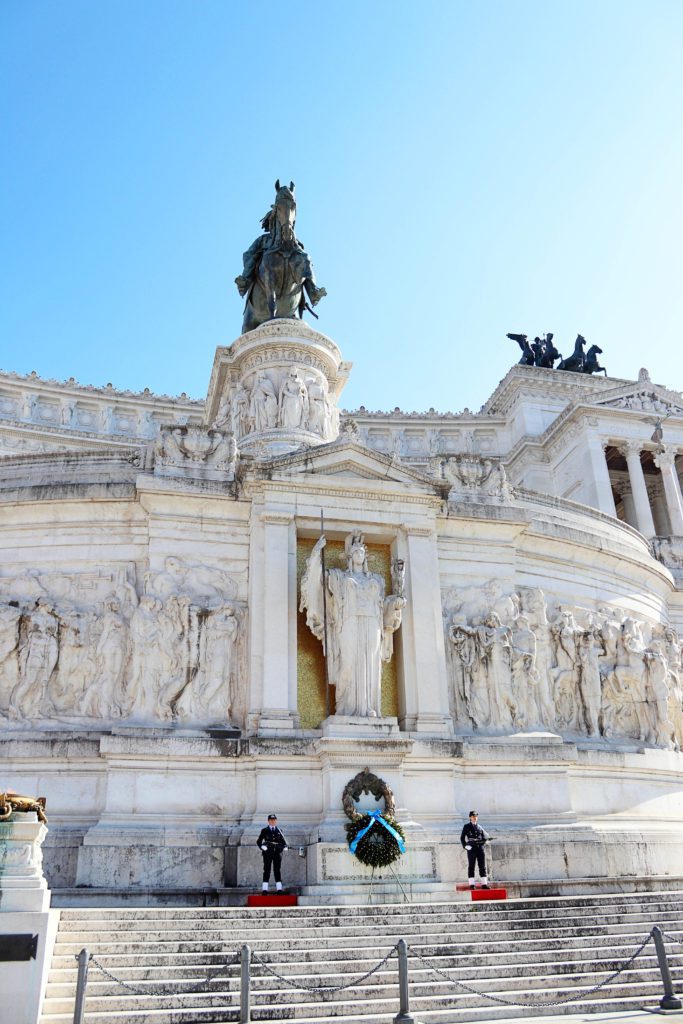
If you head up the stairs you’ll discover a free museum inside the building.
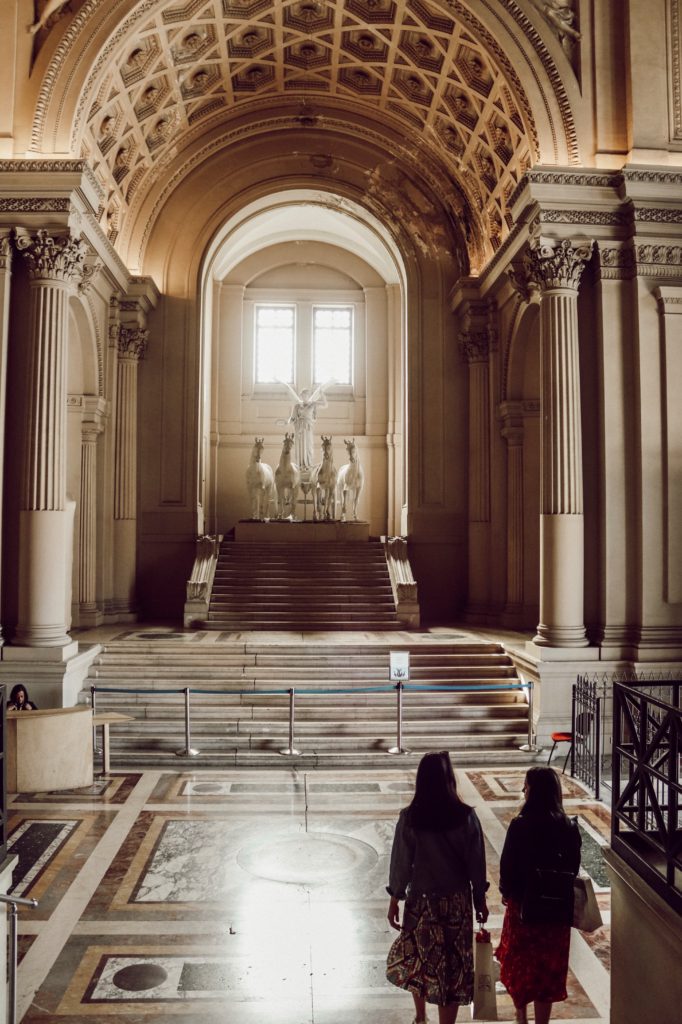
The Trevi Fountain is located about an 8-minute walk from Piazza Venezia.
The fountain is just as enchanting in person as you may have imagined. The grandeur of this baroque fountain is truly magnificent.
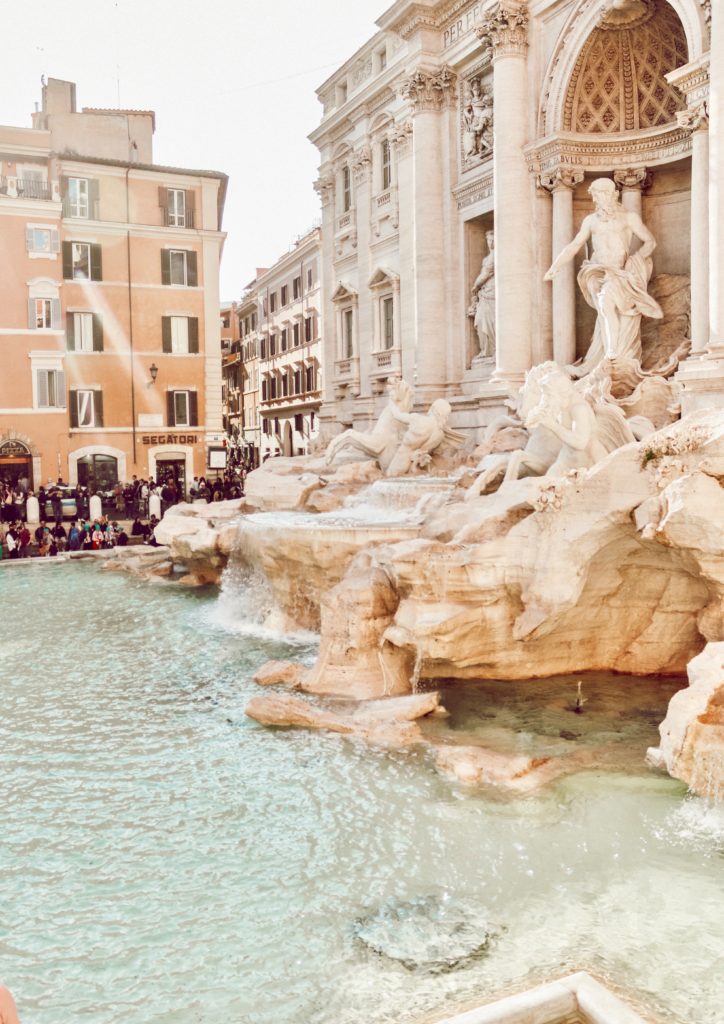
The Trevi fountain is the oldest water source in Rome and took over 100 years to complete.
The fountain sits at the end of the Aqua Virgo Aqueduct where three streets converge. “Three streets” translates to “tre vie”, which is how the fountain got its name.
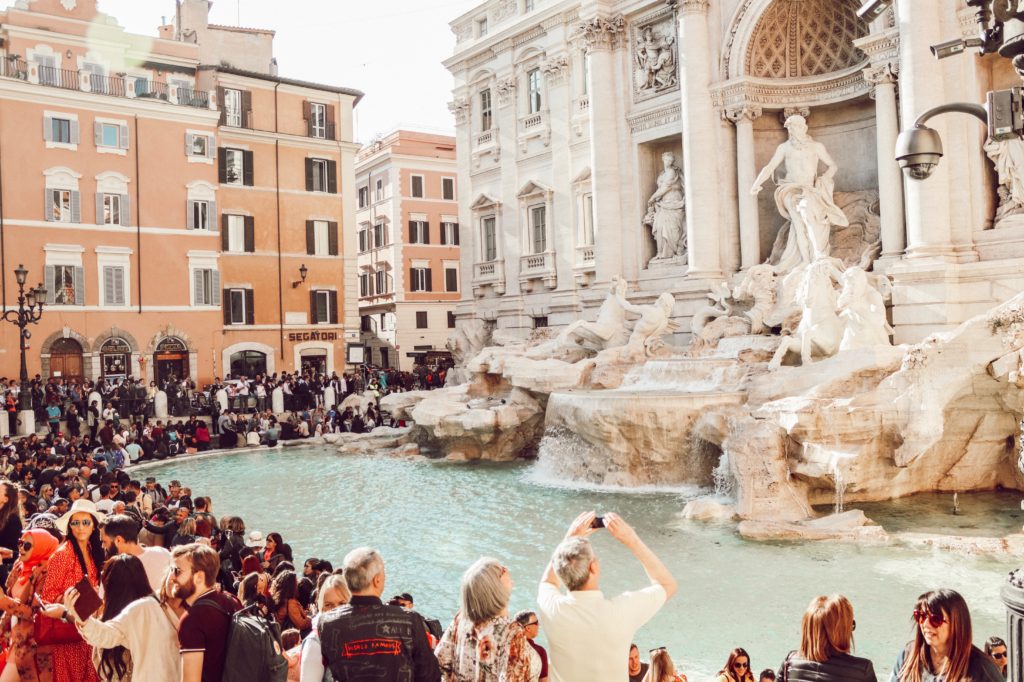
It is interesting to note that the funding for the fountain came from the Roman lottery game.
Visitors wishing to return to Rome throw a coin over their shoulder for good luck.
With millions of tourists flocking to the fountain each year, that adds up to about 3,000 euros each day. The money is collected and donated to a local charity.
I wasn’t prepared for how crowded it was. We visited in the offseason and were elbow-to-elbow with tourists. Early morning or late at night is your best bet to get a little space.
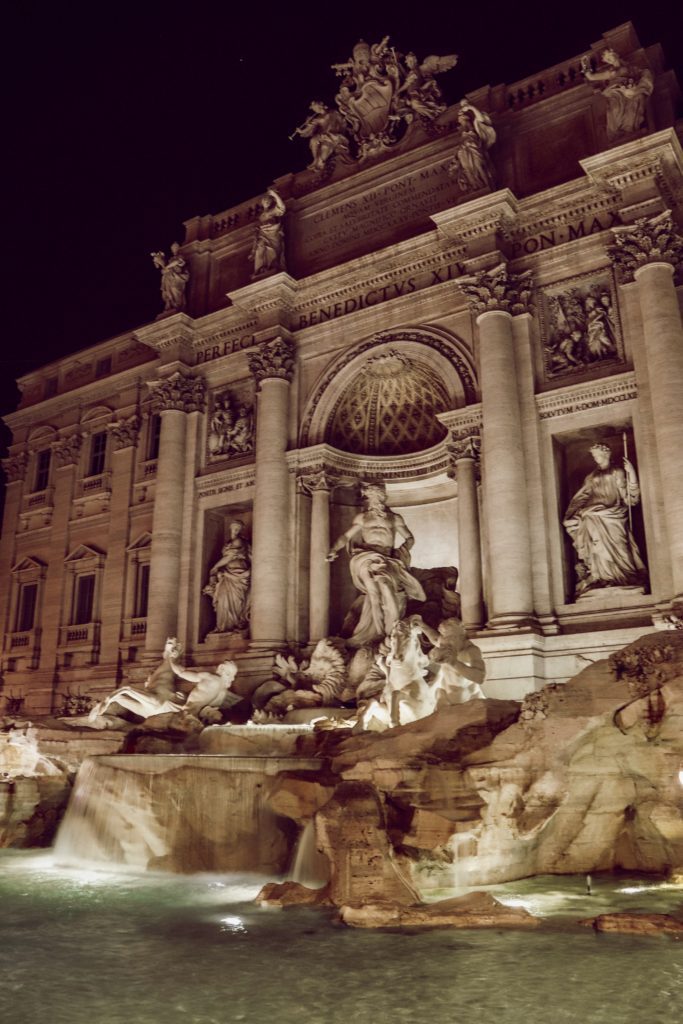
All the crowds make this a hot spot for pickpocketing. Be sure to keep your valuables close.
I would recommend a travel money belt , and if you have a backpack, be sure to carry it in the front. You might feel silly, but so many people do it, even the locals.
But if you want to escape the crowds and experience the Trevi Fountain in a unique way, check out this secret archeological site under the Trevi Fountain!
Another little hidden gem is the Lover’s fountain to the right of the Trevi Fountain.
Just look for a little walkway to the right of the fountain, then follow the steps up and you’ll see a small little fountain.
This is the Lover’s Fountain and legend has it that if lovers drink from the fountain they will find lasting love.
The tradition started during WWII when the soldiers had to leave their fiancés behind. The girl would come to the fountain with a brand new glass and fill it with water for her boyfriend to drink. After drinking it, she had to break the glass to seal their love.
The Lover’s Fountain is a romantic little part of history and a cool little hidden gem in Rome!
The short walk to the Spanish Steps will take you through charming pastel alleyways and past open-air cafes. You’ll feel like you’re in a movie set.
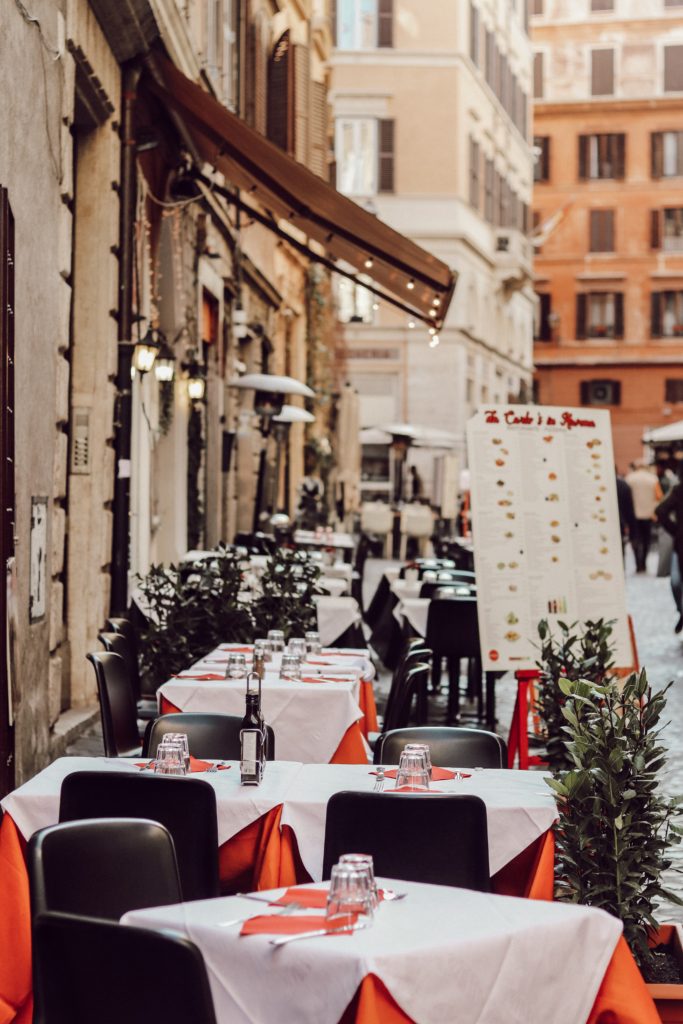
Once you arrive at the Spanish Steps, it may feel a little anti-climatic. I have to admit, I didn’t really see what was so special about a staircase. And after being there, I still don’t get what the hype is all about.
This is the widest staircase in all of Europe with 138 uniquely shaped steps, but they are just steps after all. And really crowded steps at that.
Hundreds of people can be found lounging on the steps, although keep in mind that it is illegal to eat on the steps and there are police keeping an eye out.
But what I did love about the Spanish Steps was the vibrant energy and the incredible view from the top.
The Piazza di Spagna is located at the foot of the steps and is a lively square.
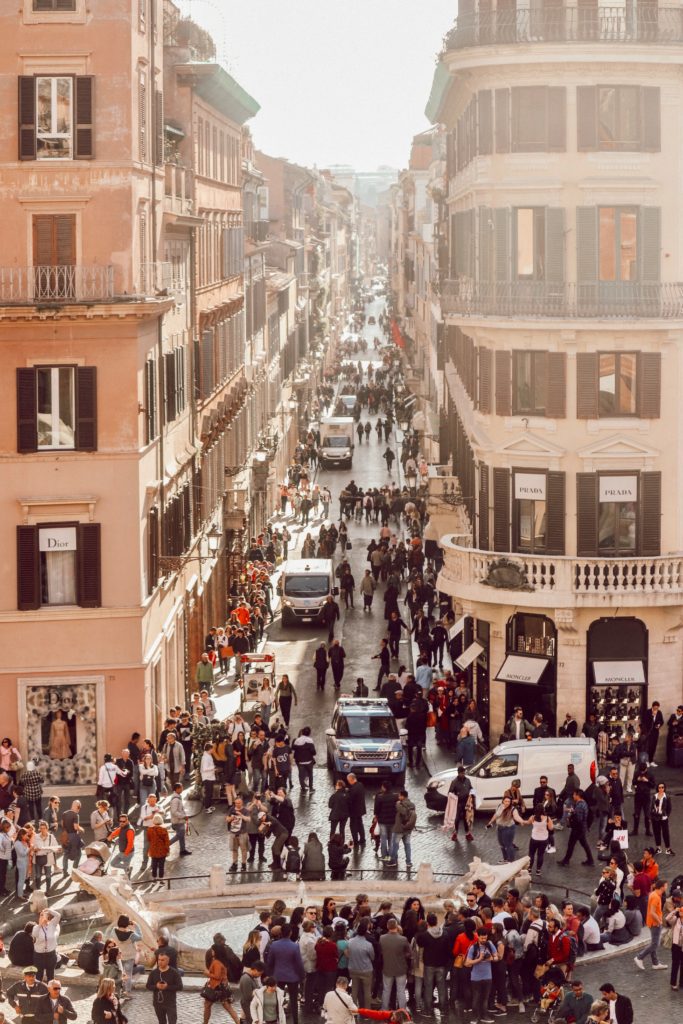
Once you make it to the top, take in the sweeping views then step inside the beautiful Trinità dei Monti church.
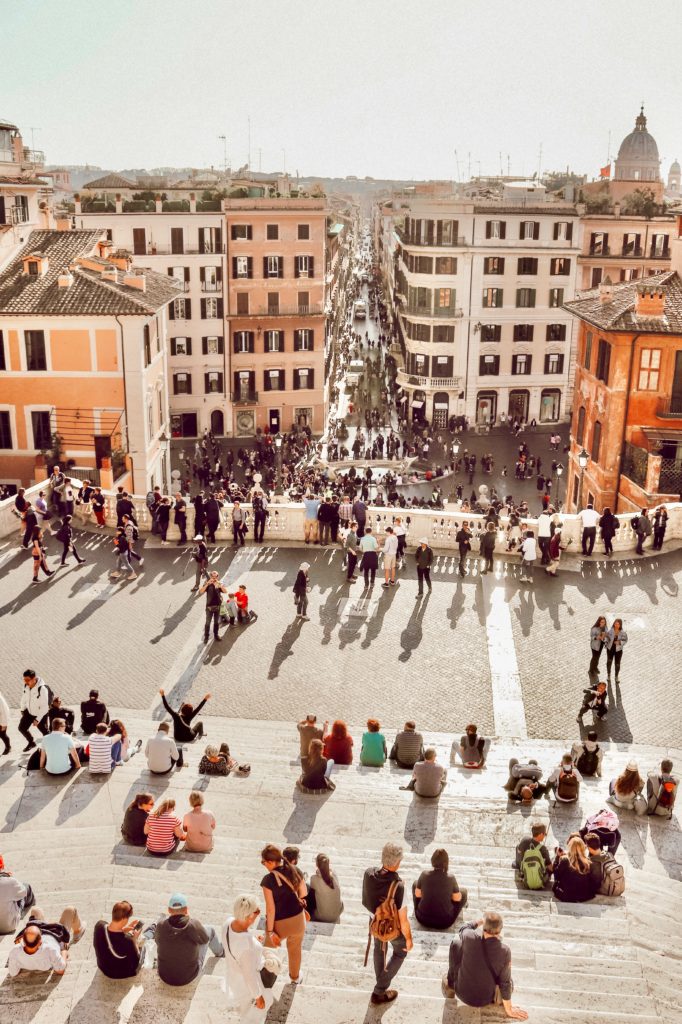
Around the corner, you’ll find a small pasta shop called Pastificio. This no-nonsense mom-and-pop shop came highly recommended to me by a friend and it did not disappoint.
Each day they make only 2 or 3 types of pasta. The generous portions are served up in a to-go container for only $4. The pasta is divine, and can best be enjoyed if you head up the hill to the Borghese Gardens.
These city gardens are reminiscent of New York’s Central Park. They offer a breath of fresh air and a respite from the crowds.
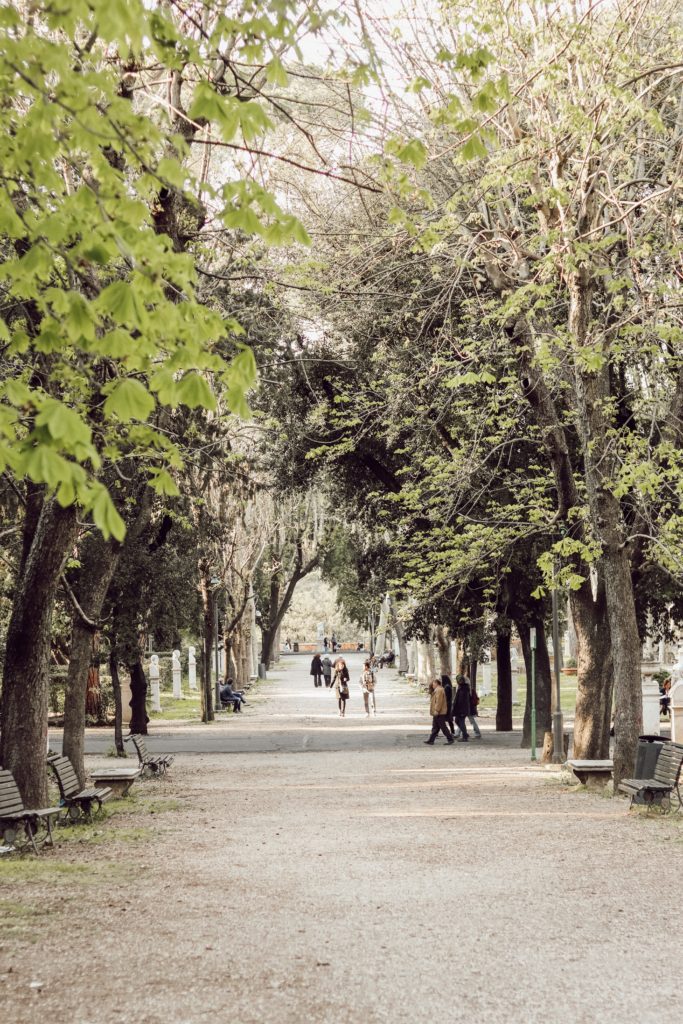
You could easily spend a half-day strolling the paths, visiting the museum, or renting bicycles and exploring the “secret gardens”. You’ll also be rewarded with spectacular views over the city.
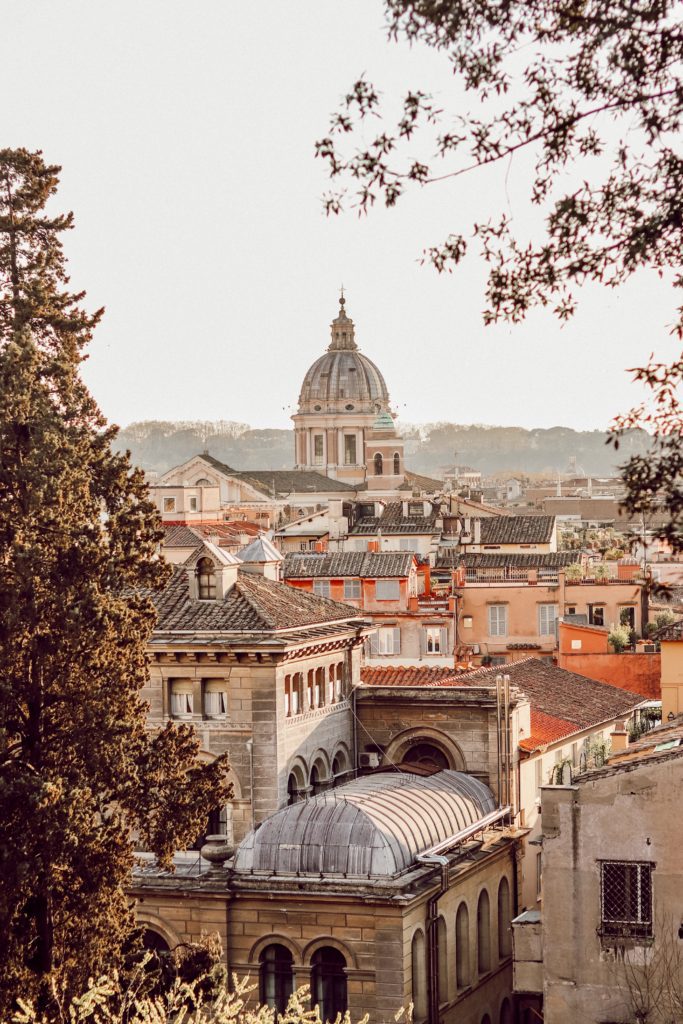
We didn’t have much time to spend here, but click the link for more information about visiting the gardens .
From the Spanish Steps, head over to the Pantheon and prepare to be amazed.
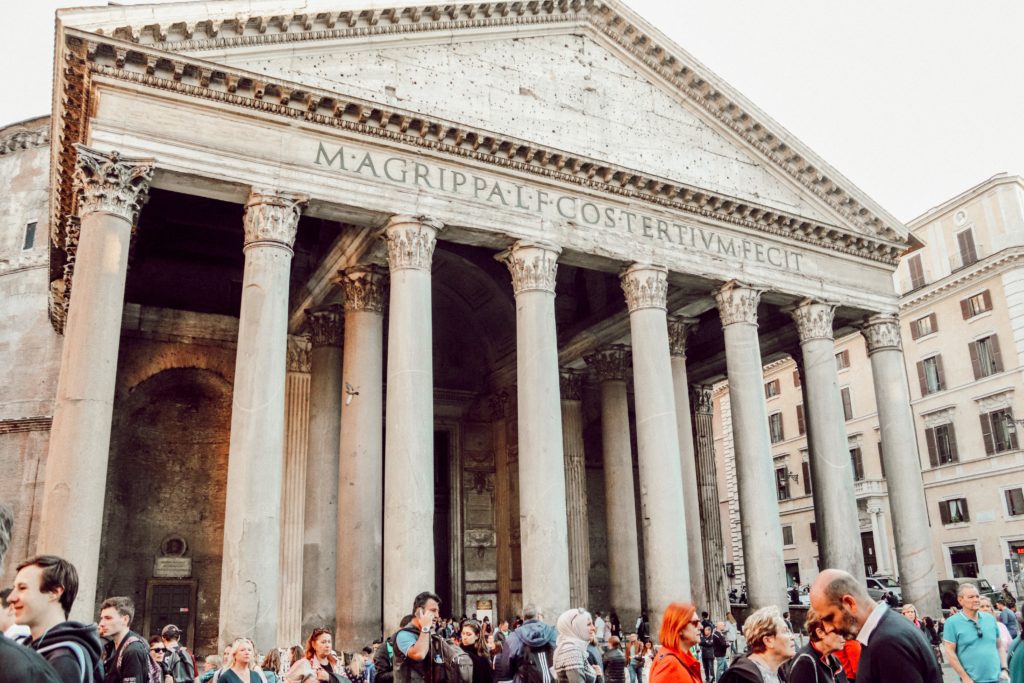
I had seen pictures, but pictures can not do the Pantheon justice. The sheer scale of the columns alone is enough to leave you speechless.
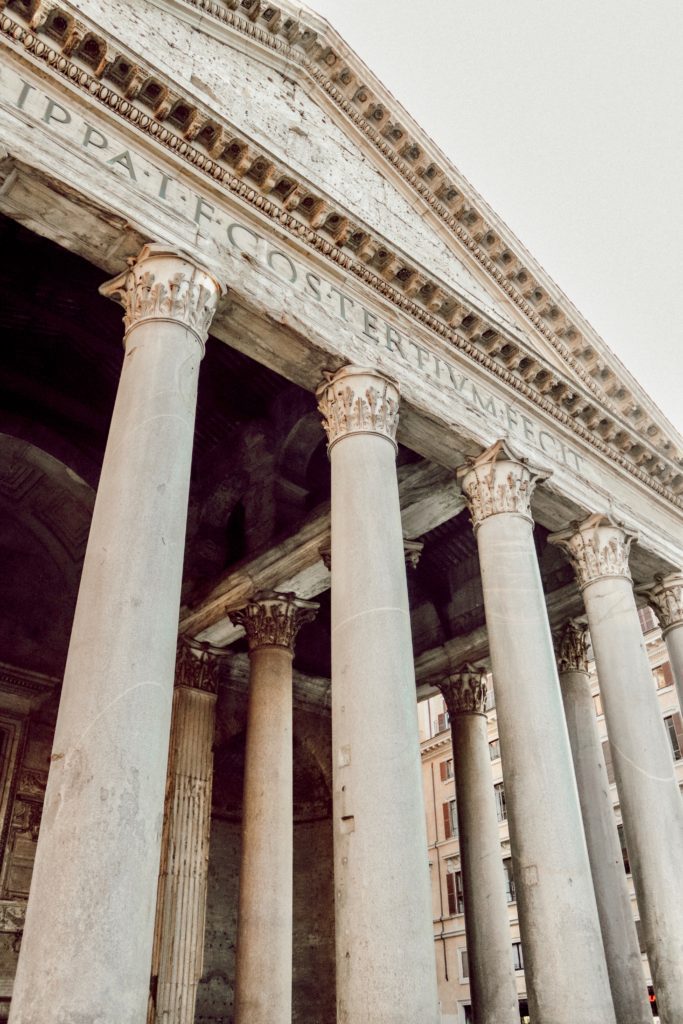
As you enter the 2000-year-old temple through the double 21-foot bronze doors, your eyes will be immediately drawn up to the enormous domed ceiling.
This is the largest non-reinforced dome in the world and it is unfathomable to consider the logistics of how it was constructed by hand 2000 years ago.
At the center of the dome, you’ll find the Oculus. This is an open hole, so notice the drains on the floor to catch the rain if it comes in.
If you’re lucky enough, you’ll see the sun shining through and creating the world’s longest pillar of light at 142 feet.
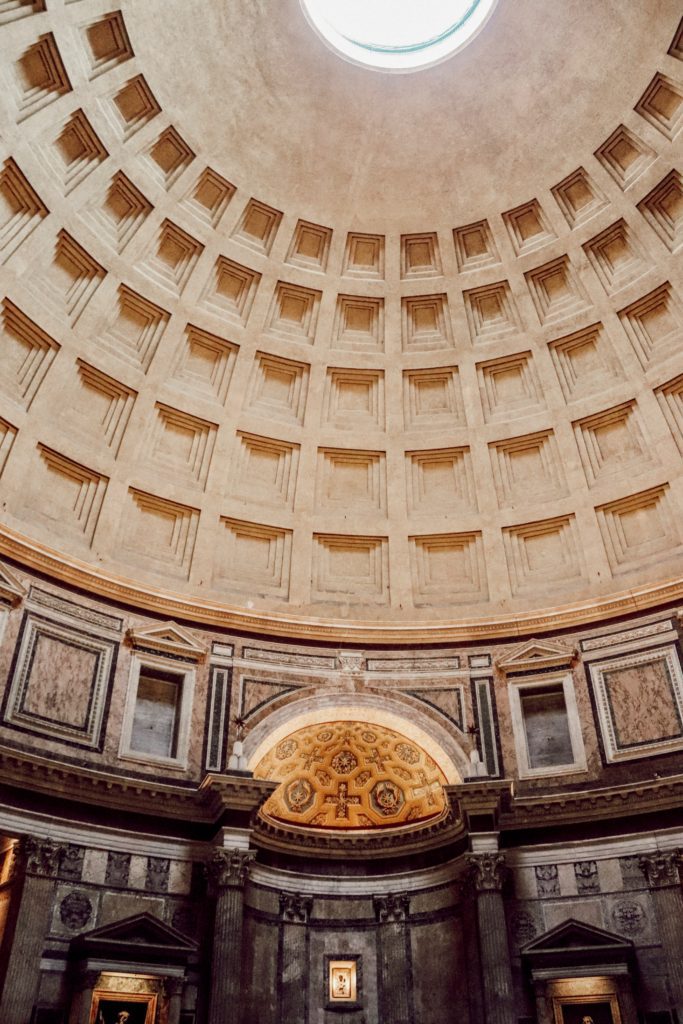
The Pantheon is one of the most well-preserved buildings in all of Rome. It was originally a temple but is currently an active church. In fact, it has been in continuous use since it was first dedicated.
It is also the final resting place for Victor Emmanuel II (the first king of unified Italy), Raphael, and other beloved artists and notable dignitaries.
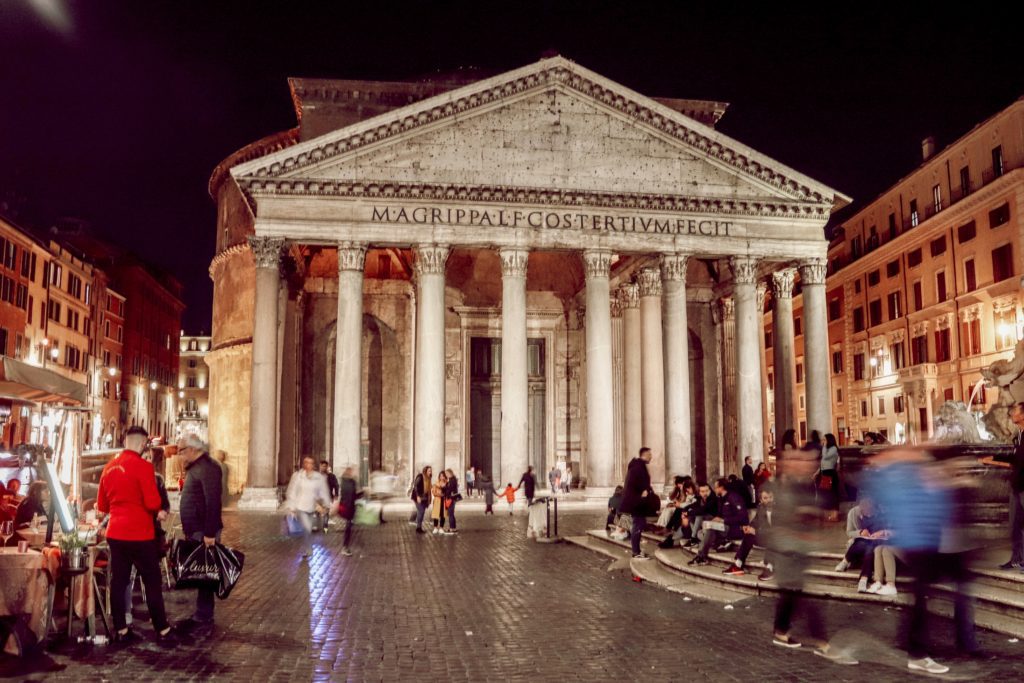
Entrance is free and a visit is definitely one of the top things to do in Rome. The square surrounding the Pantheon is dotted with cafes, street buskers, and a fountain (one of the 280 fountains you’ll find in the city).
Not far from the Pantheon, you’ll find our favorite gelato shop, Gelateria del Teatro.
I would recommend the Ricotta + Fig, or the White Chocolate + Basil. You have to get adventurous and try unique flavors when in Rome! At only about 3 euro a cone, you can afford to go back and try a variety of flavor combinations!

Gelato shops are a dime a dozen around the city, but a friend shared a tip on how to spot authentic gelato. The real stuff is kept flat in the metal tins.
If you look into a shop and see the gelato whipped high and fluffy, just keep walking. It’s like the Dairy Queen version whipped with additives.
Around the corner, you’ll find the cutest little alley that captures the essence of Rome. It used to be a cafe with outdoor seating (Cucina del Teatro), I was sad to see that it had closed down.
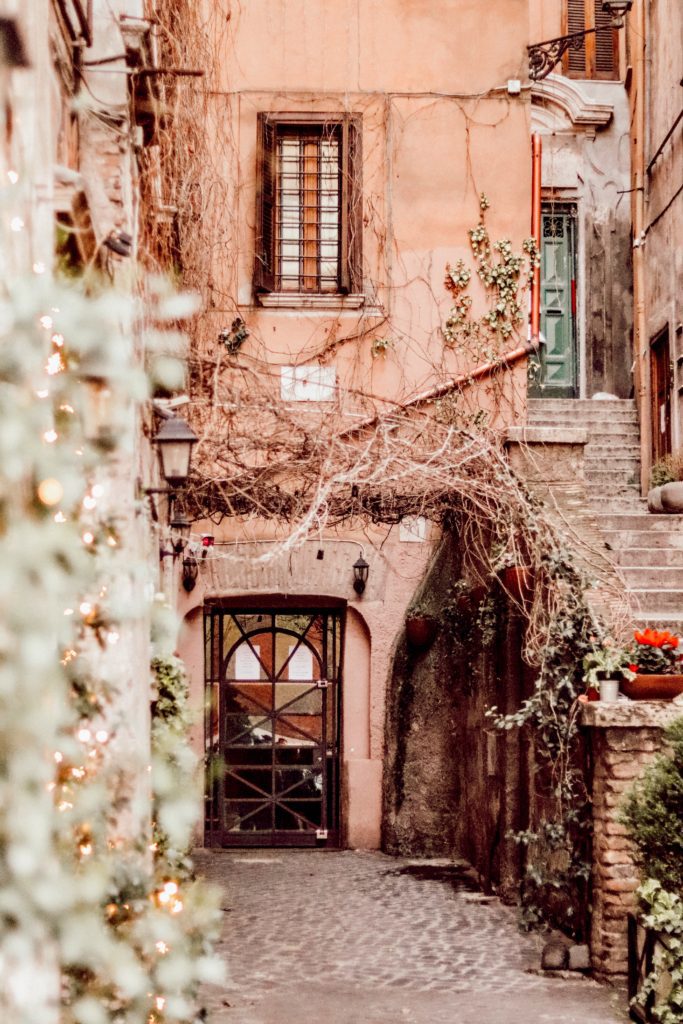
You’ll find many Piazzas scattered throughout the city that are an irresistible mecca for tourists and locals alike. Two notable Piazzas near the Pantheon are Piazza Navona and Campo di Fiori.
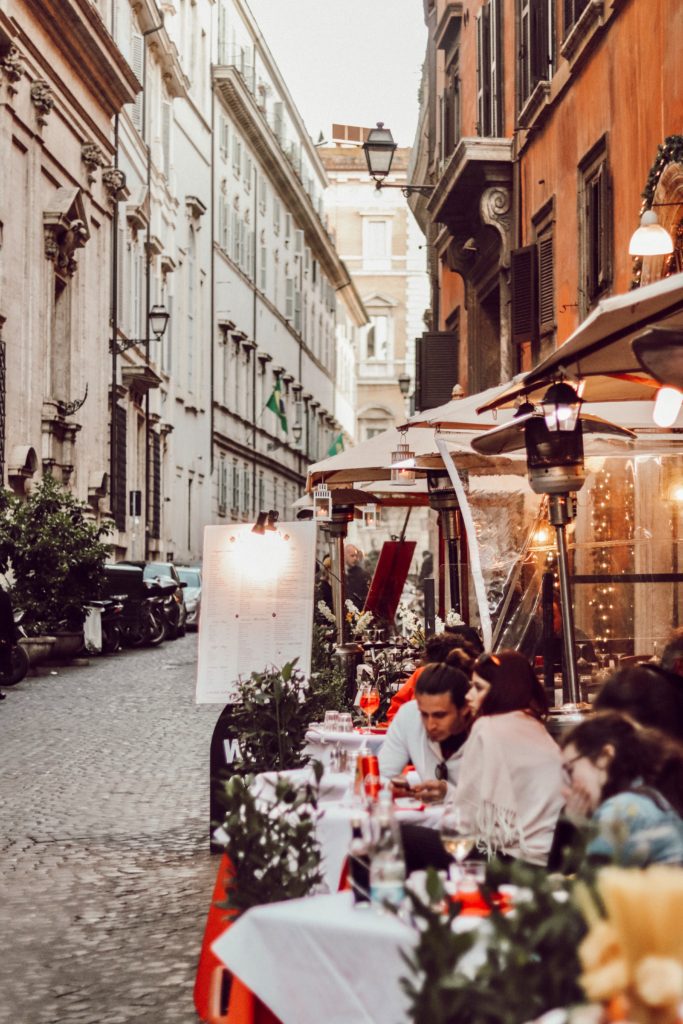
They are both lined with shops, cafes, churches, and winding side streets.
In the center of Piazza Navona, you’ll find Bernini’s Fountain of Rivers. Campo di Fiori is home to the statue of the philosopher Giordano Bruno.
Music fills the air of both Piazzas as you stroll around shopping for trinkets and admiring the work of local artists. It is the perfect spot to spend a warm summer evening.
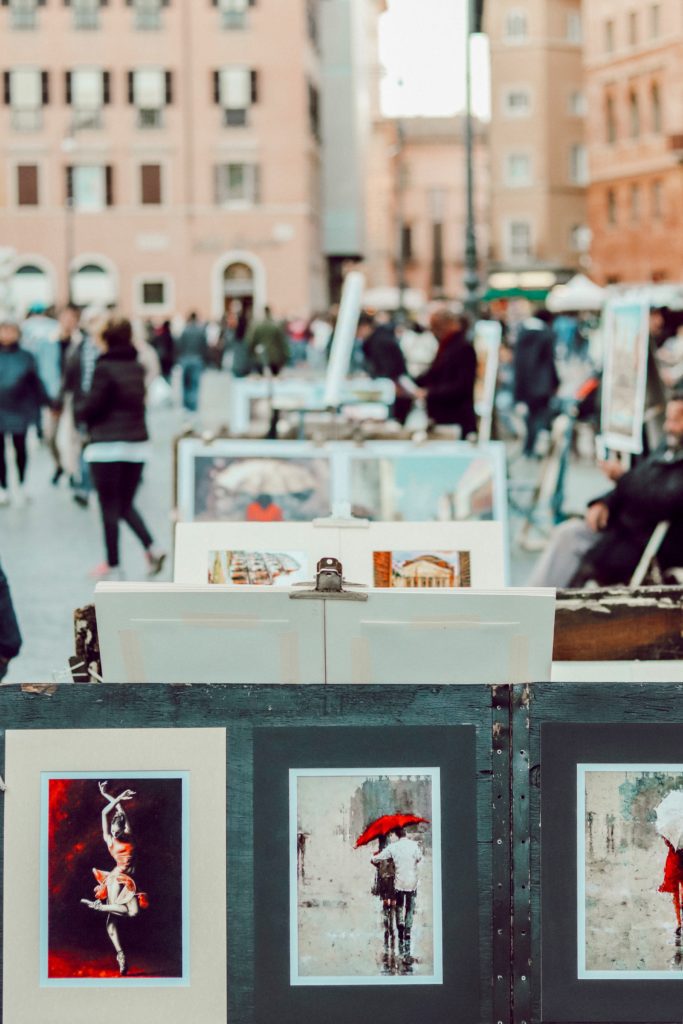
Campo di Fiori hosts a morning market selling fresh produce and goods from local artisans. It is reminiscent of a busy medieval marketplace.

If you’re looking for a place to eat near Piazza Navona, Pizzeria Baffetto was recommended as a delicious and inexpensive option.
The Castel Sant’ Angelo (Castle of the Holy Angel) is situated on the banks of the Tiber River. This building has had an interesting history over the years.
This imposing structure was originally constructed as a mausoleum for the emperor Hadrian and his family in 130 AD.
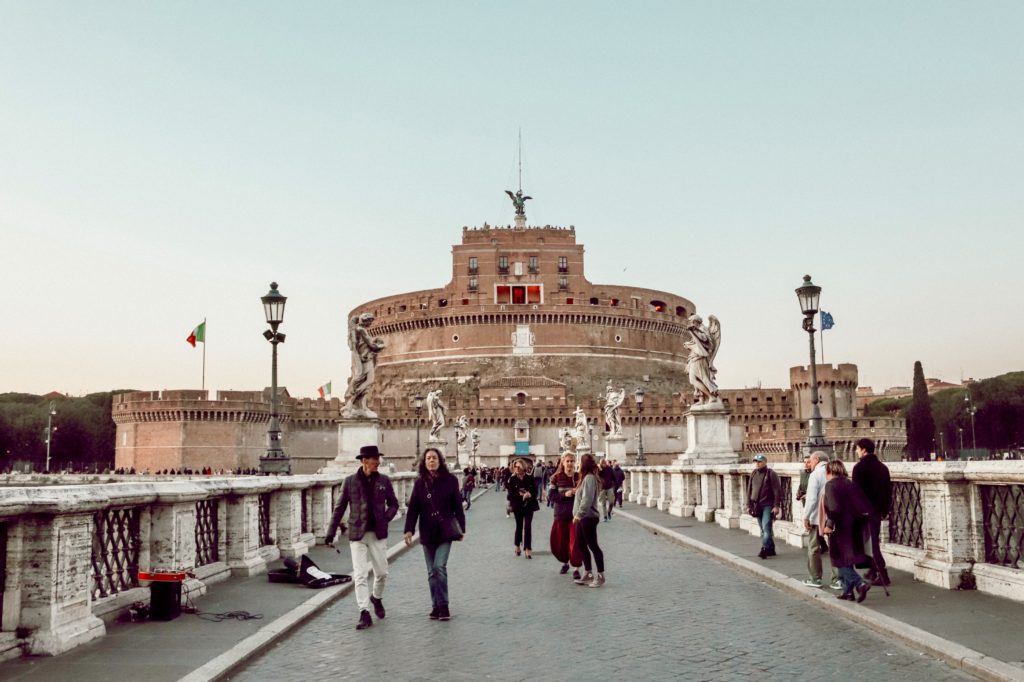
It was later incorporated into the city wall and became an impenetrable fortress defending the northern entrance of Rome during the barbaric invasions.
In the 14th century, a secret fortified passageway from the Vatican was constructed for the protection of the pope and papal community. A treasury room was also created to safeguard the pope’s valuables.
A more dark and sinister part of the mausoleum’s history includes being used as a brutal prison where prisoners were tortured and even executed in the courtyard. Today the Castel Sant’ Angelo serves as a museum.
The museum can be reached by crossing a bridge over the Tiber River. The Tiber River has long since been an important vein running through the heart of Rome.
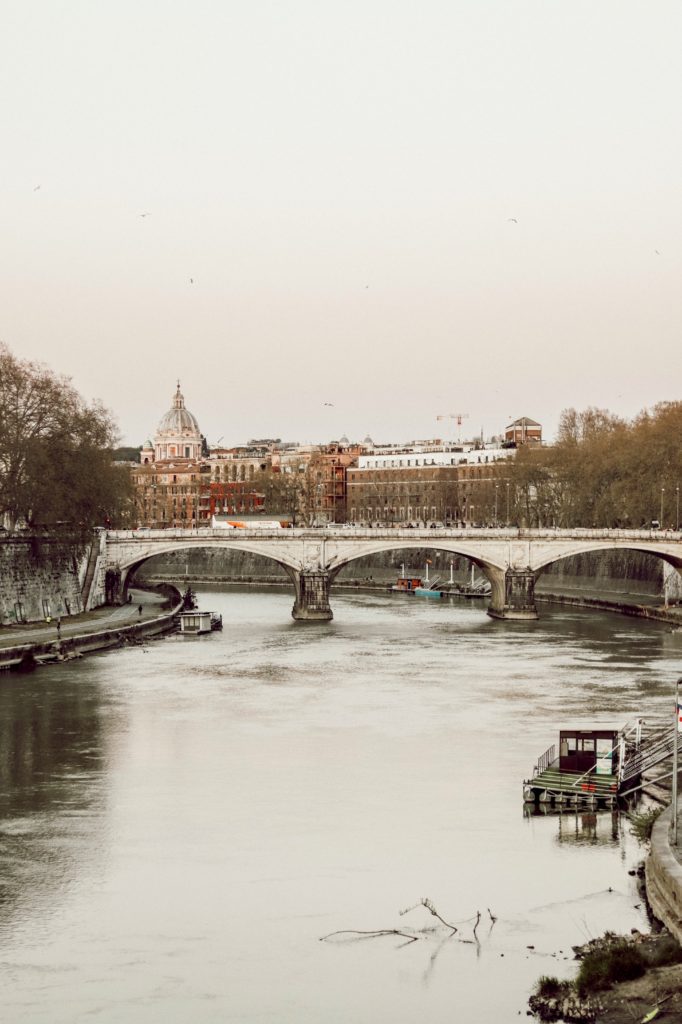
It served a vital role in the early trade and commerce of the city as ships brought goods up and down the river.
Legend also has it that the founders of Rome, twins Romulus and Remus, were abandoned as infants on the banks of the Tiber River where they were rescued by the she-wolf, Lupa.
Today you can enjoy a leisurely scenic stroll along the banks where you can find multiple bridge crossings leading to the Vatican City and Travestere.
You could easily spend a half day exploring Vatican City.
Considered the world’s smallest country, Vatican City is home to St Peter’s Basilica, the Vatican Museum (where you can find Michelangelo’s Sistine Chapel), and the Vatican Gardens.

The Vatican Museum is a feast for the eyes and can be borderline sensory overload.
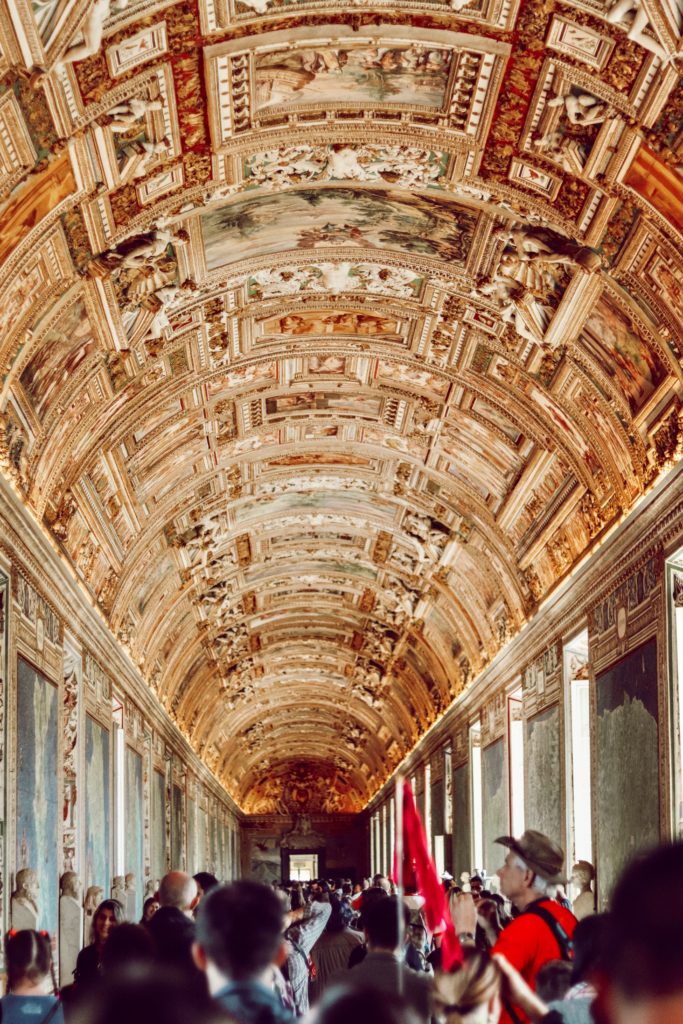
With over 20,000 of the most renowned sculptures and Renaissance masterpieces, it is one of the largest museums in the world and the 4th most visited.
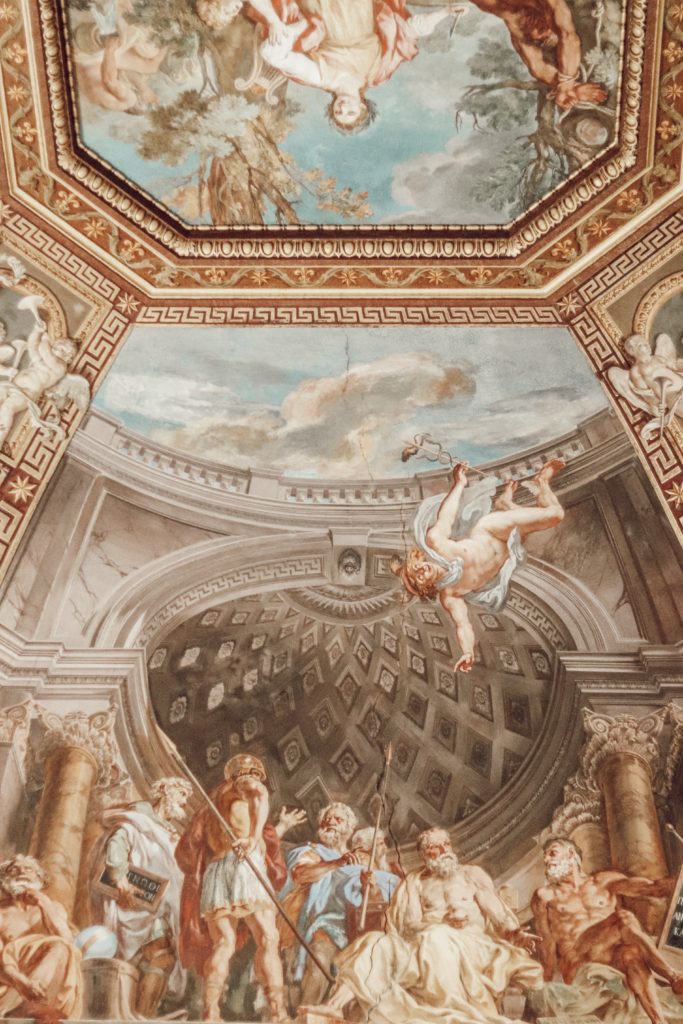
There is just so much to take in, each opulent room is in competition with the next.
Visitors are herded through a maze of seemingly endless hallways and rooms until finally reaching the crowning jewel, the Sistine Chapel.
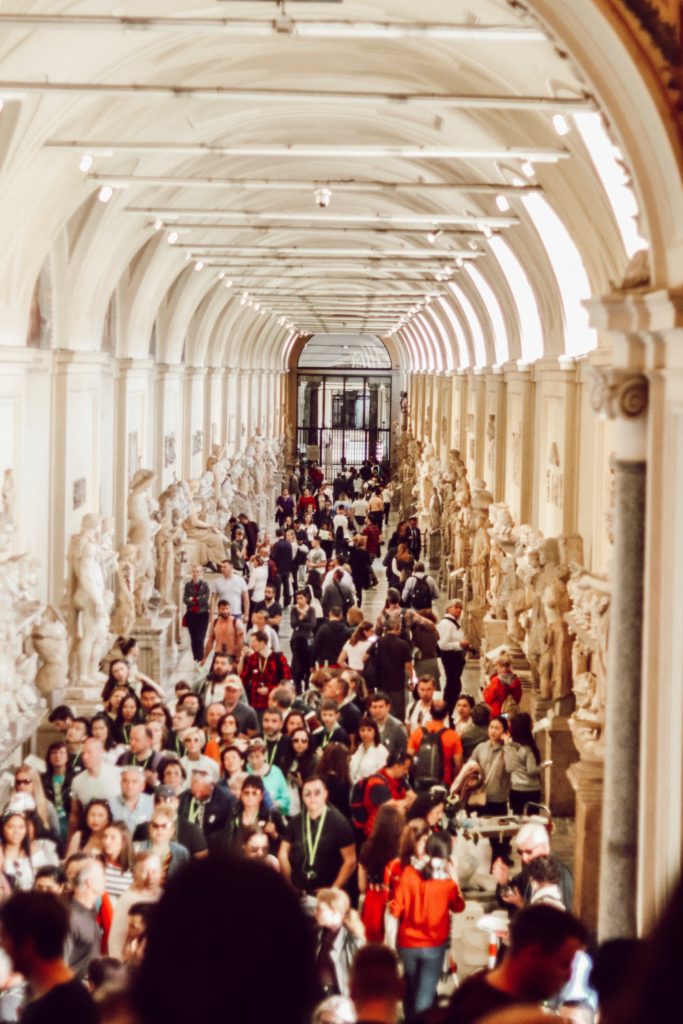
Although it is a bit claustrophobic at times, it is worth a visit. Experiencing one of Michelangelo’s greatest works of art in person is surreal.
No matter what time of year you visit, it is bound to be crowded so a skip the line ticket is highly recommended. If you want to visit the Vatican Gardens, that requires a separate ticket.
Near the entrance to the Vatican Museum, you’ll find an excellent sandwich shop called Deucentogradi, or 200 Gradi. This was a local referral from our Airbnb host so we knew it would be good.
There is a wide selection and the ingredients are fresh. The bread is perfectly crusty and chewy, I am still craving it!
Continue around the city wall to enter Saint Peter’s Square. Here you’ll find St Peter’s Basilica. This is the burial place for St Peter and has the largest interior of any Christian church.
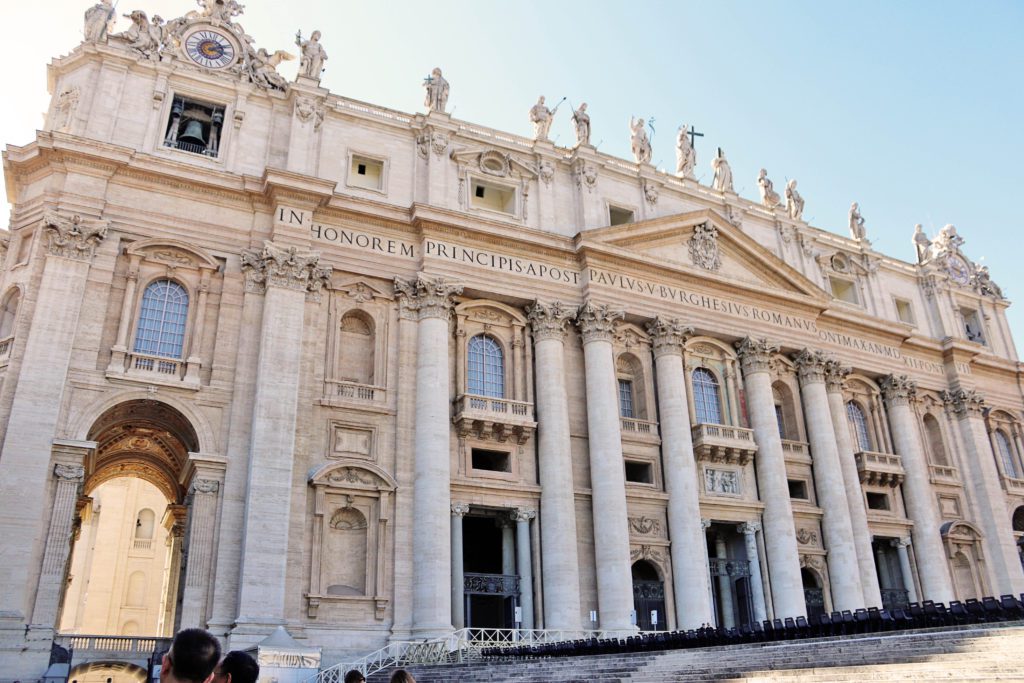
Entrance is free but there is often a long line to get through security. You can purchase skip the line tickets as well as tickets to climb to the top of the dome (“cupola”).
Or an insider tip is that you can purchase tickets in the gift shop across the way.
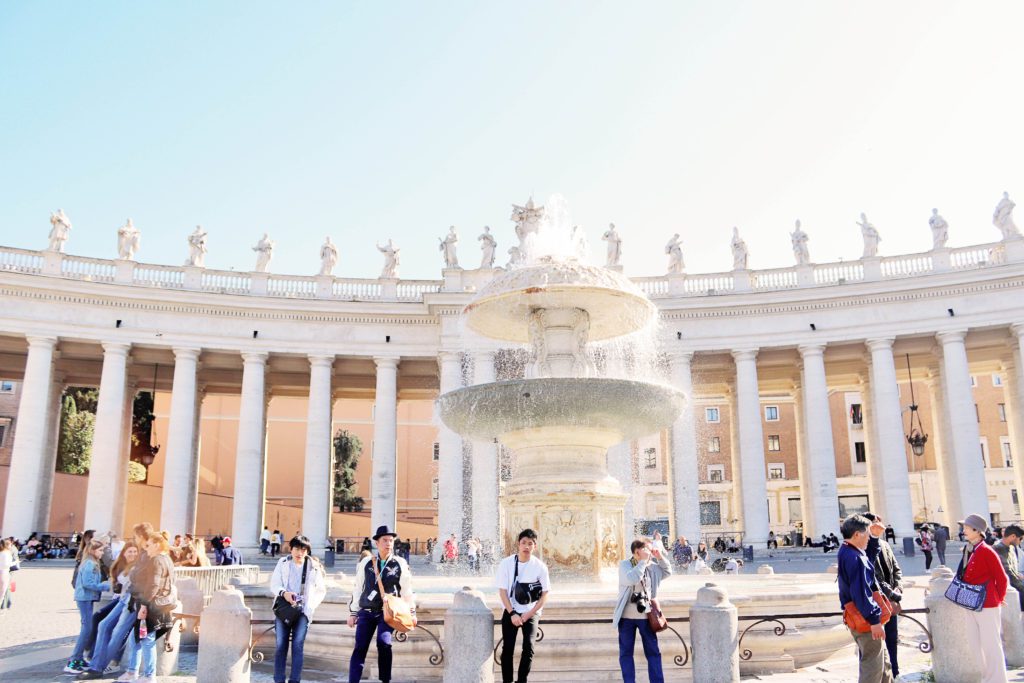
To access the dome, you can climb 320 steps or pay extra to take an elevator to the roof level. From there it is an additional 231 steps to the top of the dome.
We opted not to do this due to my claustrophobia, but the views from the top look spectacular.
The best time to visit is first thing in the morning when the crowds are smaller and the square takes on a more reverent and tranquil feel.
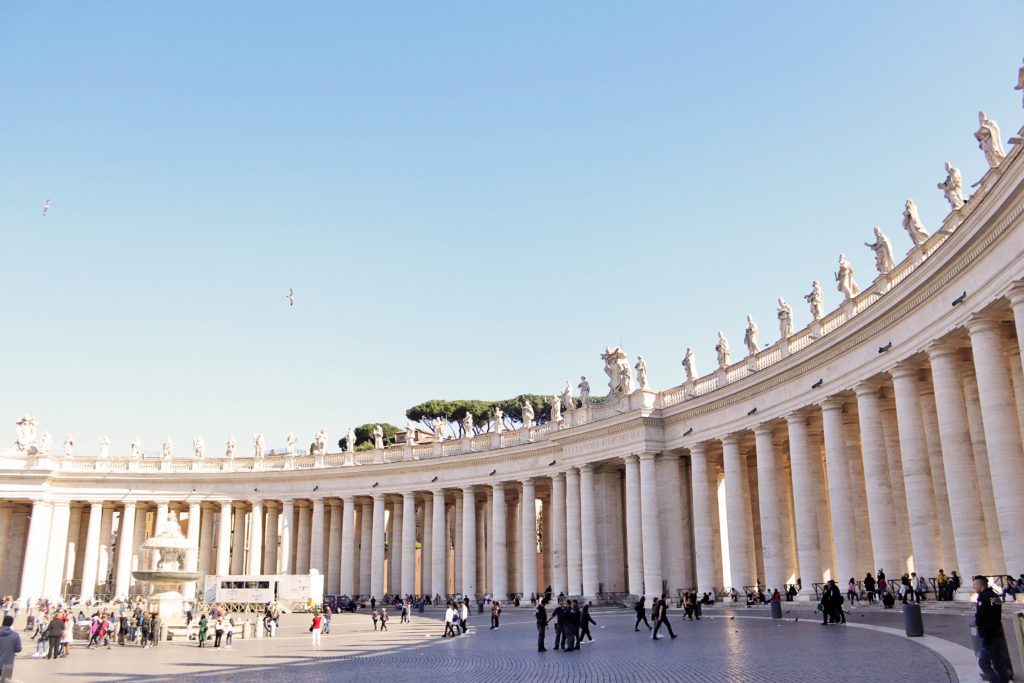
Travestere has a reputation for being the most authentic neighborhood in Rome.
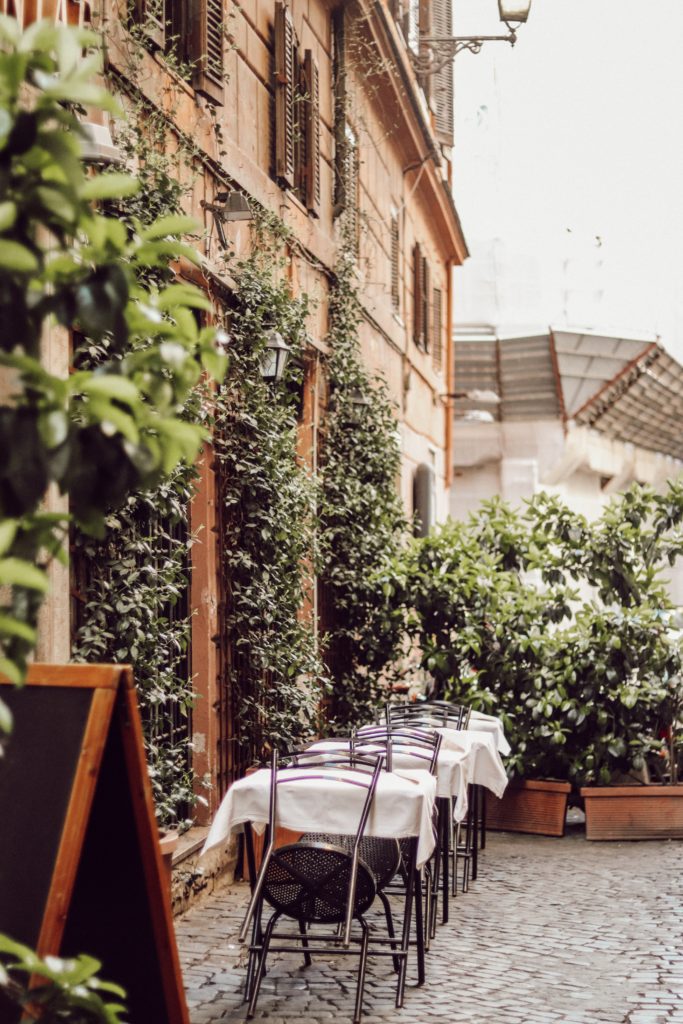
It’s the kind of place where you’ll find yourself getting willingly lost in the meandering streets.
Travestere is full of personality, with laundry hanging on lines, vines growing up the side of weathered buildings and loud laughter spilling out from bars. It is the perfect blend of subtle sophistication and a comfortable low-key vibe.
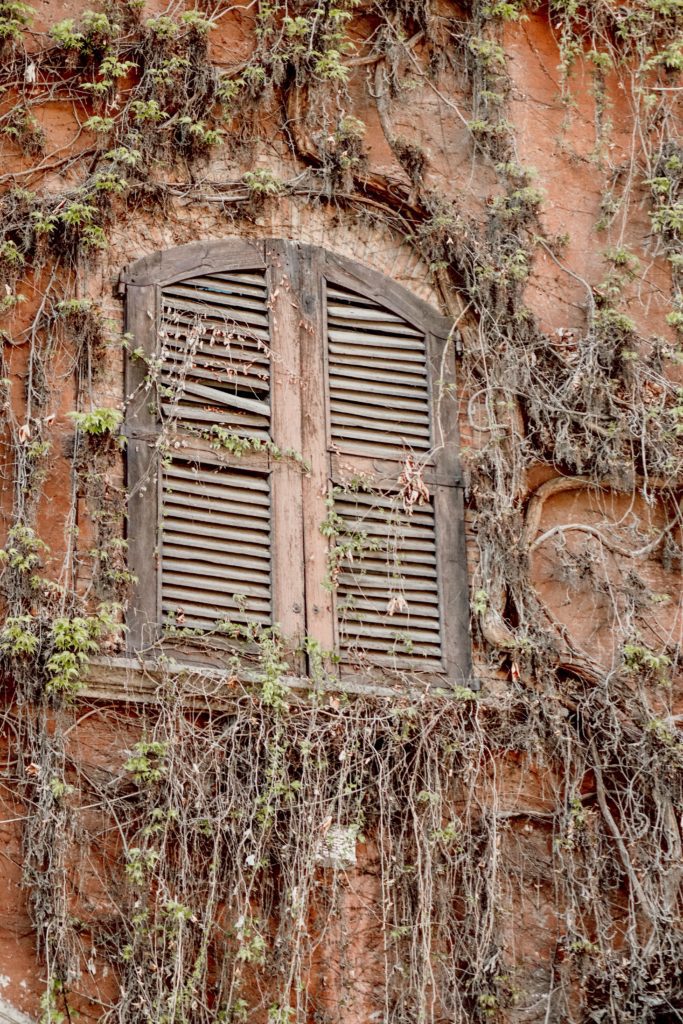
You’ll find plenty of spots to satisfy your craving for a home-cooked Italian meal. Dar Poeta was recommended to us by friends as well as our Airbnb host.
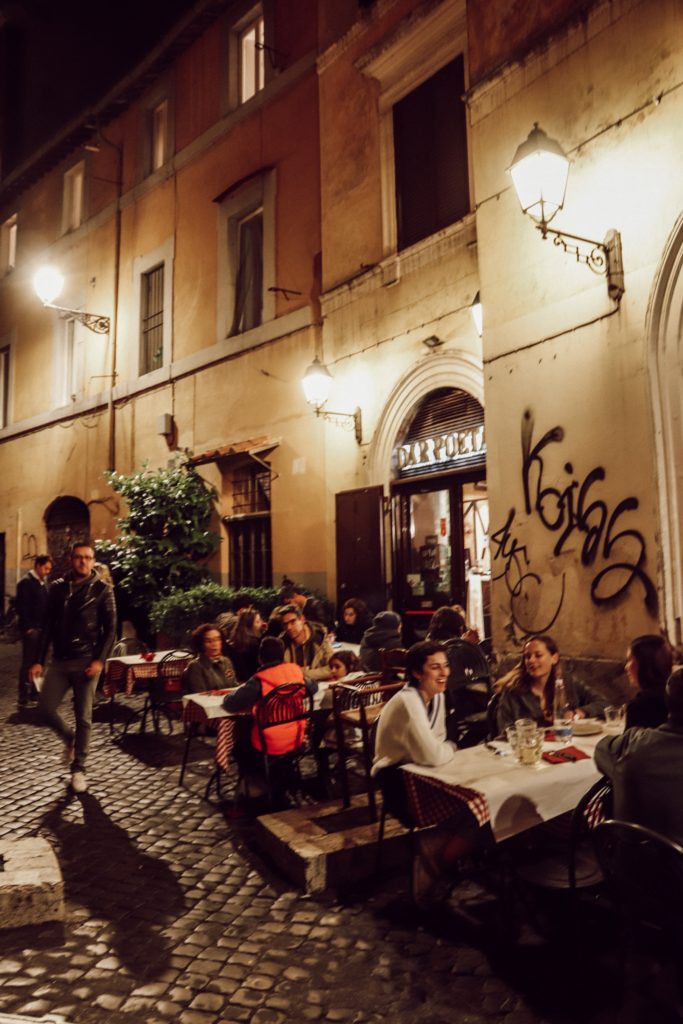
We ate here for our last meal in Rome. We enjoyed fire-baked pizza while tucked in an alley underneath a starry sky. It was perfection.
You have to order their Ricotta and Nutella calzone. We took ours to go and it made for the perfect midnight snack.
Impiccetta is also a favorite Trastevere restaurant among locals.
My hope is that this guide will help you make the most of your time in Rome as you fall in love with the Eternal City!
Related Posts:
- How to Spend One Day in Florence
- 5 of the Best Places to Go on the Amalfi Coast
- The Best Things to Do in Venice
- 8 Things to See in Taormina, Sicily
- The Best Things to Do in Naples
Pin it for later:
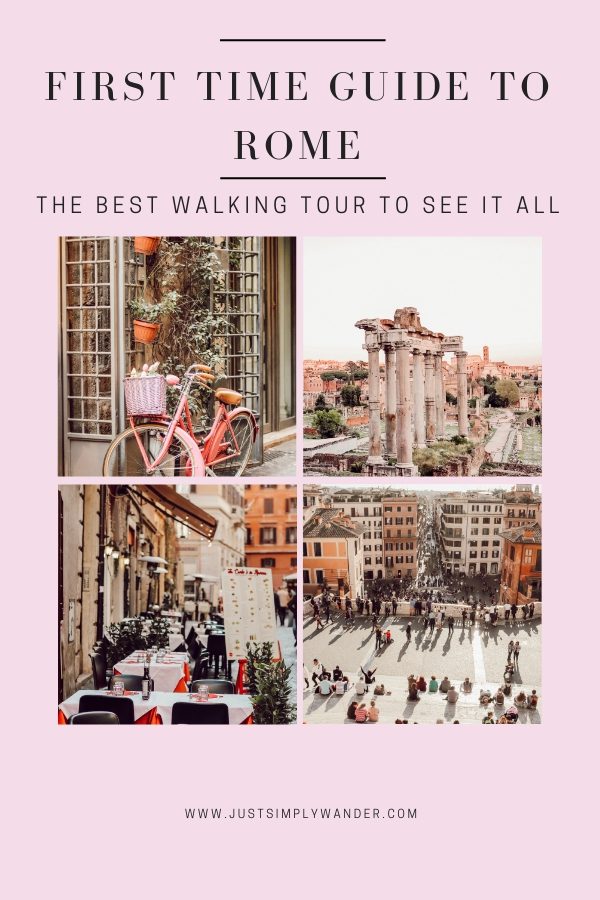
About Jamie
Family travel expert and content creator who has been inpsiring millions with her travel guides since 2018.

You’ll Also Love
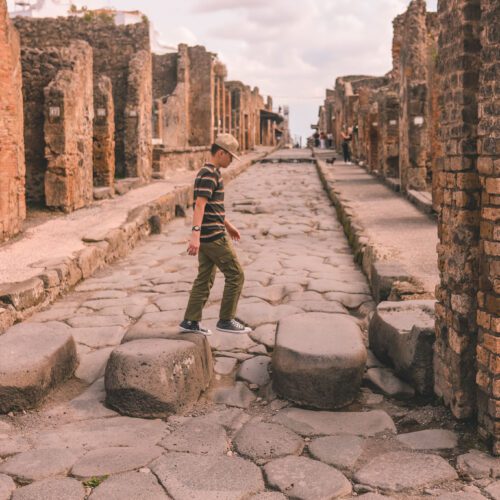
Reader Interactions
April 29, 2019 at 11:04 pm
Love your pictures. It’s a very detailed post. My kids haven’t been, but we have twice. It’s a great wrap up!
April 29, 2019 at 11:56 pm
Lucky that you’ve been twice! We fell in love and are already figuring out how we can get back there! I would love to take our kids next time too!
April 29, 2019 at 11:17 pm
First of all – your photos are STUNNING! I literally want to book a trip to Italy right now! Saving this for the future – walking tour sounds like the perfect way to explore in Rome!!
April 29, 2019 at 11:55 pm
Thank you, Amanda! So glad it has inspired you to visit, hopefully you get a chance to go, you will love it!
April 30, 2019 at 5:17 pm
I am so inspired to visit Rome after reading this post! So much great info and I seriously want to pin like every picture!!! Just beautiful! Thanks for sharing!
May 1, 2019 at 3:57 am
I’m so glad it has inspired you! I’m excited about your upcoming trip to Italy, you’re going to love it!
May 1, 2019 at 9:43 am
Oh my goodness those crowds!! Love this walking round up, so going to follow it the next time we’re in Rome!
May 3, 2019 at 7:22 pm
Seriously! We planned our trip in March because we heard that was the offseason, if that is the case then I wouldn’t want to travel in the summer during peak season! It really was lovely though, and I’m so glad you found this helpful!
May 5, 2019 at 2:25 pm
This is perfect! You’ve got me itching to go back to Rome.
May 6, 2019 at 4:45 pm
Lucky that you’ve been before! I’m already itching to go back too!
May 7, 2019 at 5:27 pm
My goodness these pictures are amazing! I’m definitely taking the kids some day!
April 13, 2020 at 7:54 am
Wow, incredible blog layout! How long have you been blogging for? you make blogging look easy. The overall look of your site is wonderful, as well as the content!
[…] you’re visiting other regions of Italy, you’re not going to want to miss our guides for Rome, Tuscany, Florence, Venice, and […]
[…] sure to see our guides for Rome and Venice as […]
Leave a Reply Cancel reply
Your email address will not be published. Required fields are marked *
Copyright © 2024 Simply Wander · Theme by 17th Avenue

How to Buy Pantheon Tickets in Rome

How to skip the line at St Peter’s Basilica

How to skip the line at the Borghese Gallery

How to skip the line at the Colosseum – 2024

How to skip the lines at the Pantheon

How to skip the lines at the Vatican – 2024

Should I get a Roma Pass?

The best time of day to visit the Colosseum

The best time of day to visit the Vatican Museums | Opening hours 2024

The cheapest way to skip the lines at the Vatican | 2024

What are the official websites to buy tickets for Rome’s major attractions?

Vatican and Sistine Chapel tickets

How to get past Colosseum ticket buying problems – 2024

How do I travel to Rome from Fiumicino airport? 2024

How do I get into Rome from Ciampino Airport? 2024

How do I book train tickets around Italy?

Hop-on-hop off bus tours

August 15th is Ferragosto, a national holiday, and many things in Rome are shut

How do I buy a slice of pizza in Rome?

How do I buy cigarettes in Rome?

How do I mail a letter in Rome?

How do you use the bidet when on vacation in Rome?

How much cash to bring with you to Italy

How to buy vape supplies, e-cigarettes and juice in Rome

How to cross the street in Rome (and live to tell the tale!)

How to get English-speaking medical treatment in Rome

How to order a coffee in Rome

How to visit Rome with children

How to visit Rome’s Olympic Stadium

How to visit the mosque in Rome

The difference between St. Peter’s Basilica, the Sistine Chapel, and the Vatican

The difference between the Colosseum, Roman Forum, and Palatine Hill

What is the dress code in Rome?

What kind of electrical adapter do I need to bring to Italy?
What should I see if I have only one day in Rome?

Where are the best views of Rome?

Where can I buy a used bike in Rome?

Where can I find a wifi cafe in Rome to work in? 2024

Where can I run in Rome?

Where’s the bathroom in Rome?

12 reasons you shouldn’t drive a car in Rome

Avoid common problems with Rome’s public transport

Can I travel to Rome at the moment?

- Can I use Uber or Lyft in Rome? 2024

Getting to and from Rome Ciampino airport at night

How do I get to and from Fiumicino Airport (FCO) at night?

How to buy a ticket for Rome’s public transport system using an app

How to get from Rome’s Civitavecchia port into the city

- How to not get pickpocketed

How to use Rome’s public transportation network – with map – 2024

Rome’s “secret” train that gets you across the city in 20 minutes – for only 1 euro

Scooter sharing: renting an electric scooter in Rome
The best way to get from the airports into Rome (and back again)

Aperitivo: Rome’s low-cost drink and food extravaganza

Become a Spritz Specialist and a Pasta Pundit

Beer in Rome

Do I need to tip in Rome?

Food tour in the heart of Rome

Hooch and History: the Tipsy Tour of Rome

How to avoid being ripped off at a tourist trap restaurant in Italy

How to cook perfect pasta

How to eat gluten free in Rome

How to eat vegan and vegetarian in Rome

How to use an Italian stovetop coffee pot

Pasta and Tiramisu class

The truth about sandwiches in Rome

What to order in a restaurant in Rome

What’s the difference between a Ristorante, an Osteria, and a Trattoria?

Why you never need to buy water in Rome
- Where to stay in Rome

Colosseum Arena tour with Forum and Palatine Hill

How to visit the Coppedè Quarter in Rome

Off the beaten track to see the beaten track: Via Flaminia Antica

Orientation tour: self-guided piazza walk

Rome Vacation Tips Eternal City Night Walk

Rome Vacation Tips guided walk of the Baroque City

Rome Vacation Tips tour of the Colosseum, Forum, and Palatine Hill

Rome Vacation Tips VIP Vatican Tour

Self-guided walking tour around the ancient city

Terrifying ghost tour of haunted Rome

The Popes, Domes, and Tombs Tour of St Peter’s

Where can I see Caravaggios for free in Rome?

Basilica di San Clemente: the most interesting historical site in Rome

Guided Modern Architecture Tour Of Rome

Guided Street Art Tour in Rome
Incredible places in Rome you don’t need to book ahead for

Rome’s other “Jewish ghetto”

San Lorenzo in Miranda – a church in a temple

The optical illusion of St Peter’s Basilica from Via Niccolò Piccolomini

Villa Torlonia: ersatz architecture and Mussolini’s home in Rome

Where can I see street art in Rome?

Can I splash in the fountains in Rome?

How to avoid the African bracelet scam

How to get a Covid test in Rome with English language certificate – 2024 update

Special rules for visiting the Vatican during the coronavirus pandemic

What to do in Rome in an emergency

What’s with all the trash in Rome?

Why do shopkeepers in Rome never seem to have any change?
- Book train tickets around Italy
- Day trip to Tuscany
- Day trip to Pompeii
- Things to do in Florence
- Things to do in Milan
- Things to do in Naples
- Things to do in Tivoli
- Things to do in Venice
- How to Vacation in Dublin
- How to vacation in Istanbul
This free self-guided walk takes you from the site of Caesar’s death to Rome’s own pyramid, taking in the original Jewish Ghetto and the most beautiful view of the most beautiful city on earth.
Distance: 2.5 miles (3.75 km) Approximate length: 3 hours
Key to map below
This tour starts at Largo di Torre Argentina. Though not near a metro station, it is just a few steps down Via del Plebiscito from Piazza Venezia with its prominent ‘wedding-cake’ building that can be seen from everywhere in the city. The Largo is surrounded by buildings, trams, a main road, and bus stops, but it is historically very significant. Below the level of the street is an exposed part of the Roman Forum, containing four temples. Of greatest interest though, on the side flanked by the tram terminus, is the location of the Curia of Pompey.

Pompey (Gnaeus Pompeius Magnus) was a hugely successful general who expanded the Roman territories enormously, with successful campaigns in Sicily, in North Africa, the Iberian peninsula, Crete, Jerusalem, and as far east as the Black Sea. He was the youngest-ever elected Consul of Rome, aged only 35. As part of his second consulship he rewarded the people of Rome by building them a gigantic theater (the first and largest permanent stone theater in the ancient city). The theater is long gone, though a look at a map shows that its semicircular shape is still etched in the streets to the west of the Largo.
Julius Caesar, a former ally of Pompey’s and the father of his beloved wife Julia, fell out with Pompey following Julia’s death, and began to challenge his consulship. This led to Caesar’s armies crossing the Rubicon (that’s where that phrase comes from – the Rubicon was a river in northern Italy) to attack Pompey’s troops, force them south and eventually to invade Rome and be proclaimed ‘dictator for life’ in 44BC.
Caesar did not like the location of the Senate Building (which still stands in the Roman Forum) because the Forum was by then incredibly crowded, dirty, and prone to flooding. He temporarily moved Senate operations to a small meeting hall standing among the columns of the courtyard in front of the theater: the Curia of Pompey. Less than a month after his appointment as dictator, it was here that Caesar was stabbed to death by his Senators. The location of his death has recently been hypothesized to be in the exact place where you are now standing: Caesar’s great nephew (and adopted son) Augustus had an ‘altar’ built in the place where his father fell, and that block of concrete is in the square you are now looking into.
From here, walk towards the medieval tower (‘the tower of the little Pope’) on the corner of the square. Opposite is Via Paganica. Stroll down this lane until you reach a charming piazza, and admire the beautiful, unusual, but amazingly detailed Fontana delle Tartarughe (Fountain of the Turtles), designed by Giacomo della Porta in the 16th century.

The Jewish Ghetto of Rome
This marks the edge of the Roman Ghetto. The first ever ghetto (the word is derived from the Italian word borghetto , meaning ‘little village’) was declared in 1555 by Pope Paul IV as a walled enclave in which Jewish residents of Rome were forced to live. Jews who lived elsewhere in the city, as they had done for 1,300 years when Jewish slaves were brought to Rome following the sack of Jerusalem, lost many rights and had to move to this area, which at the time was one of the worst parts of the city and subject to endless flooding.
Continue straight on through the piazza, down Via della Reginella, and as you walk down the lane, look out for discreet memorials embedded in walls and the ground to memorialize Jews who were murdered during the Second World War, as well as in an attack by the PLO in 1982.

Over the centuries the literal ghettoization of the population had some inadvertently positive effects: the walls protected its population from Christian mobs, and they were able to practice ancient traditions unmolested. To this day the area has a strongly proud and distinct Roman-Jewish identity, and in 1870 the Great Synagogue of Rome was constructed in the area.
The boundaries of the Ghetto expanded over the years, and eventually the walls became irrelevant. In the meantime a distinct Roman-Jewish culture had arisen, and of particular interest to the visitor is the unique Roman-Jewish cuisine, of which carciofo alla giudea (Jewish artichoke) is the most famous example. When you reach Via del Portico D’Ottavia turn left, and at this point it is highly recommended that you stop here at one of the many kosher restaurants to try one of the deep-fried Jewish artichokes – they’re delicious.

To learn more about Rome’s Jewish ghetto, take a guided walking tour >
After your snack, continuing a few dozen yards down Via del Portico D’Ottavia, just as the road turns to right you will see an ancient Roman temple and archway. This is the Portico of Octavia, built by Augustus Caesar in honor of his sister, which eventually became one of the world’s first art museums despite being partially destroyed in an earthquake. Beside the ruins there is a walkway that takes you down to the bottom of them. Follow this down and walk between the huge pillars.
Note: sometimes this walkway is closed. If it is, continue on to the end of Via del Portico D’Ottavia, noting the Great Synagogue on your right, turn left onto Lungotevere, then take the first left onto Vico Jugario and left again on to Via del Teatro di Marcello and walk about 100 yards to rejoin the route.

Eventually you will see the arches of the ‘mini Colosseum’ front of the Teatro di Marcello. This theater was completed in 13BC and was named for Caesar’s nephew Marcellus. It was free for all Roman citizens to watch dramatic performances. Particularly interesting is that the ancient structure was topped by a mansion in the 16th century for the Orsini family, which today is divided into apartments that are still occupied. Opposite the theater is the Temple of Apollo.

Turning right as you exit the theater complex, you will immediately see a church, in the walls of which are embedded pillars. This is the Basilica di San Nicola in Carcere (the basilica of St Nicholas in prison), and was built in the 12th century inside the location – and using the standing parts of – three Roman temples (dedicated to Janus, Juno and Spes). If the church is open, it is well worth entering, and paying €3 to descend into the fantastically spooky crypt, which contains the foundations of an earlier 6th century church, a Byzantine jail, and the mouldering bones of unidentified Christians.

Exiting the church and turning right you find yourself on Via Luigi Petroselli, a straight road lined with government offices. This is the final stretch of Mussolini’s grand road from Ostia on the sea. Looking at the 1920s buildings that line this street it is not difficult to see the link Mussolini was trying to draw between ancient Rome and his own regime.
Stay on this side of the street for a few more yards and you will see a little park with two beautifully preserved temples in it. The rectangular structure was built in the 1st century BC and was dedicated to Portunus, and as with most other well-preserved temples in the city owes its good state to having been used as a Christian church since 872. In particular, the Ionic columns in this temple inspired a generation of 18th century architects on the ‘grand tour’, and they were the model for such constructions throughout Europe.
Beyond this temple is an older, 2nd century BC round temple inspired by Greek architecture, dedicated to Hercules. Of the original 20 Corinthian columns, 19 remain, and there’s a local legend that flies and dogs cannot enter this temple. OK…
Beneath this piazza is part of the ‘cloaca maxima’, the ancient sewer of Rome that dates back to pre-Roman Etruscan times, and is still in partial use by the modern city. Opposite the piazza is the Arch of Janus, which was constructed from marble in the 4th century.
Further down the street, on the left, is the most disappointing attraction in Rome.

Audrey Hepburn and Gregory Peck may have had fun tempting the Bocca della Verità to bite their hands off by lying to it, but they visited the monument late at night and before it had been popularized by them messing with it in the movie Roman Holiday . These days it’s seriously oversubscribed and you need to wait in front of the Basilica di Santa Maria in Cosmedin, where it stands in the porch, in a busy street in the blazing sun with a bunch of other tourists for half an hour or so for your five-second selfie moment. While we don’t discourage you from doing this, it is possible to get a good view of the 1st-century marble mask, that probably originally came from a fountain, through the railings on the front of the church.
Continuing past the line of sweltering tourists and taking the first left onto Via della Creca, a hundred yards will bring you to the corner of the largest sports stadium ever built – in the entire history of the world. The Circus Maximus had a seating capacity of 250,000 people, and is where the chariot racing you see in Ben Hur took place, as well as many other sporting events. So popular was the stadium that the emperor’s palace, which you can see standing tall on the Palatine Hill above the Circus, extended continually towards the stadium so that the emperor could watch the racing without having to deal with the hoi polloi.

Today Circo Massimo is a public park, and its stone seats may still be there, but they are buried under the grass verges. The center of the stadium, the spina (spine), put in to stop the charioteers from cutting corners, is also still visible as a ridge. It was from the center of the spina that the obelisk in the middle of Piazza del Popolo was taken. If you want to take a detour to the far end – a distance of 2,000 feet (more than 600 meters) – you can see the only part of the stadium that is undergoing archaeological excavation, which has revealed seating and the passageways beneath the ‘bleachers’.
Otherwise, take the road that splits diagonally from the corner you’re on, Clivo dei Publici, and follow it as it winds up the Aventine Hill towards one of the most spectacular views in the world.
After a brief uphill stroll you will see some gates on your right. These are the main gates of the Giardino degli Aranci (Garden of the Oranges). This being Rome, they are permanently shut for no good reason, so continue for another few yards to the side entrance. This lovely, peaceful garden, full of orange trees, was originally part of a larger park, made in the 13th century for the Savelli family, but was completed in its present form in 1932. At the far side of the garden is a viewpoint that looks over the entire city, and – as at the Pincio – provides you with one of the most breathtaking looks at the beauty and ingenuity of human endeavor.

Leaving the park and continuing in the direction you came, you will pass the 5th century Santa Sabina church and monastery which is well worth a look inside. It’s the oldest continuously occupied basilica in the city, and has been restored to its original simple decor. The remnants of the Roman temple to Juno on which it was built are still visible inside, as well as a 14th century mosaic tomb. Just past it along the road is another small garden, then another church, and then a tiny piazza where you will usually see a short line of people waiting at a door on the right-hand side of the piazza.
This is the door of the headquarters of the Order of the Knights of Malta, an ancient chivalrous Catholic group that has international status. The keyhole in the door is a curiosity: it’s deliberately designed so that looking through it the viewer sees down a line of poplar trees straight to the dome of St Peter’s Basilica, several miles in the distance.

Having gazed at this small wonder, take the Via di Porta Lavernale opposite the door and passing the Catholic university of Sant’Anselmo all’Aventino on your right, head down the hill through a very posh part of Rome. After about five minutes you will join Via Asinio Pollione and then arrive at a t-junction with Via Marmorata.
Directly opposite you is a deli called Volpetti. This place is really worth a little diversion from this walk, as the foods in this shop, from all over Italy, are the best of the best, and the incredibly friendly staff are happy to give you little samples to tempt you to buy cheeses, meats, and a heap of other stuff. The only drawback to entering Volpetti is the amount of money you inadvertently spend when inside.
Turning left out of Via Asinio Pollione (or right out of Volpetti), you will pass two pleasing modern-era architectural achievements: the beautiful 1929 fire station on the right, and a little further on an early 1930s temple to the postal service – a shame the service itself still doesn’t match the modernism of its design.

If you take the path directly in front of the gate, to the far wall of the cemetery, to your left you will see one of the most moving statues in Rome: the Angel of Grief, made in 1894 by the sculptor William Wetmore Story for his wife; after completing the statue, he too died and was buried beneath the angel a year later.
In the alcove behind the angel is the memorial to the poet Shelley, who drowned off the coast of Tuscany in a boating accident, with its famous inscription:
Nothing of him that doth fade, But doth suffer a sea-change Into something rich and strange
Heading back to the main path and turning right leads one through the gap in the wall to the older, less crowded part of the cemetery, and at the far corner is the grave of Keats, unmarked because of the ‘bitterness of his heart’, and the even more famous inscription:
Here lies one whose name is writ in water.
Keats died of tuberculosis by the Spanish Steps , angry, desolate, recently arrived but dying, and hating Rome and its food (yes I’m mystified too). His new friend Joseph Severn looked after him in his final days and despite having only known him for four months – and in later life having been an accomplished painter in his own right – had himself and his son prominently interred alongside Keats.
You may want to spend a while here, despite its morbid nature. And despite the tumultuous traffic just outside the walls, there is a pervading sense of peace and tranquility in this place. It’s bucolic and meditative thanks to the original English planners, and has kept this nature thanks the efforts of the (mainly expatriate) volunteers who maintain it. I recommend a donation in the box as you leave to maintain their efforts.
While inside the walls of the cemetery, you will not have missed that towering above the lawn of the cemetery is the pyramid of Gaius Cestius. Cestius was not an emperor, but a magistrate. He had heard tales of the magnificent pyramids of Egypt and decided that he wanted one as his tomb – the impending tombs of important Romans being among the things they valued most even while they lived – and paid for one to be built while he was alive.

His architects didn’t know the precise proportions of an Egyptian pyramid, so when they constructed it from brick and concrete faced with marble, they set the base dimensions to be 100 Roman feet square at the base, but 125 Roman feet high. The result is that when it was finished in 12BC, they something that looks, well, a little bit pointy.
Despite its interior having been sacked and its ancient frescoes destroyed in the middle ages, its marble sides are remarkably intact and thanks both to the pyramid’s incorporation 300 years later into the Aurelian Walls, and also to recent restoration work, they shine white as they intended. Shelley, at Keats’s memorial, described it as “one keen pyramid with wedge sublime”.
Exiting the cemetery, this tour is at an end. You have several choices of where to go now: turn right and right again and you will be at Piramide Metro station from where you can go wherever you want to go in the city.
If you contine past Piramide onto Via Ostiense then turn left at Via Pellegrino Matteucci you will end up at ‘Eataly’, a vast and modern palace/supermarket dedicated to the best and most expensive of Italian food from all over the country.
Turn left, however, and you will end up at Monte Testaccio, a grassy hill made entirely of stacked Roman amphorae into which are dug many bars, clubs and restaurants. Heading right at the hill leads you into the heart of the Testaccio district, and its many amazing traditional Roman restaurants .
Whichever way you choose to go, you will have had just a taste of the ancient city; hopefully you will also go on to have more than a taste of some of the incredible food available in this area. Enjoy!
Key to walking tour of ancient Rome
1. largo di torre argentina.
Part of the Forum outside Pompey’s Theatre, the location of Caesar’s Senate, and where he was subsequently stabbed.
2. Turtle fountain
A strange yet compelling 16th century fountain featuring anatomically correct turtles.
3. Jewish Ghetto
The heart of oldest continuously occupied Jewish ghetto in the world.
4. Portico of Octavia
Once a walkway between temples, then one of the first art museums in the world.
5. Teatro Marcello
A theater to rival the Colosseum that was free to all Romans. Now the foundation for apartments.
6. San Nicola in Carcere
Interesting 12th century church embedded in three Roman temples, with a seriously spooky crypt.
7. Temple of Apollo Sosiano
Some of the best-preserved marble columns in Rome.
8. Temple of Portunus
The columns of this well-preserved temple were the inspiration for many 18th century architects.
9. Temple of Hercules Victor (Foro Boario)
A circular temple on Greek lines, apparently neither flies nor dogs can enter it. Yeah right.
10. Bocca della Verita (The Mouth of Truth)
Gregory and Audrey may have enjoyed lying to this marble face, but that was before everyone else wanted to do it too.
11. Circus Maximus
The largest stadium ever built, its 250,000 capacity is still overlooked by the vast Palatine palace.
12. Giardino degli Aranci (The Garden of the Oranges)
A quiet, beautiful place with Rome’s most stunning view.
13. Aventine Keyhole
Look through the keyhole to see… ?
14. Cimitero Acattolico (The ‘non-Catholic’ cemetery)
The last resting place of Keats, Shelley and Goethe, this is one of the most peaceful places in the city.
15. Piramide (The Pyramid)
This slightly-too-pointy ‘Piramide’ is beautifully preserved.
Now make sure you don’t miss out: plan your visit in advance:
| Plan your vacation
| emergency.
Read this now >
| Book your hotel
| popular articles.
- How to use Rome’s public transportation network – with map – 2024
- How to skip the lines at the Vatican – 2024
- How to skip the line at the Colosseum – 2024
| Recent articles

Related posts

Photo credit: AFP
Tickets in advance!
Because of ticket supply problems following the end of Covid restrictions, it is strongly advised that you buy tickets and tours in advance to visit attractions in Rome.
Buy your tickets now to avoid disappointment.

- Rome hotels
- Venice hotels
- Florence hotels
- Naples hotels
- Pisa hotels
- Sorrento hotels
- Rome Fiumicino Airport
- Rome Ciampino Airport
- Venice Marco Polo Airport
- Pisa Airport
- Naples Airport
- Civitavechia (Rome) Cruise Port
- Naples Cruise Port
- Rome public transport
- Venice water bus (vaporetto)
- Florence public transport
- Naples public transport
- Sorrento local buses beyond Amalfi
Rome self-guided sightseeing walks linking main sights
Some gentle walks linking the major sightseeing icons of rome.
The first thing to point out is that these self-guided walks in Rome are not meant to be serious hikes for the enthusiast, all are really no more than gentle strolls that connect the main sights of Rome.
These pages focus on independent, self-guided walks around Rome. If you are interested in taking a professional tour we also have pages with information and booking details: Professional walking tours in ancient Rome
In Rome there is something of interest almost around every corner. Many churches hardy thought worth mentioning in a guide book for Rome, would be major attractions in most other cities.
In the City of Rome, walking is by far the best way to explore the city. Much of the city is made up of narrow lanes and alleys impenetrable to tourist coaches (or even public buses come to that) so you miss a lot by not walking.
The walks guide you between the major sightseeing icons most first time visitors will have on their “must see” lists. 95% of the time along pedestrian only paths and lanes.
The walks concentrate on the logistics with basic information on what you will see. Most guide books have detailed street maps and hotels will normally distribute street maps adequate for these walks free of charge. There are of course Rome city maps you can purchase at newstands and tourist offices. A good guide book dedicated to Rome will greatly enhance your enjoyment of these walks.
There is little in the way of consistent official signage for the tourist that you can rely on for pedestrians. These walks connect the main sights by direct routes, but still take routes where there is something of interest around every corner.
We would encourage you not to use these routes as a straitjacket that cannot be detoured from - part of the experience is to make your own personal discoveries.
At the height of the summer it can get very hot in Rome, this is the only time that the weather in the form of heat is a factor on these walks so do take care to take on lots of fluids at this time of year.
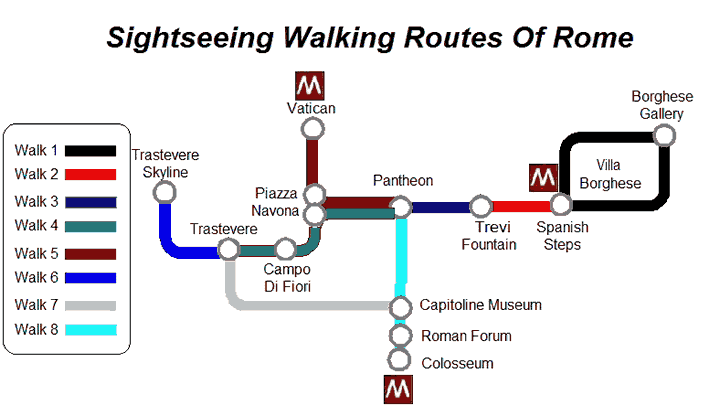
Walk 1 - A circuit of Villa Borghese
Walk 2 - Spanish Steps to Trevi Fountain
Walk 3 - Trevi Fountain to the Pantheon
Walk 4 - The Pantheon to Trastevere via Piazza Navona
Walk 5 - the pantheon to vatican city via piazza navona, walk 6 - a walk above and around trastevere, walk 7 - trastevere to capitoline hill & museum, walk 8 - the pantheon to colosseum via roman forum & capitoline hill.
Walk 9 - The Appian Way (outside Rome City Centre)
Walk 1 : Villa Borghese (Visiting the Spanish Steps & Borghese Gallery
Villa Borghese is the largest public park in Rome and a great safety valve to escape the noise and bustle of the city of Rome, just minutes from some major attractions in the centre of Rome.
The walk takes you on a comprehensive circuit of the best that Villa Borghese can offer. The walk is primarily for chilling out, but the Borghese Gallery is part of the walk and the park map lists 90 places worth noting, which means there is something to divert your interest all the way, including a full size replica of Shakespeare's Globe Theatre in the middle of Rome used for staging the bards plays!
Walk 1 - Villa Borghese - full details
A short efficient way of walking between the two main tourist hotspots in the eastern part of the ancient city centre, avoiding traffic.
Walk 2 - Spanish Steps to Trivia Fountain - full details
Walk 3 - Trevi Fountain to The Pantheon
Again a direct short walk avoiding traffic between the Trevi Fountain and the Pantheon in the heart of the ancient city centre. The Pantheon is a major hub of our sightseeing walks with four walks radiating out from it in all directions.
Walk 3 - Trevi Fountain to The Pantheon - full details
A great walk through ancient alleys and narrow lanes through a part of Rome much favoured in the evening for somewhere to eat. The walks pass through Piazza Navona and Campo de' Fiori market and no doubt you will make your own discoveries too.
Walk 4 - The Pantheon to Trastevere via Piazza Navona - full details
A quick efficient walking route avoiding traffic connecting Vatican City with the ancient city centre of Rome.
Walk 5 - The Pantheon to Vatican City via Piazza Navona - full details
Trastevere is renowned as a restaurant district to head for in Rome and this walk is a great walk in the evening from the skyline above Trastevere with views all over Rome down to your restaurant table below.
Walk 6 - A walk above and around Trastevere - full details
A short but sweet connector walk connecting Trastevere to the Roman ruins of the Roman Forum and Capitoline Hill.
Walk 7 - Trastevere to Capitoline Hill & Museum - full details
A short connector walk linking the ancient city centre of the Pantheon, Trevi Fountain and Piazza Navona with Capitoline Hill, Roman Forum and Colosseum..
Walk 8 - The Pantheon to Colosseum via Roman Forum & Capitoline Hill - full details
Walk 9 : The Appian Way
The Via Appia Antica is the old Roman Appian Way, which ran from Rome down to Brindisi. The stretch close to Rome, the Via Appia Antica, is now part of a nature and archaeological park, the Parco Regionale dell'Appia Antica, and makes a lovely half day out, particularly on Sundays when the area is closed to traffic. You too can walk along the Appian way, just like Romans did 2,000 years ago.
Walk 9 - The Appian way - full details

Follow our travels on Instagram!

One Day in Rome – Free Self-Guided Rome Walking Tour
If you only have one day in Rome, chances are you’re overwhelmed by the incredible options of what to see and do. The good news is, with this free walking tour of Rome you’ll see the top sights, with time to stop for a delicious gelato along the way.
First up though, have you considered which Rome attractions are on your bucket list?
If they include the Colosseum, the Roman Forum, the Trevi Fountain and Vatican City, you’ll see them and many more on this tour, with my recommendations for the easiest way to get around them all in a day.
So, all that’s left to do is pack your comfy walking shoes and get ready to explore the Eternal City in one magical day.
Table of Contents
Walking Map of Rome
The following Rome sightseeing map will lead you on an adventure across 1 day in Rome. It covers about 12 kilometres in total and winds through the city’s historic streets, via all those iconic attractions you don’t want to miss.
To make the most of the free Rome walking tour, it’s designed to allow enough time to properly discover each attraction but to keep moving towards the next in order to fit them in. However, if you can’t resist lingering over pizza, all you need to do is step up the pace.
How to Spend One day in Rome
Your self-guided walking tour of Rome starts and ends at Termini Train Station. It follows an exciting path to the Colosseum first and moves on to cover all the top things to see in Rome, before taking you back around to the Trevi Fountain and the station.
However, if the Vatican Museums are at the top of your must-see list, it’s best to start the day there and buy early access tickets to avoid the long queues. You can still fit other attractions in and you’ll find my recommendations for an alternative route towards the end of this article.
=> Starting Point – Termini Train Station
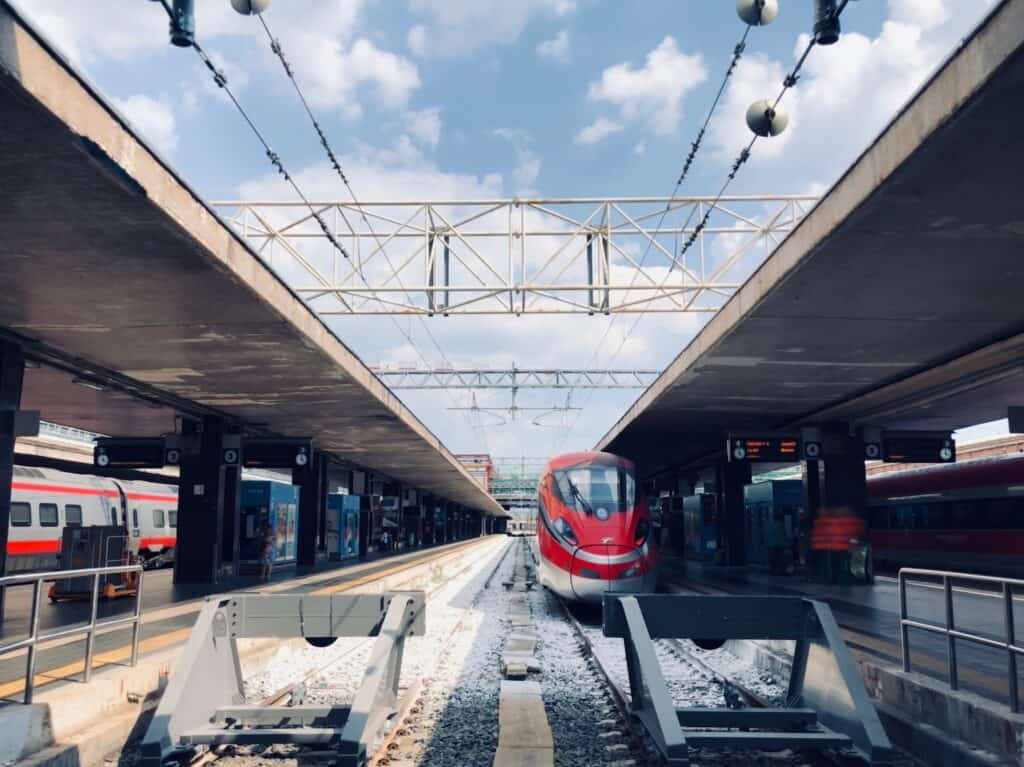
Most short stopovers in Rome begin and end at Fiumicino Airport. With direct trains available from the airport to the city, I’ve chosen Termini Train Station as the easiest starting point. It’s also the main hub for trains from other destinations in Italy and Europe.
Don’t worry about dragging heavy bags around either, as you’ll find Termini luggage storage facilities to safely stash your things for the day.
Stop #1 – The Colosseum
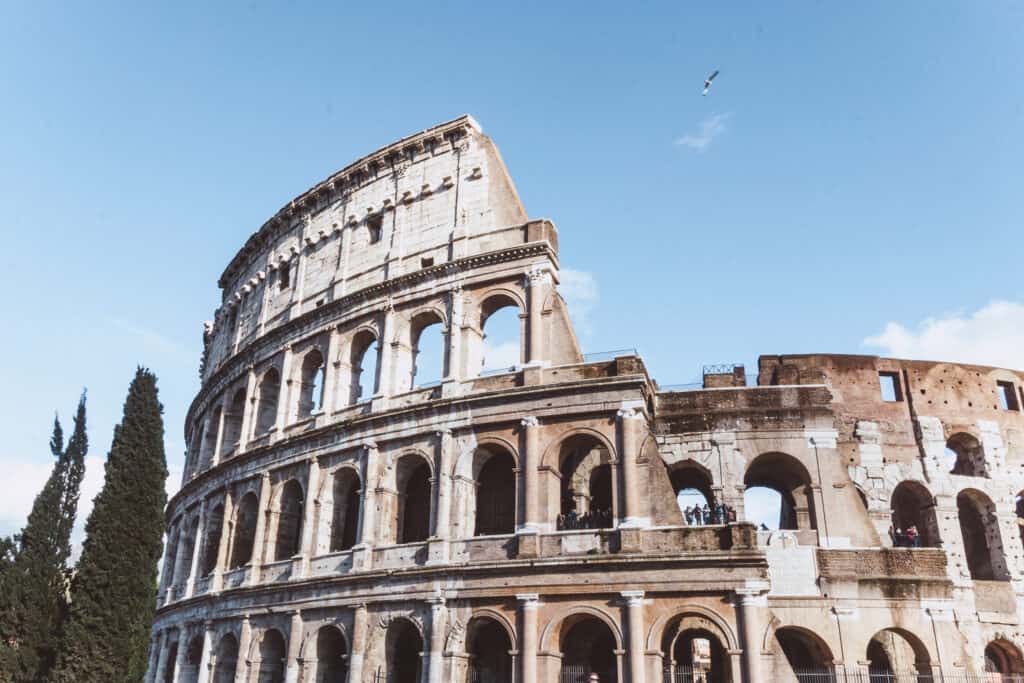
After stretching your legs on the easy walk from the station, you’ll start the tour off with a bang at one of the top places to visit in Rome. At first sight, a visit to the Colosseum offers one of those gasp-worthy moments, right before you frantically reach for your camera.
Built in AD 80, it could host more than 60,000 people all vying for the grisly privilege of watching gladiator battles, wild animal fights and public executions.
It’s enough to simply gaze in awe at the exterior of the ancient site, however, if you want to go inside it’s best to buy entry tickets online first. Then, you’ll see evidence of the intricate underground passageways and trap doors used for the brutal shows, along with the enormity of the famous landmark.
Stop #2 – The Roman Forum
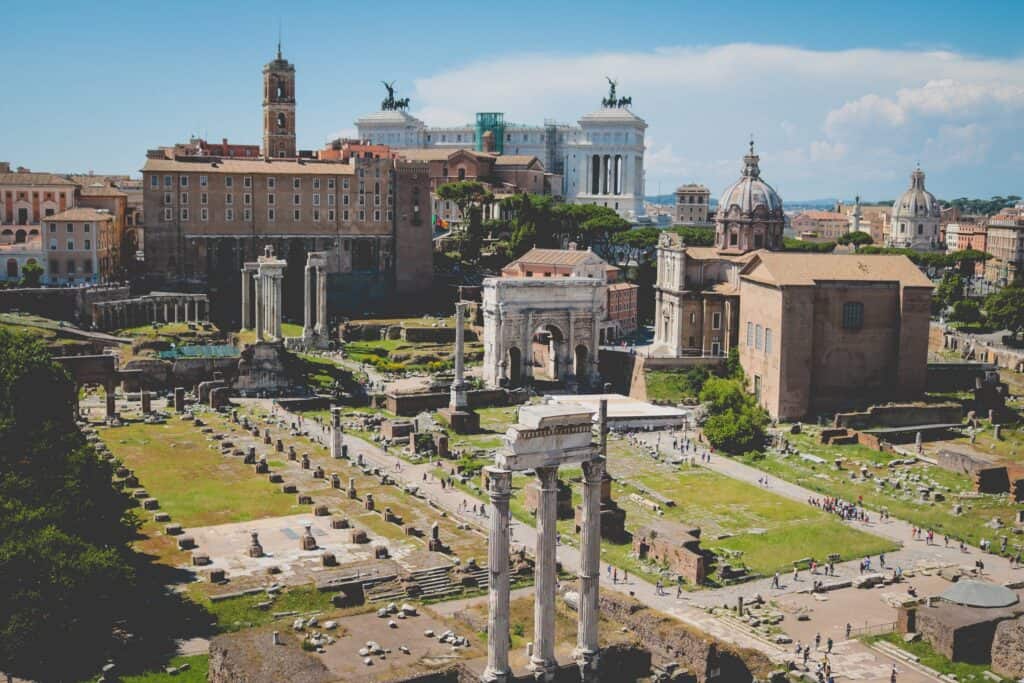
No ancient Rome tour is complete without discovering the Roman Forum, which is just a stroll from the Colosseum. Though its majestic temples and imposing buildings now lie in ruins, you can certainly see, and feel, the sheer grandeur of the Roman Empire’s political, commercial and social heart.
This was the home of the Vestal Virgins who kept the sacred fire in the Temple of Vesta alight, and the site where Julius Caesar was cremated at his namesake temple.
The Egyptian granite columns of the Temple of Saturn hide secrets of the state treasury and was repeatedly destroyed by fire across the years. It’s definitely worth it to download an audio guide to learn about the site’s incredible history, while you’re exploring.
Stop #3 – Piazza Venezia
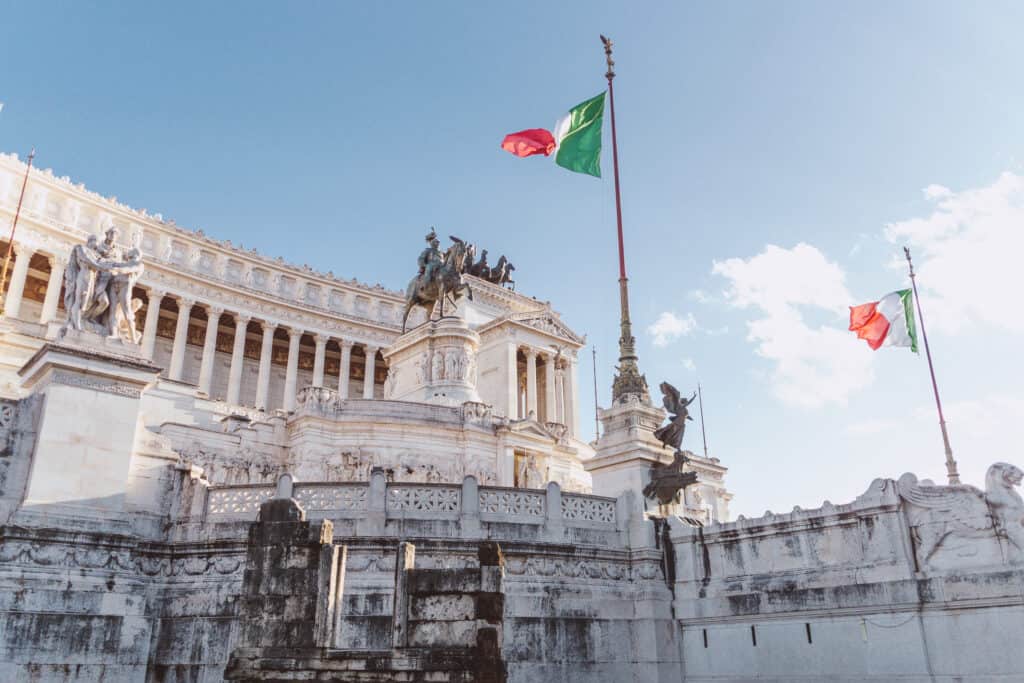
After popping back out from an ancient history trance, your walking tour continues onto the Piazza Venezia, which is literally located in the heart of Rome. It’s a breathtaking spot, with the white marble of the Vittorio Emanuele II Monument taking centre stage.
In fact, a whole area of Rome was demolished in order to make way for the structure and it was built to commemorate the unification of Italy.
If you feel like a coffee, there are plenty of cafes to get one here, before delving into the museum at the Palazzo Venezia. A huge collection including paintings, wooden sculptures, silverware, tapestries and weaponry stretches across more than 20 rooms and a garden adorns the centre of the palace. Back outside, don’t miss out on taking a snap of Palazzo Bonaparte, the former home of Napoleon’s mother.
Stop #4 – Largo di Torre Argentina
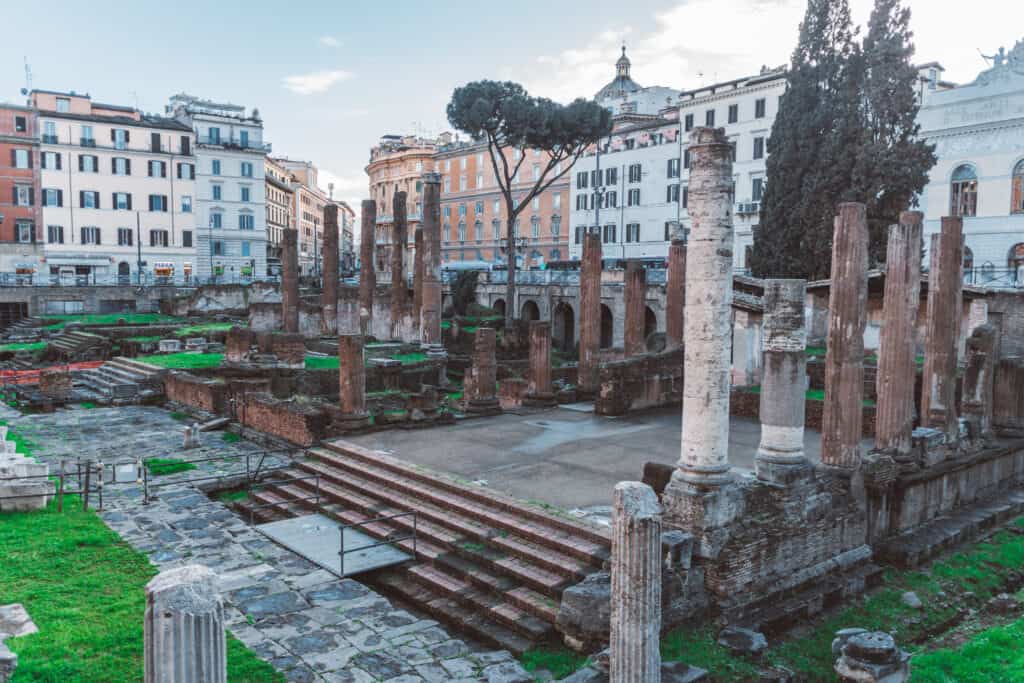
It’s said that Julius Caesar was murdered in the ruins surrounding the Largo di Torre Argentina. Fast forward to the future and it’s long been the home of a volunteer-run cat sanctuary. This is the next stop on your tour of Rome, to see the ruins of four Republican-era temples that are thought to have been constructed between the 2nd and 4th centuries BC.
You might be wondering what all this has to do with Argentina…
Nothing, as it happens. The name is taken from Argentoratum, which was the Latin name for the city of Strasbourg, the hometown of the Papal Master of Ceremonies.
Only cats are allowed inside the complex, though rumoured plans are constantly in motion to renovate the area and open it to the public. However, you can view the ruins from surrounding walkways.
Side trip – Campo de’ Fiori
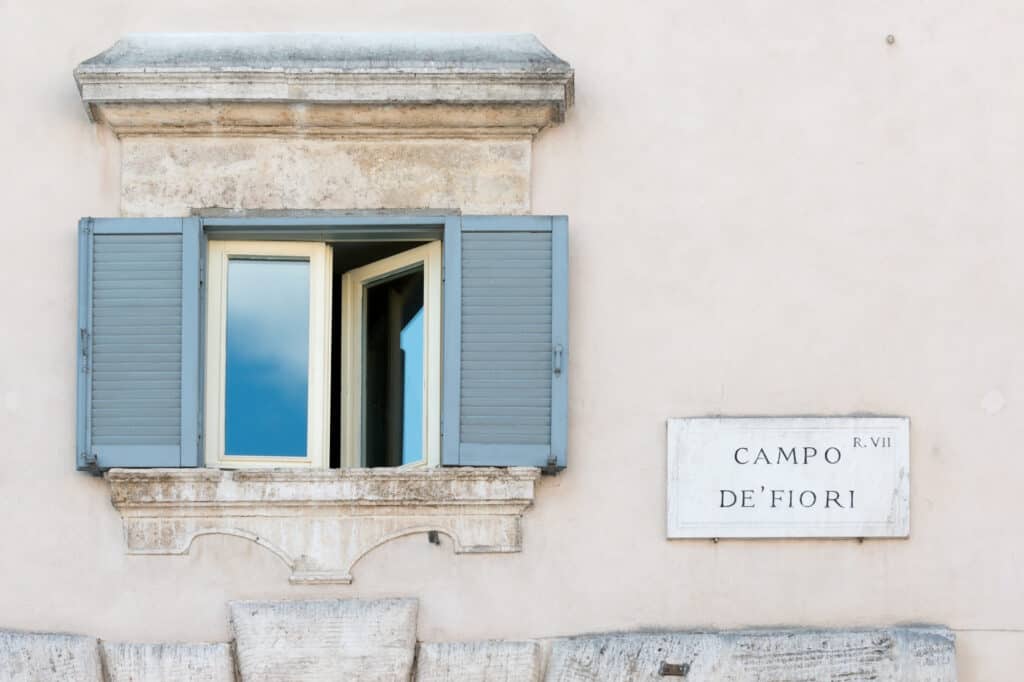
At this point in your Rome sightseeing tour, it’s time to check the time. Is it already after 1pm? If it is, skip this side trip and make your way to the Pantheon. Otherwise, get set for the delicious delights of the morning market at Campo de’ Fiori. It’s the city’s most famous market and brims with fruit and vegetable stalls, flower merchants and locally made delicacies.
The vibrant, local action takes place on the site of the ancient Theatre of Pompey and some remnants are seen throughout. However, it’s hard to notice anything but the tasty treats. Refresh with a glass of freshly-squeezed juice, pick up something to snack on and don’t miss out on trying some sun-ripened fruit.
Stop #5 – The Pantheon
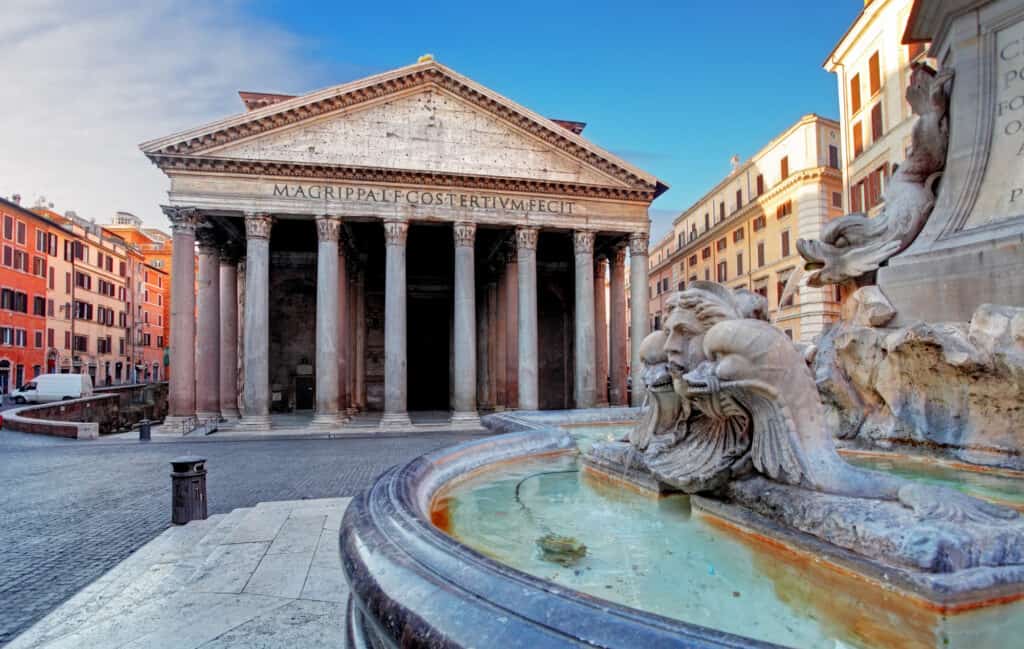
All of the best walks in Rome lead to the Pantheon and it pays to prepare yourself for yet another gasp-worthy moment. The 2000-year-old temple is the best preserved of Rome’s ancient structures and features the largest unreinforced concrete dome that was ever built.
Its existence is thanks to Marcus Agrippa, the son-in-law of Emperor Augustus. Dedicated to the planetary gods, early Christian emperors stopped all pagan worship in the temple and today it continues to function as a church.
Michelangelo is said to have stated that the Pantheon was built by angles, not by men, and that’s not so hard to believe.
Stop #6 – Church of St. Louis of the French
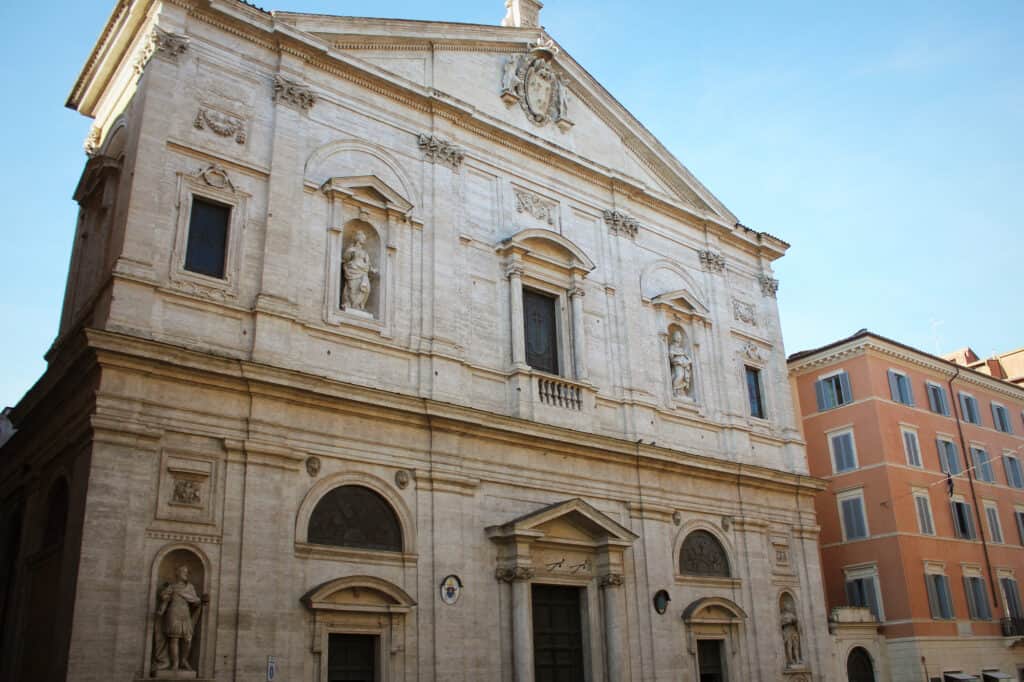
As you continue walking through Rome, the next stop is the opulent Church of St. Louis of the French. The Roman Catholic church is dedicated to the Virgin Mary, St. Louis IX and St. Denis the Areopagite and it’s still an active place of worship for Rome’s French community, as it has been since 1589.
Being Rome, the Baroque structure is built on ancient sites, namely the Baths of Nero and the Baths of Agrippa. Wander inside to see the three famous Caravaggio paintings, The Calling of Saint Matthew, the Martyrdom of Saint Matthew and Saint Matthew and the Angel, near the main altar.
Stop #7 – Piazza Navona
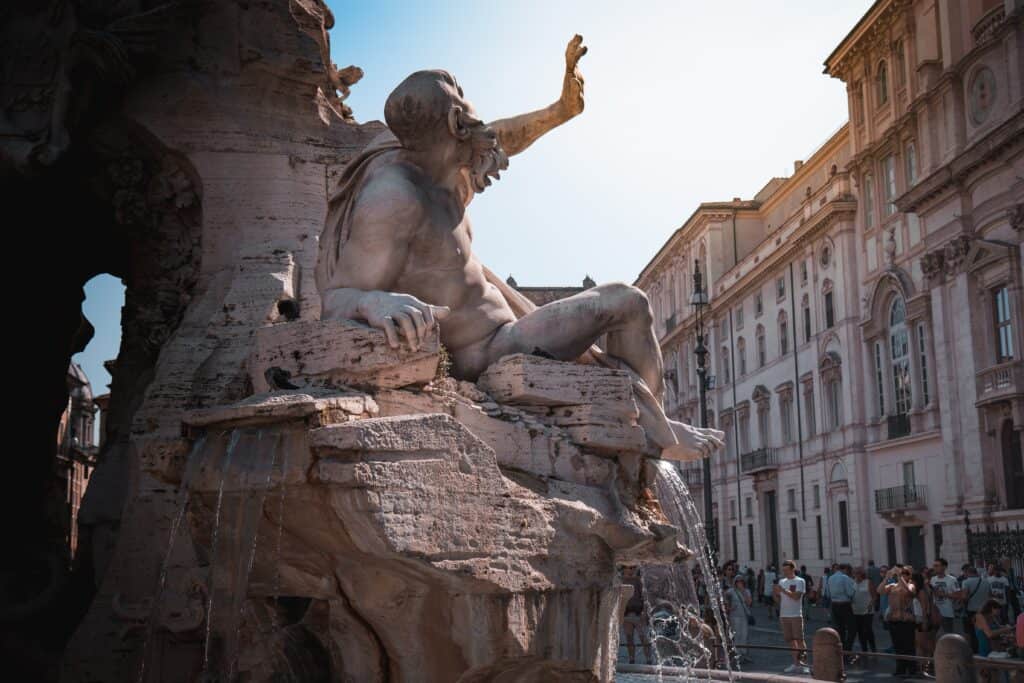
Among the spectacular things to see in Rome in one day, the Piazza Navona is one of the most extravagant. Three elaborate fountains take the spotlight and the one in the centre, Fontana Dei Quattro Fiumi, was designed by Bernini in 1651. Surrounding this is an ever-revolving parade of people including artists, magicians, dancers, hawkers and camera-happy tourists trying to take it all in.
Borromini, one of the most important architects of the century, designed the splendid, 17th-century Baroque Sant’Agnese in Agone Church. Speaking of architecture, simply turn around in circles here to treat your eyes to the array of Baroque palaces. The largest is Palazzo Pamphilj, which now houses the Brazilian embassy.
If you’re not running out of time, restaurants and cafes surrounding the square let you sink in for a bit and soak up the atmosphere.
Stop #8 – Vatican City
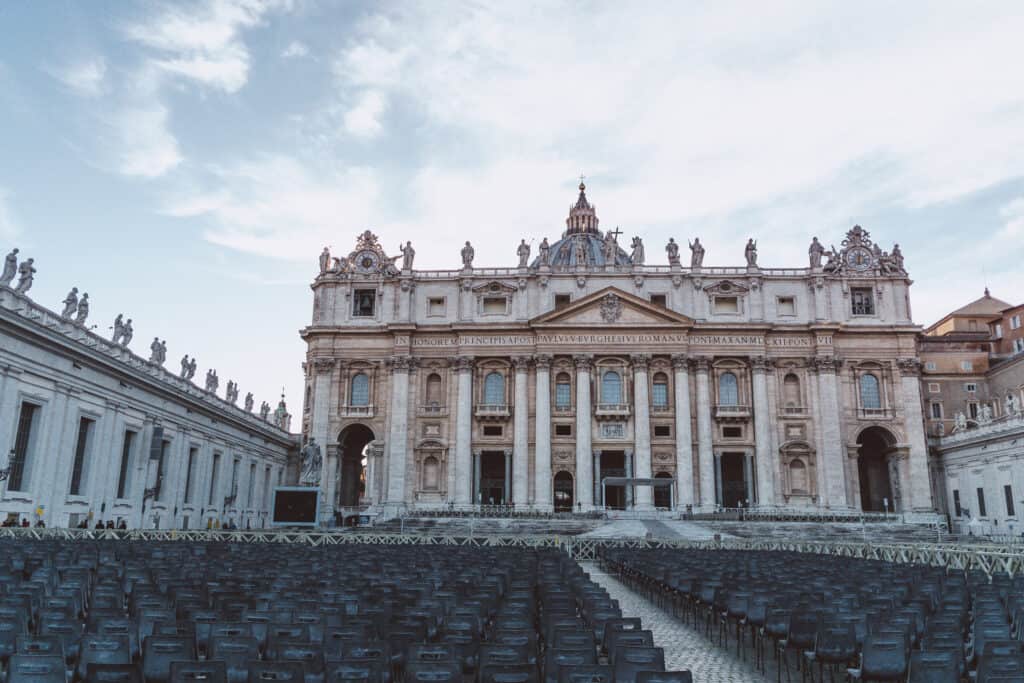
Of all the things to do in Rome , the UNESCO World Heritage Site of Vatican City tops many travel bucket lists. This Roma walking tour doesn’t really allow time to immerse yourself in the Vatican Museums , so choose the alternative tour below, if that’s your main priority. It does, however, give you time to check out one of the most famous squares, and most-visited churches, in the world.
The sheer size of St. Peter’s Square is a sight to behold. With 284 columns topped by sculptures of saints, the design of the square is a symmetrical masterpiece, so move through the crowds to view it from a variety of different angles. Dominating the city’s skyline, along with the square, is one of the largest churches in the world.
The highlight of St. Peter’s Basilica is Michelangelo’s awe-inspiring dome. However, an exploration of the grandiose interior, which houses invaluable works of art, is a mind-blowing experience no matter where your eyes come to rest.
Stop #9 – Castel Sant’Angelo
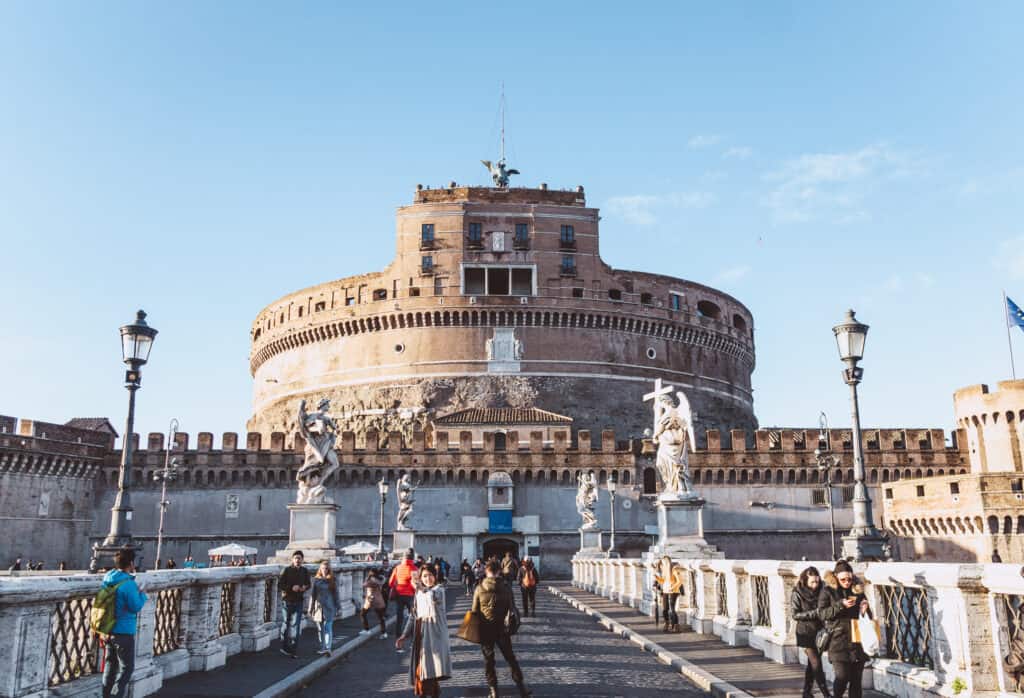
Your day tour in Rome continues onto the banks of the Tiber River and Castel Sant’Angelo. Also known as Hadrian’s Tomb, this is another great spot to stop for a drink at the cafe housed on the top floor, for panoramic views of the city.
The walls of this soaring, cylindrical building also hold fascinating secrets of its history as a fortress, a prison, a hideaway, a mausoleum and place of myth and legend.
Across numerous floors, it’s now a museum with a large collection of paintings, military memorabilia and medieval weapons. The opulent interior features frescoes showcasing Alexander the Great, historic Papal rooms, prison cells and the Hall of the Urns, once used as a resting place for the remains of the imperial family.
Stop #10 – Spanish Steps
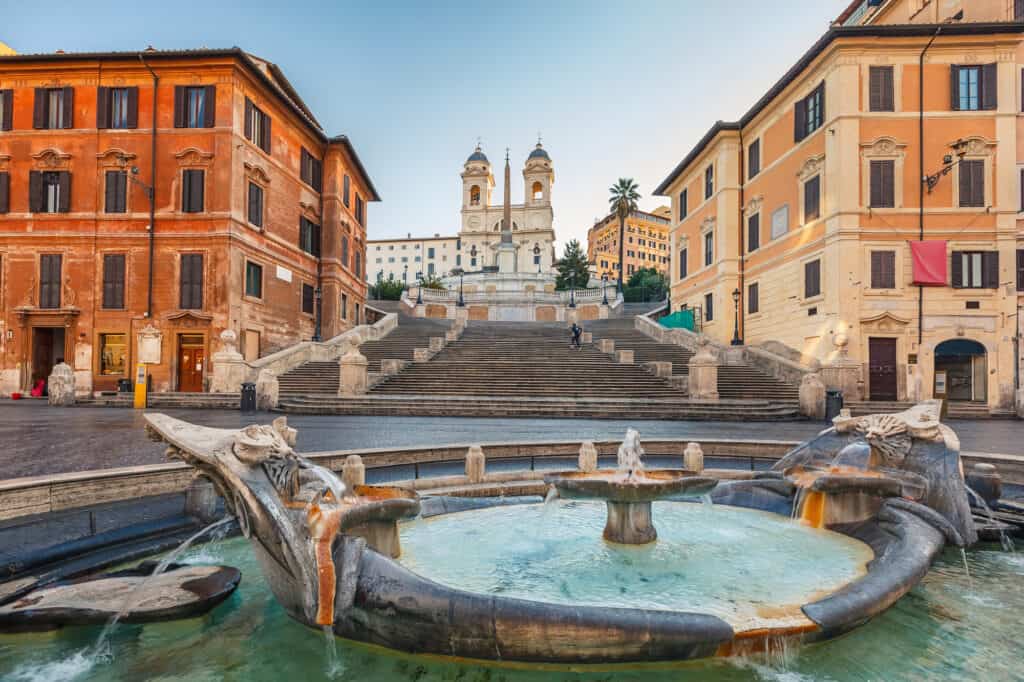
No visit to Rome is complete without a stroll up the picturesque Spanish Steps. Built in the 1720s, the famous staircase joins the Piazza di Spagna with Trinita dei Monti Church.
When you climb the 138 stairs, terraces along the way offer gorgeous views. However, it’s worth it to go all the way to the top to gaze out over the labyrinth of streets and see the butterfly-shaped stairs from a different viewpoint.
If you still have enough time on your Rome self-guided walking tour, there’s plenty to see nearby. Keats-Shelley House rests at the bottom of the steps, with a museum highlighting the English Romantic poets. Surrounding this area you’ll also find many of the world’s luxury high-fashion brands like Fendi and Valentino.
Stop #11 – Trevi Fountain
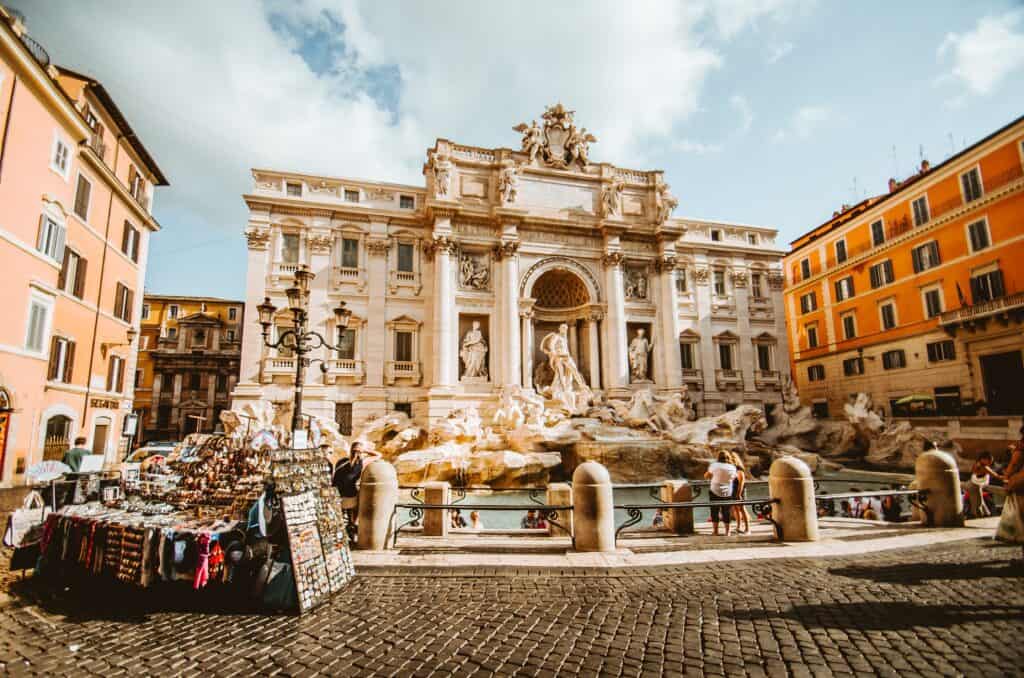
By now, chances are you’ve decided that walking around Rome is one of your favourite things to do. The last stop on this Rome, full-day tour gives you the chance to return, or so legend has it.
The beautiful Trevi Fountain is an icon of the city and tossing a coin into the water is said to ensure you’ll be back – as long as you do so facing away from the fountain, with your right hand, over your left shoulder.
The marble creation is an enchanting mix of seahorses, mermen and the god Oceanus, with cascading water that you can hear long before you see it. If you happen to arrive at the Trevi Fountain at night, lights add a stunning, dramatic element.
On the way back to the nearby Termini, stop by the Quirinal Palace, home to the residences of the president, and Palazzo dell Esposizioni to see revolving art exhibits.
Finish – Back to Termini
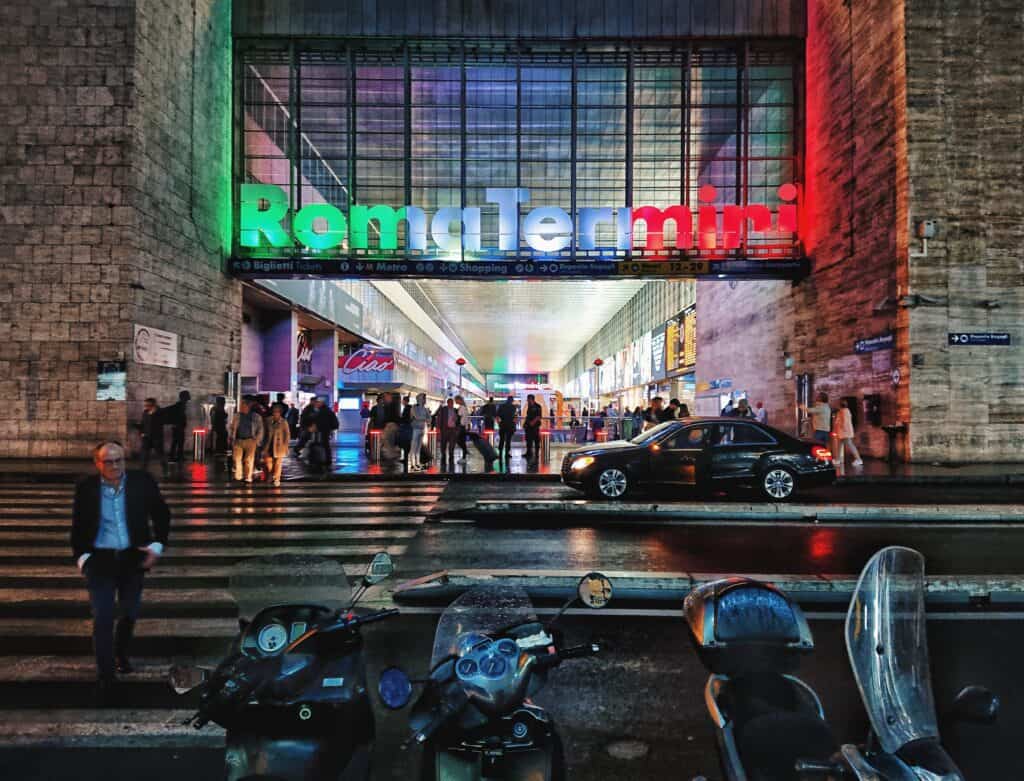
Time for a breather and to collect your things from the station, after visiting the top sights to see in Rome. If you’re feeling hungry or have some time to kill before your flight or train journey, you’ll find a funky food court with a great array of cuisines to keep you full and busy until it’s time to leave.
ALTERNATE ROME ITINERARY (STARTING FROM THE VATICAN)
If your priority on a Rome city tour is to explore the Vatican Museums, this alternate tour gives you time to do so, while still fitting in some of the best things to see in Rome, in one day. The key to giving yourself as much time as possible is to purchase early access tickets in advance and head to the Vatican Museums first.
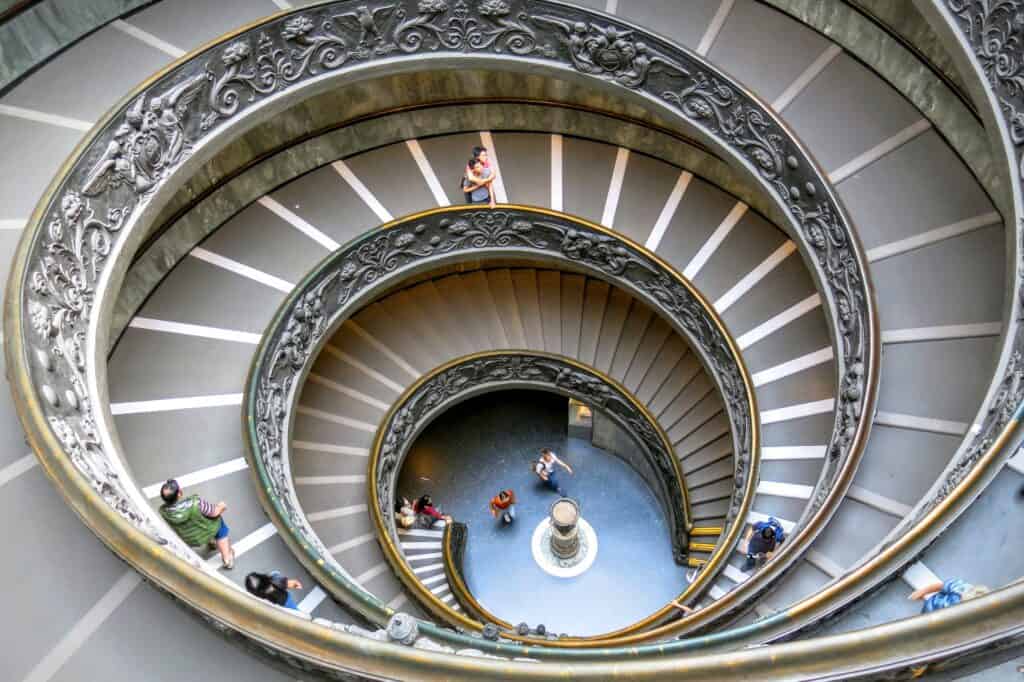
Vatican Museums
With one of the world’s most astounding art collections, it’s little wonder that the Vatican Museums are a ‘must-do’ in Rome. Founded in the 16th century by Pope Julius II, it’s certainly a mighty place to explore, with about 7 kilometres of corridors and rooms to discover.
The moment everyone waits for is that first glimpse of the Sistine Chapel, with Michelangelo’s magnificent ceiling frescoes. But, it’s really just the tip of the historic iceberg here, with the Raphael Rooms, the Room of the Segnatura, Borgia Apartment and the Gallery of Maps competing with a seemingly endless array of masterpieces.
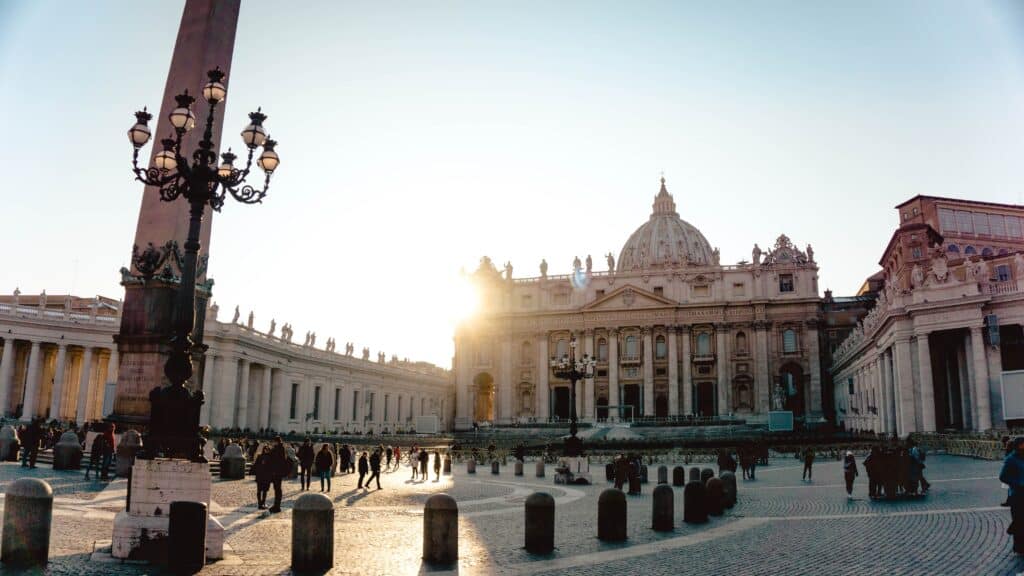
Alternate Tour from Vatican City
Following the Vatican Museums, continue exploring Rome on foot by walking to the Castel Sant’Angelo. From there, visit the Spanish Steps, the Trevi Fountain, Piazza Venezia, the Roman Forum and the Colosseum, in that order, before returning to Termini.
WHERE TO EAT IN ROME
As I’ve mentioned, places to stop for a bite to eat abound on this Rome travel itinerary. However, it pays to be wary of tourist traps, which include many restaurants immediately in the vicinity of attractions. Although sometimes it’s worth exorbitant prices and substandard food if it means settling in to take in the views.
Otherwise, you’ll find plenty of options just a street or so away from most of the top sights.
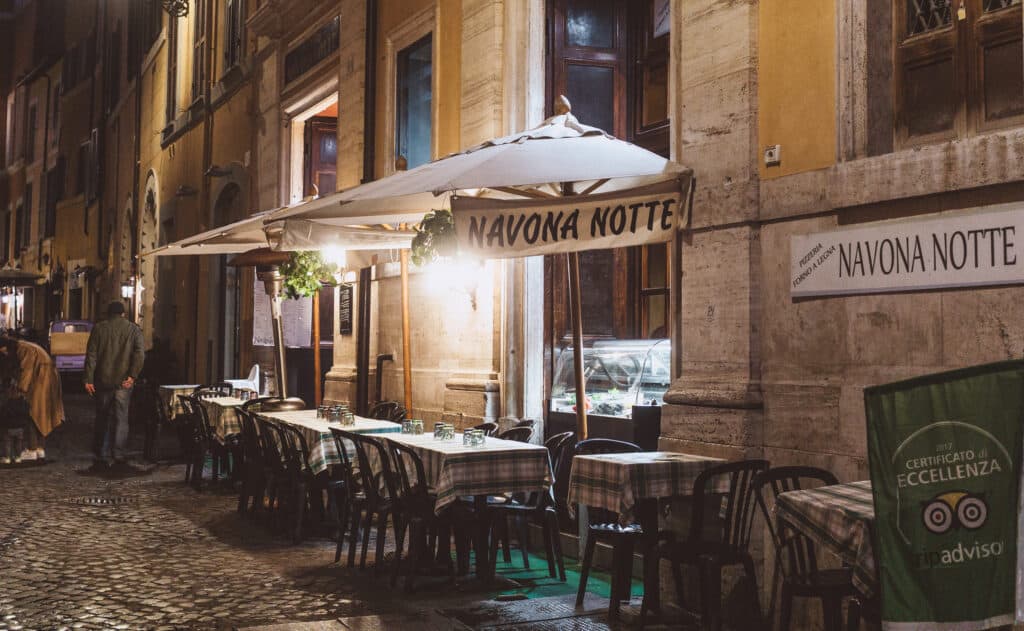
Around the Colosseum, avoid the restaurants just outside and walk to Li Rioni for some of the best pizzas in town. Centro Storico is a neighbourhood known for fantastic restaurants in the streets surrounding the Pantheon. Just a few steps from Vatican City, Borgo Pio is a relaxing neighbourhood with a range of family-run trattitoris and bars, including the highly-rated Arlu .
TIPS FOR VISITING ROME IN A DAY
So, what do you need to know for your day-long Rome getaway? As with travelling in any big city, it pays to be prepared before you launch into the adventure. Though it’s an easy city to walk around and explore, these steps help you to avoid small, or large, inconveniences, to visit Rome in one day without a hitch.
Clothing/Footwear
Deciding what to wear in Rome all comes down to the season, so make sure you check the weather forecast before flying in. Summer can be sweltering hot and winter is fairly mild, though you’ll still need a warm coat, boots and a scarf.
Speaking of which, carry a scarf or wear something to cover your shoulders and knees when visiting religious sites, including the Vatican Museums (for men and women).
To ensure you enjoy the best walking tour in Rome, comfortable shoes are a must! Though it’s a fashion capital and you might be tempted to wear those heels, cobblestones and uneven surfaces dictate flat footwear for a long day of walking.
While Rome has gorgeous weather, rain is, of course, a possibility. However, don’t worry about packing anything as you’ll find that street vendors magically appear with umbrellas at the hint of grey skies.
Along with your Rome walking tour map, make sure you travel with some cash, just in case something on the street catches your eye or you dine at a smaller venue that doesn’t accept cards. However, credit cards are accepted at nearly all major retailers and businesses.
ATMs are called Bancomat and you’ll find plenty of them near attractions on this walking tour. If you need to exchange your currency for the Euro, head to a bank or Foreign Exchange Bureaus.
When you visit Rome the biggest safety issue you’re likely to encounter is pickpocketing, otherwise, it’s a relatively safe city. Pickpockets operate around the most crowded areas, like the Colosseum and Piazza Venezia. This is very easily avoided though, by not carrying anything in your actual pockets.
Wear a cross-body bag you can keep a close eye on at all times. If you’re taking a backpack, make sure you keep it closed and pop a little lock on the zip, so you don’t have to worry about it.
Never leave belongings where you can’t see them, such as draped over the back of a restaurant chair or anywhere out of easy reach.
=> Read about the safest travel purses for Europe here.
Buy tickets in advance
To make the most of a day or 24 hours in Rome, you’ll save an incredible amount of time booking ‘skip the line’ tickets. You can buy them online and, when you see the queues to buy entry tickets at attractions, you’ll do a little happy dance that you only have to line up to get in the door.
Getting to Rome Termini station from Rome airports
The easiest way to get from Fiumicino Airport to Termini Station is via the Leonardo Express train that runs at least every half-hour from 6:38 am to 11:38 pm and takes about 30-minutes to get there. If you’re flying into Ciampino Airport, the Trenitalia Train service takes approximately 15 minutes and operates from about 5:30 am to midnight. Tickets are available at the airports and the station, however, it’s easiest to book them online before you go.
Now that you know what to do in Rome and how to get to all the top sights on foot, it’s time to get truly excited! The Eternal City is a feast for the senses that captures your heart and won’t let go. So, whatever you do, don’t forget to throw that coin into the Trevi Fountain.
Pin this for later!
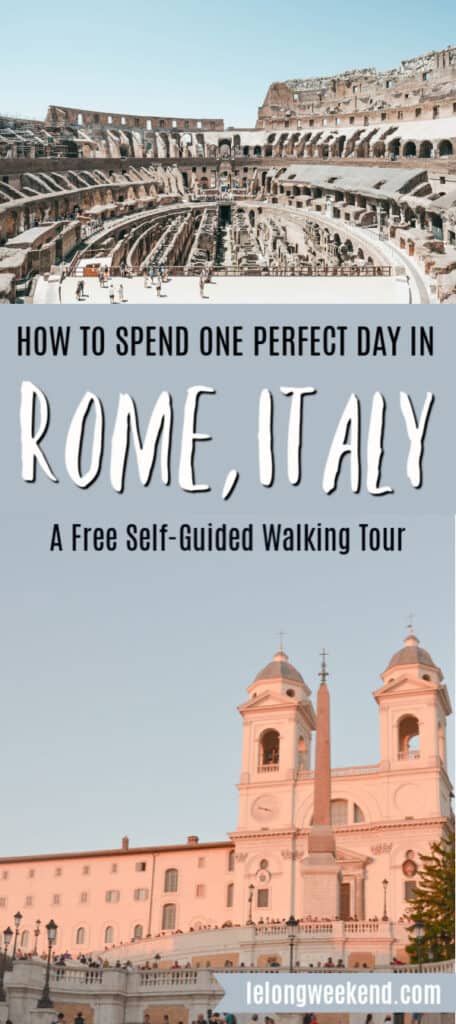
Similar Posts
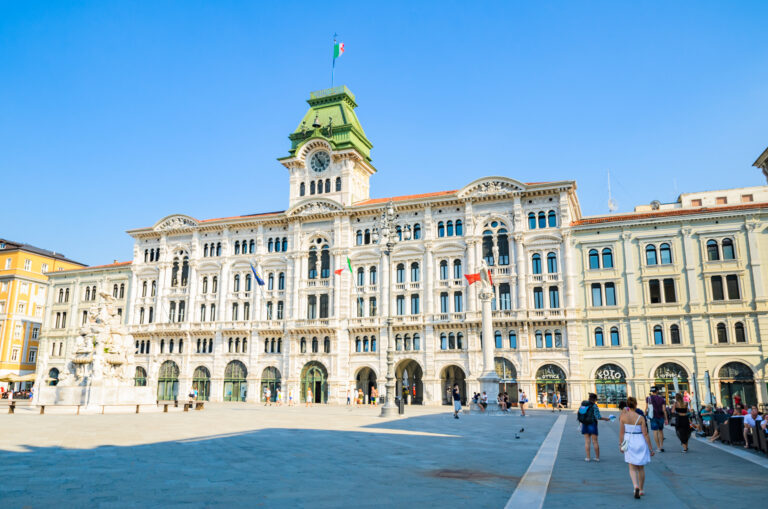
Best Things to do in Trieste, Italy
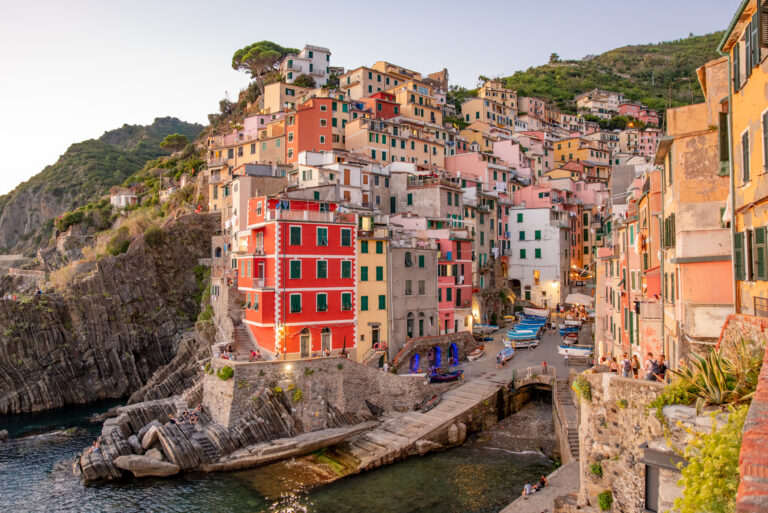
Ultimate Guide to Visiting The Towns of Cinque Terre, Italy
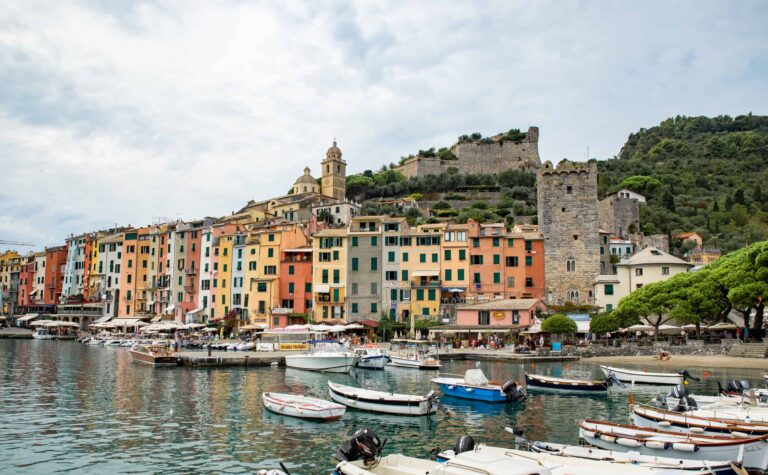
A Guide to Portovenere Italy – Liguria’s Lesser-Known Jewel
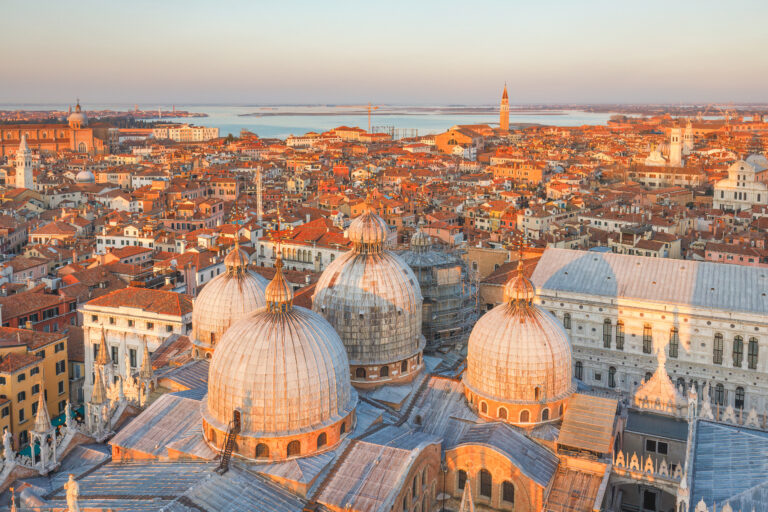
Best Views in Venice, Italy
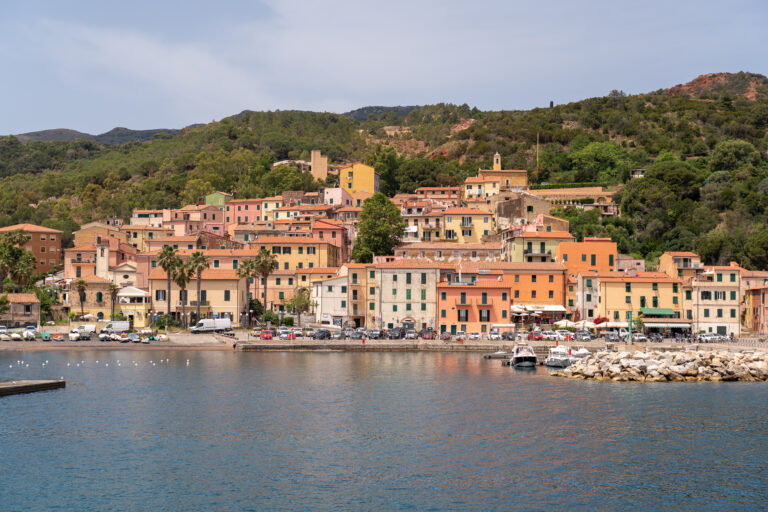
Guide to Visiting Elba Island, Italy
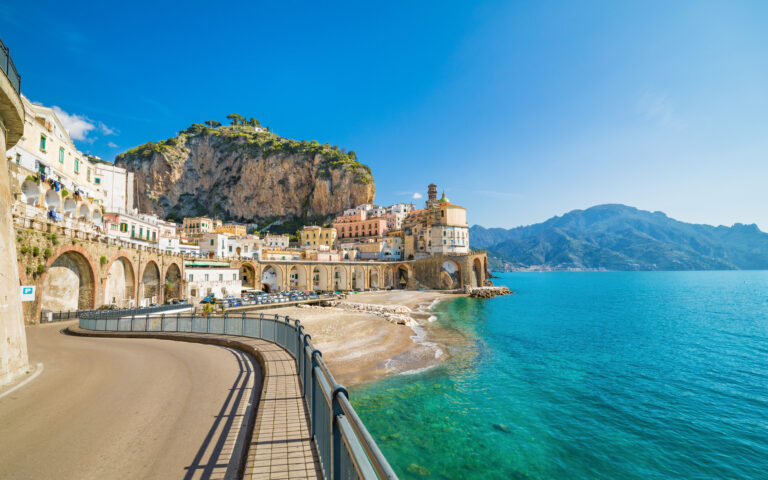
Most Beautiful Coastal Towns in Italy
One comment.
Nice Pictures And Places You Shared. I Love The Details You Combined In Your Article.
Leave a Reply Cancel reply
Your email address will not be published. Required fields are marked *
This site uses Akismet to reduce spam. Learn how your comment data is processed .
- Hidden Gems
- Popular Classics
- Travel Tools
- Photography
- Vintage Pieces
- Digital Prints
One Day in Rome Itinerary and Self Guided Walking Tour
- May 22, 2024
Incredible architecture, remnants of an ancient world, unbelievable churches, and notorious landmarks. These are just some of the things you’ll stumble upon (sometimes without even trying) in Italy’s capital city of Rome. We’ve all heard the saying “Rome wasn’t built in a day,” so how could you possibly see it in one day?
If you’re the type of person who appreciates a maximized itinerary on a tight schedule , you’ll be pleased to know how attainable a day in Rome can actually be. Furthermore, this is a self guided tour , inclusive of a suggested walking route of Rome in order to see the top sights within one day.
In this guide, discover a recommended day trip itinerary along with many important things to know before you go.
Is One Day in Rome Enough?
Avoid rome from july – august, get up early, hop on hop off bus, electric scooters, morning in rome, afternoon in rome, evening in rome, map of self guided walking tour for one day in rome, how much does a day in rome cost, what should you not do during one day in rome, how many steps will you take during one day in rome, where to park for a day in rome, where can you store luggage in rome, what is the best way to get from and to rome airport, where to stay in rome for one night, travel resources for one day in rome.
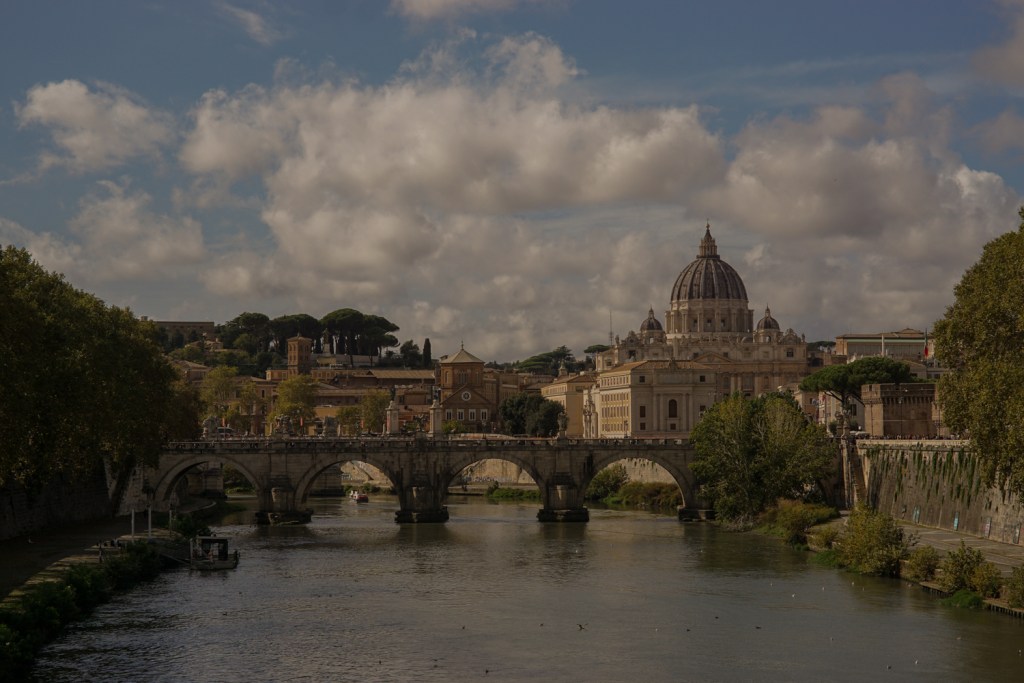
❗️This post was 100% written by a human author based on real-life experiences without the use of AI-generated content or images.
The Essentials for One Day in Rome
📸 You can see many of Rome’s most famous landmarks in just one day in Rome, as long as you do not enter any of the attractions and only experience sites from the outside.
🚶🏻♂️ The best way to get around Rome is on foot with some help from the metro. Keep reading to see the recommended walking route of Rome which passes by all of the city’s highlights.
🚉 Take the Leonardo Express to get to Rome from Fiumicino Airport . It’s cheap, quick, and tickets can be booked online in advance.
🥵 If you can help it, simply do not visit Rome from June – August . While the crowds in Rome truly never disappear, you can do your best to avoid stampedes by visiting in shoulder or off season.
🎒 You do not need to walk around the city with your luggage. Find a place to store your luggage for cheap while you explore Rome!
The historic centre of Rome isn’t particularly big, but the remainder of the city is massive. In fact, it’s the largest municipality in Italy. Fortunately, most tourists will want to focus on seeing the top sites in Rome, which are conveniently and centrally located within the same nook.
The close proximity of its most renowned landmarks to one another is one of the biggest factors that make one day in Rome actually palatable. Compared to a city like NYC, where much of your time is spent traveling from one side of town to the other, you can surprisingly see a lot in Rome in a short amount of time .
As people who have now visited Rome multiple times, we can confidently say that each time we return, there’s been something new discovered. To genuinely experience Rome and maybe even see Rome like a local is not possible in one day. With that being said, it is still feasible to see a handful of the most notable sights with just one day in Roma . Although one day in Rome isn’t quite enough, it shouldn’t deter you from visiting with the time you do have.
Who Can See Rome in One Day?
A fair warning though, this Rome itinerary is jam-packed and may not be for everyone . Who will love this itinerary? 1. Travelers who are set on checking out all the must-sees in Rome and have a little pep in their step. 2. Travelers who will be satisfied to merely visit landmarks from the outside and not actually enter .
This one-day itinerary in Rome is not best suited for people who want to actually go inside the Vatican , Colosseum, Castel Sant’Angelo and Pantheon. These activities take up a good chunk of time and aren’t practical for just a Rome day trip. If you have more time in Rome, we highly recommend booking a tour or two to gain the most from your time there.
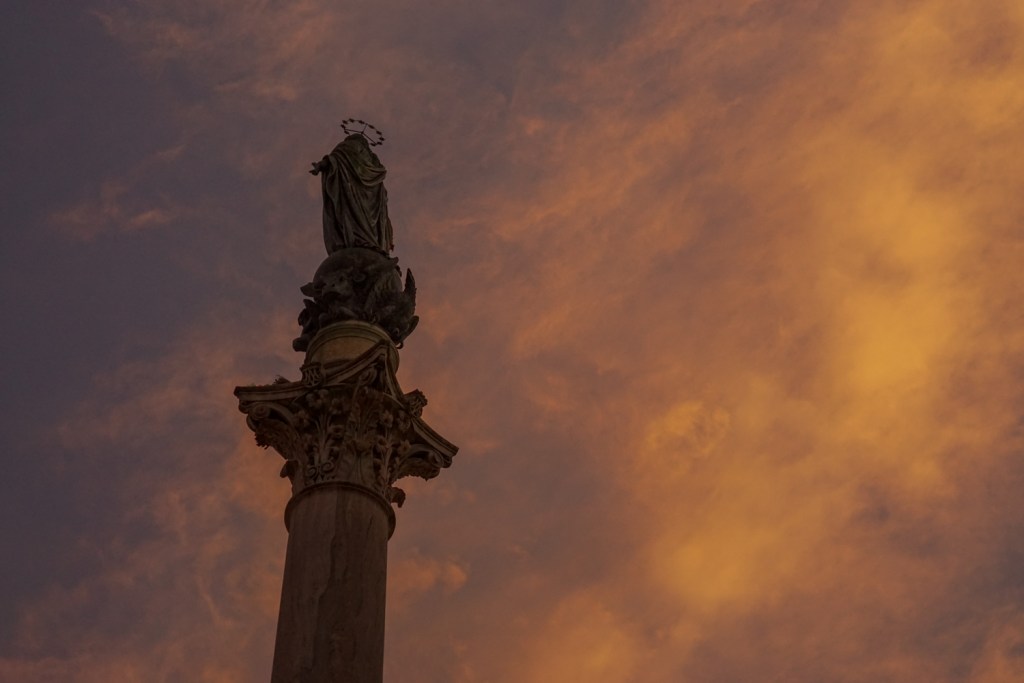
The Best Time to Visit Rome for a Day
To provide our readers with honesty and thorough travel advice , we won’t sugarcoat this next part. Rome can be unbearable if you visit during the wrong time. The city welcomes over 10 million visitors each year, and there’s no sign of this slowing down. As a visitor, it’s important to be aware of what you are walking into and have certain expectations in order to avoid disappointment. There will be crowds, there will be lines, and it likely won’t feel like you’re in a dream.
With that being said, a place can be all these things and still be 100% worth seeing. To ensure you’re visiting Rome during the most enjoyable time, there are two things to be aware of.
If it’s in your control, do not plan a visit to Roma in the summer. This isn’t even necessarily because of the crowds but because of the extreme heat . Each time we’ve visited Rome in the summer months, our day ended in a puddle of our own sweat (and maybe tears). For this self-guided walking tour of Rome in particular, it’s not recommended to attempt it in 35°C / 95°F weather.
Travellers who are eager to attend at least one attraction should also know that tickets are sold out for 2-3 weeks ahead of time in the summer.
One of the best things to do in Rome is to see it at sunrise . If you are not planning on entering any of the landmarks, try to schedule your one day in Rome to begin just before the sun comes up. This will result in a couple of things such as getting the best photos at Rome’s hotspots and having to steer around fewer people while walking. The lighting is extraordinary, and there’s a sense of magic as you witness Rome waking up for the day.
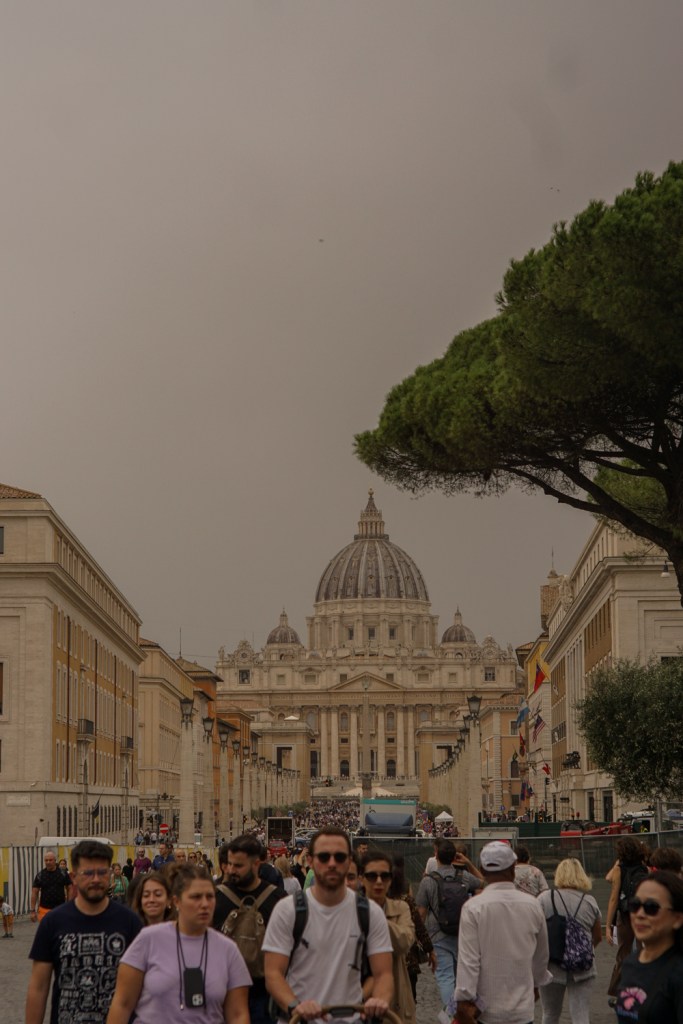
How to See Rome in One Day
We are some of the biggest advocates for self-guided trips, mostly because it came out of necessity. When you’re traveling with a large dog and a toddler, it’s sometimes best to do everything on your own time. *shrug* However, if you are visiting Rome for a day without an entire circus, booking a Hop-On Hop-Off bus will save your feet the walking .
The Hop-On Hop-Off bus works particularly well for a Rome day trip because it will stop at all the major attractions. After purchasing your ticket, you’ll hop on the bus at the main departure location, which is usually at Termini station. From there, you’ll receive a map of the stops throughout the city where you can get off and get on as you please during the day. Overall, this is hands down the best way to see Roma in a short amount of time if you’re just looking to get the gist of it .
Pack some really comfortable shoes and come prepared to see Rome on the most personal level, by walking . For travelers who are physically able to, it’s highly recommended to complete this one-day tour of Rome on foot. It is the only way to truly appreciate Rome beyond the tourist hotspots.
As you’re walking from one site to another, you’ll come across narrow alleyways, secret courtyards, and hole-in-the-wall bars or restaurants that you otherwise wouldn’t have known about. To experienced travelers like us, it’s unexpected finds like that which end up being the best part of a trip.
A walking tour of Rome also does not mean it has to be a sprint. Although it’s a lot of steps and distance to cover, it can be leisurely. Get an early start, do not rush it and always stop for a caffè or gelato when the opportunity presents itself. Luckily, there are also many park benches and marble structures around Roma where you can sit down and take a breather .

If you’ve been to any major city lately, you may have noticed the use of electric scooters as a method of transportation. Personally, we think they’re really fun to use and can be a huge time-saver if you know what you’re doing . As a solo traveler or even a couple, using the electric scooters will get you through a Rome itinerary efficiently.
Most recently, we noticed around three different electric scooter companies (there are likely more) in the city center of Rome: Bird, Lime, and Helbiz. Each of these works similarly in terms of how to use them. If you already have the app for any of these, then simply scan and get moving. If not, you’ll need to download the app and complete a brief signup before scooting away. Prices are on average around €1 for the initial startup and then €.25/minute thereafter .
The one thing to keep top of mind before renting an electric scooter in Roma is your confidence level and experience. For first timers, it can be nerve racking to manuever through cars, taxis and even mobs of people.
Public Transportation
The public transportation system in Rome is comprised of the underground metro, above-ground trams, and buses. Similar to many popular tourist destinations in Europe, it’s possible to purchase a 24-hour pass which costs €7 in Rome. This pass is valid on all types of public transportation.
Out three metro lines, tourists will be most interested in knowing about Line A and B. Line A easily connects the west side of River Tiber (Vatican City) with the east side , where a majority of the attractions are. Line B is then helpful for getting to the Colosseum. For reaching the heart of the historic quarter (Trevi Fountain, Pantheon, and more), do not rely on taking the metro as there is zero metro coverage in that area.
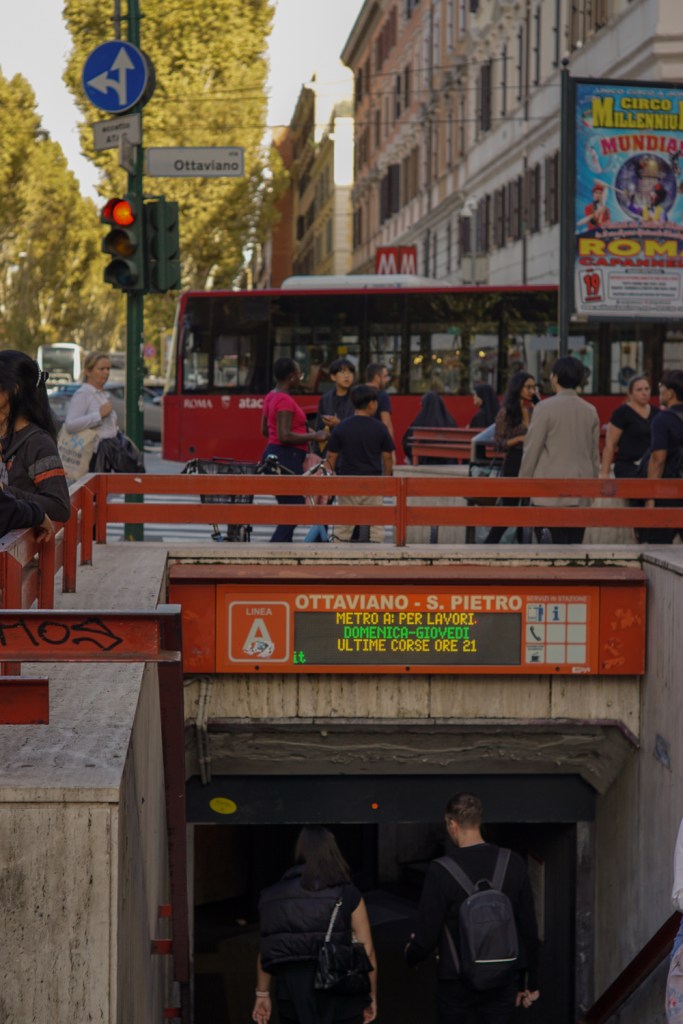
Using the above-ground tram is mostly useful for getting to the Trastevere neighborhood (line 3) on the west side of the River Tiber. Navigating your way throughout Rome’s major sites using the tram is not recommended to be your primary form of transportation. The majority of the trams have “tap to pay” systems, which allow you to tap your credit card (or Apple Pay) and pay for a single-use ride on the spot.
Rome’s bus system is the most vast and covers the entirety of its suburbs including the historic centre. If you bought the 24-hour transportation pass, you can use this on the bus. Or, you can simply tap your credit card or phone at the front of the bus as you get on and the €2 ticket is valid for 100 minutes . You cannot purchase a bus ride in cash with the driver. Surprisingly, Google Maps is accurate when it comes to bus directions in Rome based on the destination landmark you enter. To find the bus stop, simply keep a lookout for the yellow signs which say fermata on them.
🗺 HOW TO MASTER PUBLIC TRANSPORTATION IN ROME : Download the maps for the metro lines, tram stops and bus routes available here before arriving.

An Eventful One Day in Rome Itinerary
Vatican city.
As the smallest sovereign state, Vatican City is home to the largest church in the world and exists as a country within the city of Rome. It is renowned for many of its components including St. Peter’s Basilica , the Gardens of Vatican City, and the Vatican Museums. The Sistine Chapel is one of the most well-known reasons to visit Vatican City as it’s where you’ll find the celebrated Michelangelo’s ceiling.
Visiting the Vatican Museums takes a minimum of two hours . To include touring the actual interior of Vatican City during your one day in Rome, it’s recommended that you take the morning tour at 9am.
Alternatively, you can skip entering the Vatican and appreciate its exterior. To keep this Rome itinerary completely free of costs and to maximize on time, travelers can simply admire St. Peter’s Basilica from St. Peter’s Square .
🎭 Read More: Tips for Visiting the Vatican Museums

Castel Sant’Angelo
Steps away from Vatican City is the fortress of Castle Sant’Angelo, originally built during the 2nd century. It currently offers exhibits of medieval weapons , priceless paintings, and even a glimpse into Renaissance-era apartments . You’ll also find a mausoleum for a former Roman emperor and have the opportunity to climb to the top for a stunning view.
Entrance to Castel Sant’Angelo is one of the more affordable major attractions in Rome at just €13. However, you would need to set aside at least one hour to tour it. Budget travelers who are looking to complete this itinerary without spending can remain impressed by the castle’s sheer greatness from the outside.

Spanish Steps
After seeing the biggest sites in Rome located on the west side of the river, it’s time to venture to the other side. The stroll will take you along the Tiber and by a bonus site, the extraordinary Supreme Court building . You’ll cross the historic Ponte Cavour to reach Via Tomacelli which then turns into Via dei Condotti, a street filled with high-end fashion shops . In total, it’s a 20 minute walk before you reach the Spanish Steps.
Known as Scalinata di Trinità dei Monti in Italian, the Spanish Steps were built in the 18th century in a grand and, at the time, unusual design. The striking staircase is the widest and longest in all of Europe and has become famous from movie appearances as well as the hosting location for cultural events.

Take the Metro from Spagna to Colosseo Station
It’d be a shame not to take advantage of the Spagna metro station located right at the Spanish Steps. To avoid a 30-minute walk to the Colosseo, catch Line A from Spagna to Termini where you’ll transfer to Line B and get off at Colosseo. This 12-minute ride will be the rest you need after a busy morning.

If there’s one thing you must see during your day trip to Rome, it’s the Colosseum. It’s one of the most famous monuments in Rome and even the world . Originally known as the Flavian Amphitheatre, the landmark is a true symbol of the greatness of old-world Roma and the Eternal City. The ancient arena was prominently famed for hosting lavish gladiator fights and combats, which also included exotic animals.
The surrounding area of the Colosseum is open to the public without any admission fees. As you gaze at the Colosseum’s walls from its perimeter, you’ll also see the astonishing Arch of Constantine . For one of the best views and photo opportunities of the Colosseum, walk up the stairs from street level to reach Giardinetto del Monte Oppio .
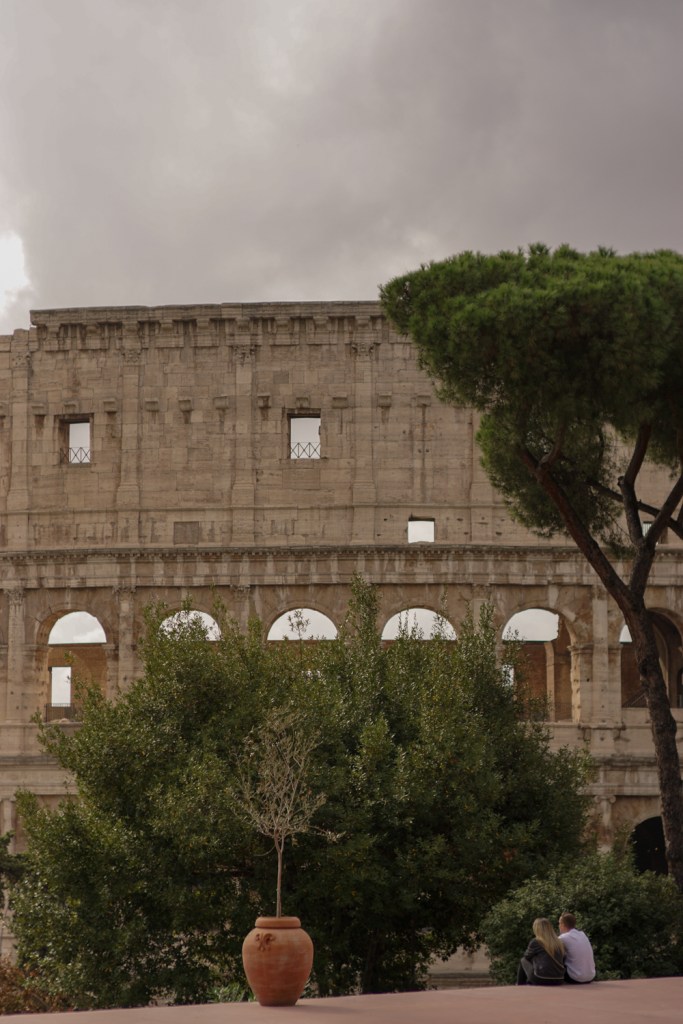
Trajan Forum & Monument to Victor Emmanuel II
From the Colosseum, you’ll begin the trek down the stately Via dei Fori Imperiali , an avenue running in parallel to the Roman Forum and straight to the Monument to Victor Emmanuel II. The Forum is a paid attraction, located on one side of the avenue, but on the opposing side is where you’ll find the Trajan Forum, the ruins of a Roman square that are free to visit. Since you’re already in the area, the Trajan Forum is very quick detour to make along this one day Rome itinerary.
The Monument to Victor Emmanuel II is an enormous white building built out of marble, topped with imposing statues. Built between 1885 and 1935, the building is practically new if you compare it to the long history of its neighboring landmarks. As the name implies, the site was created in honor of unified Italy’s very first king, Vittorio Emanuele II.
Trevi Fountain
The walk to the Trevi Fountain takes about 15 minutes and allows you to casually pass by the family home of Napoleon Bonaparte’s mother . Or, you can take the path which passes by Basilica dei Santi XII Apostoli , one of the most underrated churches in Rome. It’s beautifully filled with Renaissance frescoes, theatrical marble columns, and masterful architecture.
The Fontana di Trevi is a staple of any Rome itinerary and is also convenient to visit as it sits outdoors without any admission fee. The fountain is sculpted to replicate a scene of Neptune, the god of the sea , and his usual surroundings of a chariot and winged horses as he controls the waters. Completed in the late 1700s, this gorgeous masterpiece is still fed by water from one of the city’s aqueducts . With massive recognition, the Trevi Fountain definitely knows how to attract a crowd at any time of the day.

From the Trevi Fountain, it’s a brief ten-minute walk to the Pantheon. If you miraculously have some time to spare, make an impromptu detour at Chiesa di Sant’Ignazio di Loyola . This church is famous for its extravagant ceiling, which is painted in the style of an optical illusion, making the objects look three-dimensional .
Arriving at the Pantheon is most magical at sunset . If you time your day just right, you can try to catch that golden hue which gives the Pantheon an extra touch of photogenic boost. The iconic temple reigns supreme in a couple of aspects but is most known for being the best-preserved ancient Roman building .
Architecturally, it’s considered a marvel and somewhat of a miracle that it’s still intact today. Originally built as a temple for all the gods, the dome is now home to many important figures in Italian culture, including painters, composers, and architects.
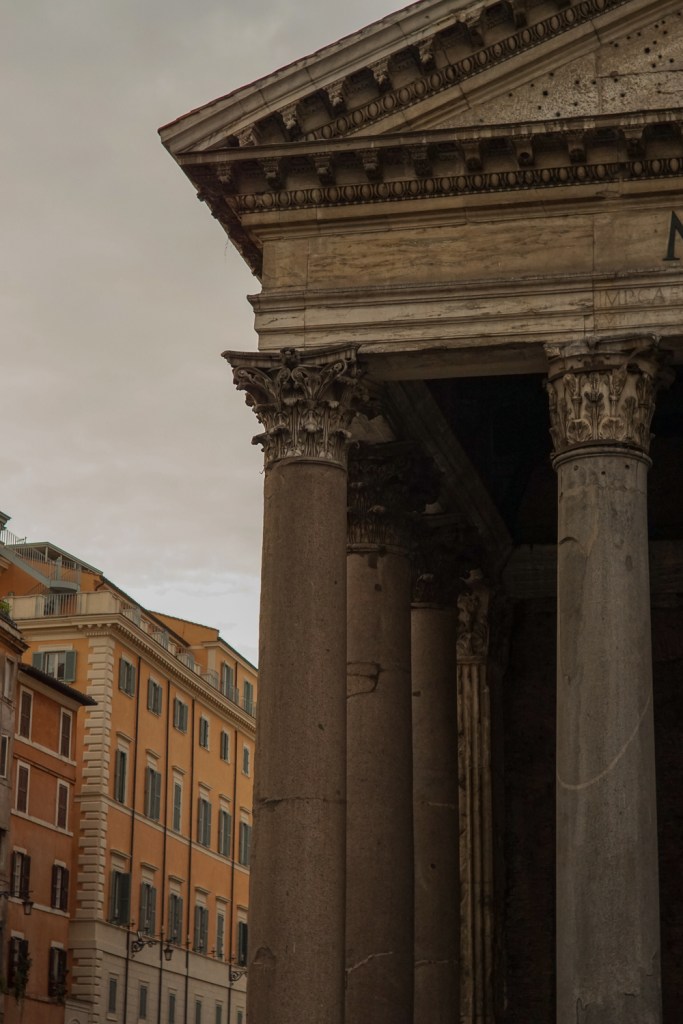
Piazza Navona
Depending on the time of year you visit, your one day in Rome may conclude in the dark. Luckily, Rome is just as breathtaking at night as it is in the daylight . Like all other monuments, Piazza Navona is lit up after the sun sets , which makes its fountains arguably even more intriguing. The square is closed off to traffic and is comprised of three fountains : the Fountain of the Moro, the Neptune Fountain, and the Fiumi Fountain, the largest one. Furthermore, the romantic scene is backed by the magnificent 17th-century church of Sant’Agnese in Agone.
Piazza Navona is the perfect place to bring your one day in Rome to an end with some drinks and dinner . The square is quintessential Rome and lined with one restaurant after another, all boasting dreamy views of the glowing fountains to admire.
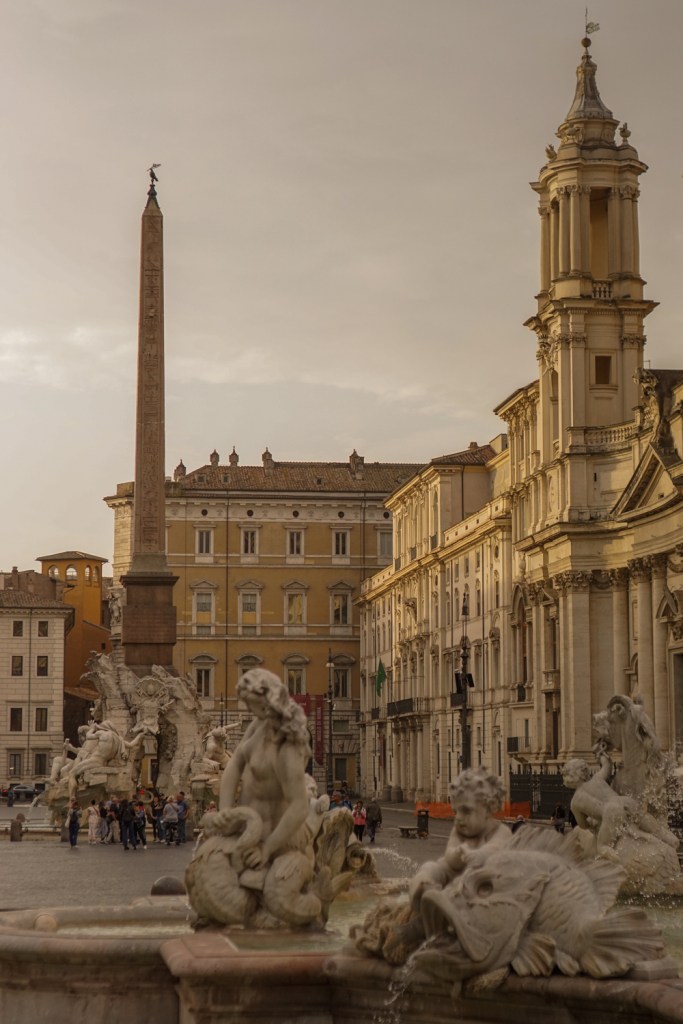
Bonus: Nightlife in Trastavere
Although it’s definitely not a hidden gem, Rome’s best neighborhood goes by the name of Trastevere. The trendy, picturesque, and charming quarter is filled with idyllic outdoor restaurants, vintage shops, and enough bars to last you a lifetime. Trastevere is generally quiet during the day and especially dead before 12pm. The neighborhood thrives after 9pm and is effortlessly the coolest place in Rome to ride into the night.
To add Trastevere as your last stop on this one day in Rome adventure, it’s recommended to take a cab or catch the tram from Arenula/Cairoli towards Trastevere .

IMPORTANT NOTE: This self-guided walking tour of Rome begins in Vatican City and ends at Piazza Navona .
If you are driving to Rome, it’s recommended to park at Parking Piazza Cavour located near the Vatican. In this case, you’ll need to account for the walk from Piazza Navona back to the parking garage at the end of the day.
For travelers who are spending the night in Rome , it’s recommended to choose accommodation near the ending point of Piazza Navona.
FAQs for Seeing Rome in One Day
The best part about this one-day itinerary in Rome is that it can be completely free . Without factoring in the cost of either parking or public transportation to get into Rome center from the airport, you don’t have to spend anything. Firstly, it is possible to spend one day in Rome for free by walking the route instead of taking the metro, bus, or taxi . Secondly, you’ll need to make the choice to not enter any of the sites and simply admire them from the outside instead.
Alternatively, the amount you spend on one day in Rome can vary depending on how you choose to get around and what you see. If you opt for taking a Hop On Hop Off bus instead of walking, expect to pay around €25 per person for transportation. On the other hand, one metro ride in Rome only costs €1.50 . Visitors who are set on entering one or two attractions should budget for admission costs. You can expect to pay around €30 for entrance to the Vatican and €40 for the Colosseum .
Dining in Rome is another aspect of your daily budget to keep in mind. If you’re on the go and don’t want to stop for a sit-down meal, you can find sandwiches and similar “hand” food for €5 . A traditional experience at a trattoria or ristorante will cost anywhere from €15 – €40 per person depending on how fancy you get.

Your one day in Rome should be considered precious, assuming you are on a mission to make the most of it. The one activity that isn’t worth the time and doesn’t provide an authentic experience of Rome is shopping for souvenirs. Rome has no shortage of small shops and even curb side tents where products are literally dumped on tables and priced at low prices. Aside from wasting time, sifting through the plastic figurines and low-quality bracelets is not what Rome is about.
Need better ideas for souvenirs from Rome? Consider the Italian staple candy “Pocket Coffee” or a small vintage item from an antique store like Bruschini Tanca Antichità . Additionally, activities and experiences are a much better alternative to traditional souvenirs!

This self-guided walking route for one day in Rome is roughly 9 km (5.6 miles) long. However, this doesn’t take into consideration the walking you’ll do around the attractions and any detours made to find a bite to eat or a gelato cone. It is effortlessly possible to end up walking as much as 16 km (10 miles) during your one day in Rome. This means the number of steps you’ll take can range from 12,000 steps to 22,000 steps in just one day.

We have multiple experiences with parking in Rome. Somehow, they were all different from one another which just goes to show you how unpredictable the city can be. One time, we stayed about 5 km south of the city center and ended up parking our car on a curb for four days with zero questions asked and no tickets. Unfortunately, the closer you are to the city center, the tougher everything is for travelers with a car.
Street Parking
If you are lucky, you can attempt to find street parking, but remember, it must be outside of ZTL zones . In Italy, you’ll see signs for ZTL zones, which are limited traffic zones and essentially mean you cannot drive there as a non resident. Hefty fines are handed out for disobeying these zones during the posted times.
Street parking in Italy is fairly simple to understand. White lines mean it’s free . Do not plan on finding free parking as your plan A. Blue lines mean you must pay hourly or for up to 8 hours at a time (either at the meter or with the EasyPark app ). Street parking fees vary by location but will typically cost around €1.50 per hour. Parking spots marked with yellow lines are a no-go for regular cars.
Parking Garages
There are very few large parking garages in the centre of Rome, especially on the east side of the Tiber River. Near the historic quarter of Rome, you’ll only find small garages that are tricky to enter and may not even fit your vehicle if you’re driving anything larger than a Fiat. We’ve parked near the Colosseum where the cost ended up being around €20 for just 4 hours. This is comparatively normal for Rome but otherwise, not very affordable.
For tourists visiting Rome for the day, the best parking garage is behind the Supreme Court. You’ll find it as Parking Piazza Cavour on Google Maps and the cost is just under €3 per hour. The garage is enormous with many spots, secure and easy to get in and out of.
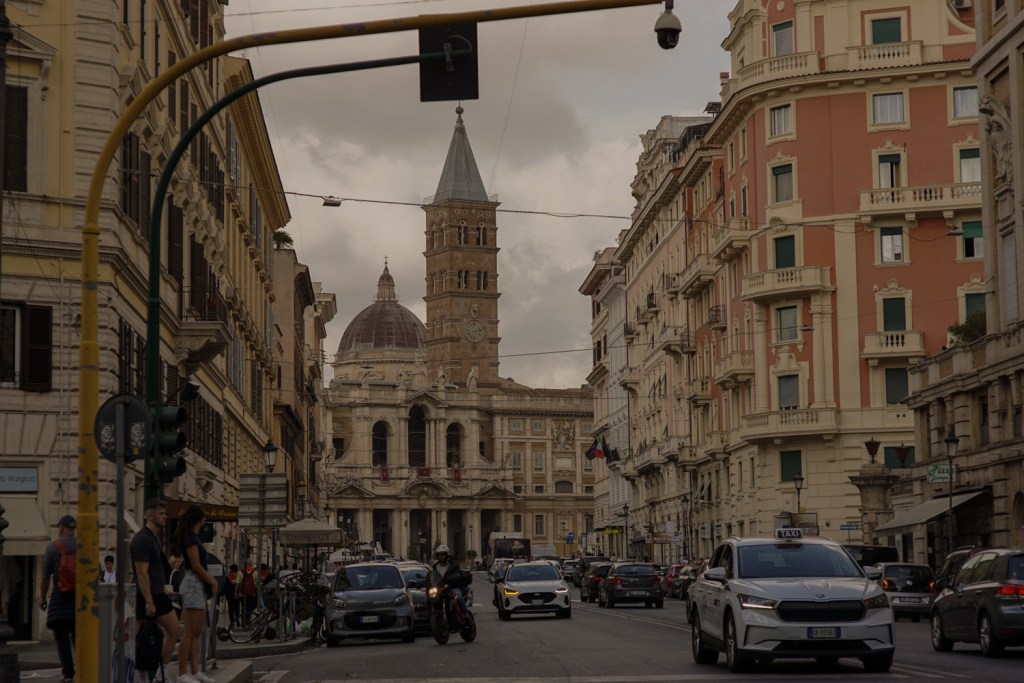
There are many reasons why travelers may need to store luggage during their day in Rome. Whether you’re in the city for a long layover, checking in/out at an odd time, or only spending a few hours in Rome before catching a train, ditch your luggage for a less stressful experience. Trust us, nobody wants to be the person dragging around luggage on the noisy cobblestone roads around the Colosseum.
Thankfully, it’s a common problem, which means there are many solutions in a tourist destination like Rome. You can simply search for “luggage storage” on Google Maps and you’ll see a number of luggage storage points, with a ton located near Termini train station . Additionally, you can even walk into any hotel, whether you’re staying there or not. Most hotels will be happy to hold onto your luggage for a fee.

Leonardo da Vinci Airport is Rome’s international airport that’s located 30 km west of the city centre. There is an amazing designated train service that takes passengers from FCO Airport to Termini Station in just 30 minutes . Unless you’re travelling in the middle of the night, the train is even quicker than driving to Rome.
The cost for the Leonardo Express train is €14 one-way and can be booked either on site or online. If you’re the type who likes to be prepared and don’t want to waste time in the ticket line, book tickets for the Leonardo Express in advance.

Best Trevi Fountain Stay
V-Accommodation IV Fontane
Best Vatican City Stay
Erreggi Luxury Rooms
Best Termini Station Stay
Rome To Stay
Best Spanish Steps Stay
Dopodomani Suite
Best Boutique Hotel Stay
Nerva Boutique Hotel
Best Hostel Stay
Free Hostels Roma

Affiliate Disclaimer: Please note that some links found in our posts are affiliate links. Should you choose to purchase through these links, we may receive a small commission at no extra cost to you.
Share this:
7 thoughts on “one day in rome itinerary and self guided walking tour”.
Pingback: The Best Time to Visit Vatican Museums, FAQs and Tips - Adventures of Ace
Pingback: A Guide on the Rome to Barcelona Ferry - Adventures of Ace
Pingback: What Do Italians Eat for Breakfast? - Adventures of Ace
Pingback: Discovering The Trabocchi Coast in Abruzzo - Adventures of Ace
Pingback: Planning a Family Trip to Italy on a Budget - Adventures of Ace
Pingback: How to Get to Sicily From Rome (And Mainland Italy) - Adventures of Ace
Pingback: 16 of the Best Free (And Cheap) Things to Do in Naples, Italy - Adventures of Ace
Leave a Reply Cancel reply
Discover more from adventures of ace.
Subscribe now to keep reading and get access to the full archive.
Type your email…
Continue reading
Walking Tours in Rome
Rome isn’t a big city, and walking is by far the best way to see it. Finding ancient remains nestled between shops, pieces of ancient statues decorating the sidewalk, and churches filled with mosaics and artistic masterpieces is part of the Rome experience that can only be enjoyed walking through the Eternal City.
Is Rome a Walkable City?
Rome wasn’t designed for cars, but it’s perfect for walking. From Piazza Venezia , the Colosseum , Pantheon , Spanish Steps , Trevi Fountain , Piazza Navona , Campo dè Fiori , and the Jewish Ghetto are all less than 20 minutes away on foot, meaning you can see a lot in a day at a leisurely pace.
Summer in Rome can be hot, so be careful, especially in July and August when temperatures are often around 100°F/38°C. Rome has a lot of wide streets, open squares, and archaeological parks that offer little shade during the heat of the day.
Try to start early, stay inside during the hottest part of the day, and come out again in the evening when the city is cooling down like the locals do.
Conclusion: Rome is a walkable city if you are used to walking and avoid walking when the sun is hot.
Is it Worth Doing Guided Walking Tours in Rome?
With more than 2000 years of emperors and popes to get your head around, not to mention the artists and aristocracy who have lived in Rome, taking a guided tour can help you make sense of what you are seeing and prevent information overload.
Tour operators also have access to exciting options that are not available to the general public, like the chance to be the first to enter the Sistine Chapel in the morning or visit the Vatican Museums after hours.
But you don’t need a guide for every place. Rome is beautiful even if you don’t know the history of what you are seeing, and some places, like the catacombs and the Domus Aurea, can only be visited with their guides, so the tour is included in the ticket price.
Conclusion: Guided tours can give you exclusive access to some locations and help you to focus on the most important details at the most popular sites, but there’s also a lot you can see on your own.
How do Guided Tours Compare to Self-Guided or Free Walking Tours?
If you want to keep costs low, many places in Rome are easy to visit on your own with a guidebook. Get a map and plan a themed route, for example:
- The squares and fountains of Rome
- Bernini sculptures (minus Galleria Borghese )
- Churches with Caravaggio paintings
- Medieval mosaics
- Ancient monuments
Or create your own street food tour by picking the best places to try supplì , pizza al taglio , trappizzino , tiramisu, and gelato , passing beautiful monuments on the way.
Free walking tours are another option if you don’t want to break the bank. These kinds of tours will show you a small part of the city. They usually last a couple of hours at the beginning or end of the day and don’t include any entrance fees, and are tip-based at your discretion.
Conclusion: If you’re on a budget, guided tours aren’t your only option. There are some excellent resources you can use to explore on your own and free tours that can offer an introduction to some of the monuments in the city center.
What Should I Look for to Find the Right Walking Tour for Me?
Do you want a group tour? A small group tour? A private tour? Consider your budget and the kind of experience you want to find the right tour .
Group Tours
While a group walking tour might cost you €50 per person, you could be with 30+ other people, with little chance of interacting with the guide, who is hooked up to a radio system. However, these tours can be great if you just want to hear a little information about a place, to know what’s important to look at and don’t feel like reading a guidebook.
Small Group Tours
Walking tours with fewer than 10 people in a group will cost more (think around €100 per person), but you can ask questions and talk to other people in the group. The guide will have some flexibility to adapt the tour to the ages and interests of the group, offering you a more personalized type of tour.
Private Tours
Private guides offer maximum flexibility and, for families traveling together, may not be the more expensive option. Some guides specialize in history, art history, or archaeology, and some offer tours for younger travelers. Private guides will arrange your tickets and transportation or start the tour at your hotel, so you don’t have to worry about meeting points.
Tips for Choosing a Walking Tour in Rome:
- Check the list of places visited carefully and whether the tour includes entrance to a site or just an external view.
- The Colosseum , Forum , and Palatine are on a single ticket. If a tour includes the Colosseum and Forum, you won’t be able to go back in on your own to visit the Palatine without buying another ticket.
- The basic Colosseum tickets do not include entrance to the underground. If seeing that is important to you, make sure you’re booking the right tour.
- Most walking tours last about 3 hrs, and (group tours) won’t include stops. Walking is usually at a leisurely pace, but if you don’t think you’ll be able to stand for so long, consider a golf cart tour instead.
Conclusion: Take time to compare different tours and see what each one offers. Doublecheck if entrance to the sites you want to visit is included on the tour and in the price before booking.
Can You Walk Rome in a Day?
The historic center of Rome isn’t big, but there’s a lot to see. The Colosseum to the Vatican Museums would take you about an hour on foot and wouldn’t be the best use of your time.
If you only have a day in Rome , I suggest choosing either the Colosseum or the Vatican Museums. A tour of either site will take about 3 hours. Then you can enjoy the rest of the day walking around the center where Piazza Navona, the Pantheon, Spanish Steps, and Trevi Fountain are easy to walk between.
Conclusion: You can’t walk Rome in a day if you plan to visit the Vatican Museum and the Colosseum. Two days would be the minimum to do walking tours of both sites and to visit the most important monuments of the city center.
Are Night Walking Tours Worth Doing?
Rome is another kind of beautiful at night, with lights on many of the monuments, cooler temperatures, and no crowds. If you arrive in the afternoon and are ready to start exploring Rome, a night tour is a wonderful introduction to the Eternal City.
Most night tours will include the Trevi Fountain, Pantheon, Spanish Steps, Piazza Navona, and possibly Castel Sant’Angelo and St. Peter’s on the other side of the river. However, some focus on darker parts of Rome’s history, like stories of the Inquisition.
Conclusion: Rome is worth seeing at night, and some companies offer tours that include some of the city’s most famous monuments. This is also an easy self-guided option with GoogleMaps.
Tips for a Great Walking Tour Experience
- Don’t book a walking tour if you can’t walk at a leisurely pace for 3 hours. Think about doing a bus or golf cart tour instead.
- Wear comfortable shoes. If you’re visiting any ancient sites, it’s best to wear closed shoes.
- If your tour includes any churches, remember to respect the dress code and cover your shoulders and knees. Carry a light scarf in your bag so you’re ready any time you pass an interesting-looking church.
- In the summer, bring sun cream, a sun hat or umbrella, and a water bottle with you. Rome has many water fountains where you can refill your bottle for free.
- Avoid outdoor tours during the middle of the day in summer. Try and book tours at the beginning or end of the day when the weather is cooler.
- In winter, bring an umbrella. Rome doesn’t have a lot of heavy rain, and tours will go ahead as long as the sites remain open.
- Book tours in advance, especially if you want hard-to-get tickets, like Galleria Borghese or the Colosseum Underground, and make sure you understand the cancellation policy.
- Finally, always check what other travelers have said in online reviews to know what to expect before you book.

In an imaginary competition of European cities over cultural heritage, Rome would be without match. Its combination of haunting ruins, soaring domes silhouetted against distant hills, and ornate palaces serves as a constant reminder of its place at the forefront of European history.
Urbs' audio tours of Rome are the ultimate way to see the sights, including the many hidden gems dotted throughout the city. Whether you’re visiting for a day trip or longer, there’s no better way to take it all in than a self-guided walking tour of Rome.
The Urbs Way
Listen & discover.
.png)
Enjoy 4+ hours of audio content written by cultural experts Explore 70+ fascinating cultural locations Discover 150+ restaurants, cafes, bars and shops recommended by local writers
Plan your route.
.png)
Plan your perfect day with our unique route plotting function You can also use one of our curated routes which can be amended according to interests, schedule and budget
Book tickets.

Find out which locations require tickets Book attractions and activities in advance to avoid the queues

When in Rome
From the romance of the movies, to the history of the Roman period, from fast-fashion, to fast cars, and not forgetting some of the best food in the world. Rome is one of the most charming cities, that will have you under its spell in no time.Self-guided tours of Rome are undoubtedly the best way to see the city. With an abundance of information to take in, be it by foot or car, an audio tour of Rome allows you to take it all in as you go. Simply download the app to your smartphone, plug in your headphones and get ready for a sensory journey like no other. Best of all, you get to curate your own waking tour, using recommendations from experts.
Explore the very best of Rome
Whether you’re a lover or a blogger, a family or a couple – you’ll find everything you came for in Rome. If you’re not sure where to start, here are just some of the highlights and locations to add to your schedule anytime anywhere to ensure your self-guided walking tour of Rome is epic!
World-famous architecture
As you’d expect for a city 2,800 years old, there’s plenty of culture, history and fascinating things on every corner. For jaw-dropping architecture, head to the Roman Forum and the Colosseum for ruins that span back decades. Along the way you’ll likely stumble across the Spanish Steps at the foot of the Piazza Trinità dei Monti. Finally, cameras at the ready for Castel Sant Angelo – a towering monument nearly as old as the city itself.
La Dolce Vita
The Italians call it ‘La dolce vita’ – you might know it as the good life. Rome isn’t just for sightseeing after all, it’s for taking in all that’s good and great about local culture – not to mention the epic gelato! Wander around a piazza, throw a cent in a fountain and make a wish! Listen to local music over a delicious gelato, and have a leisurely coffee whilst checking your email at a local café. It’s amazing how you can lose a day to its comforting cobbled streets – Europe at its finest.
Rome is an open-air museum in itself, but some of the real gems are to be found in its galleries and museums, where simply everything is impressive. You’ve probably seen friends take selfies on their Facebook page at the National Gallery of Modern Art, which is a must for art-lovers featuring over 4,400 works of art. Another to add to your audio tour of Rome are the Capitoline Museums, said to be the oldest in the world, and full of ancient artefacts. Go at your own pace with the Urbs app and take it all in.
Pizza, pasta, primi
Italy’s devotion to food is best experienced in Rome. As seen in the film Eat Pray Love, it’s a city of culinary exploration as much as anything else. This is not hard to miss, since great food is easy to come by. If you’re here for the pizza, and let’s be honest, who isn’t, then hot-foot it to Pizzeria Ai Marmi, an institution in the city that will remind you why Italians do the best pizza.
Religious landmarks
As you explore the city, be sure to add Vatican City and the Vatican Museums to your audio tour of Rome. It’s one of the top sites, attracting visitors from all corners of the world - from Australia to Greece and all that’s in between. As well as the masterpieces on show and the dazzling architecture, it’s the perfect place for reflection as the home to the Pope of the Catholic Church.

Rome by app
The Urbs app is designed to help you get the most out of your trip. Simply download the app on your iPhone or Android smartphone, and start to plan your route. Did you know that there’s more to the app than just audio tours? Here are a couple of additional benefits…
Insider tips
Sure, you want to visit all the big ticket events and locations. However, you also want to get off the beaten track. Our team of cultural experts and local writers have selected their favourite attractions, so you can mix and match your trip and create a one-off experience and audio tour of Rome.
Get your tickets
Rome is a busy destination with visitors all-year round. Don’t miss out on the top attractions – instead use the app to book tickets and save them to your smartphone.
Do it your way
The joy of curating your own self-guided walking tour of Rome is the option to go at your own pace. Choose from pre-selected walking tours, or build your own. The interface is easy to use and accessible.
Download the app
Planning a trip to Rome? Then don’t miss the chance to access the city in this audio feast, now available to download on Android and iOS devices.
.png)
Ready for your next adventure? Don’t forget to pack your headphones and take Urbs with you.

Best things to do and see in Rome
A free walking tour is one of the best ways to visit Rome , the historical city rich with culture and unmatchable in its beauty. Some people may feel like they are in one of the largest outdoor museums in the world because of its multitude of churches, squares, monuments, and amazing fountains along with its Mediterranean cuisine that embodies the local flavors. Getting to know this city with the help of a local guide will aid you in discovering all those mandatory stops to visit and some of the lesser-known gems this amazing city has to offer.
Visiting a city of this magnitude is a real challenge, and is why we recommend different routes that offer alternatives and less crowded routes to get the most out of your guided visit to popular destinations like; The Coliseum, Saint Peter’s Basilica, The Roman Forum, the Trevi Fountain, the Pantheon, The Vatican Museum, or Navona Square. There are guided visits in Rome which focus on the Sistine Chapel, Castel Sant’Angelo, the stairway to the Spanish Square, the Villa Borghese, the Trastevere, the People’s Square, (Piazza del Pópolo) and even the interesting street culture at the Campo de' Fiori Square. You can read more about best things to do and see in Rome.
If you would like more information about what it’s like to do a free tour in Rome in the morning, afternoon, or evening , you can read up on the opinons of other walkers who have already done a guided tour with GuruWalk. Often times, those who have done one end up coming back to the page to find another free guided tour we offer, especially when they want to learn more about other beautiful Italian cities like Genoa, Venice, Milan or Palermo.
Free walking tour near Rome
Others cities to visit after rome, find other guruwalks in rome, where are you traveling to.
How to get your 10 thousand steps on Venice Beach

Jun 1, 2024 • 6 min read

The best way to explore Venice Beach and its eclectic boardwalk is on foot © Getty Images
In our 10K steps series, we've asked writers for the best places to get in your steps while enjoying city sights, favorite routes and some secret detours. In this one James March takes us around the colorful and chaotic streets and boulevards of Venice Beach.
Los Angeles’ coast stretches 75 miles, but little of that sun-kissed shore is as iconic, colorful or strange as Venice Beach .
Flanked by Santa Monica to the north and Marina Del Ray to the south, Venice’s waterfront is one of the most eclectic and iconoclastic public spaces in California and has been officially part of LA since 1926. But there’s far more to Venice than just its chaotic boardwalk . From languid canals to sleek skateparks, a wander around this bizarre corner of LA is an assault on the senses like no other and all are welcome in Venice’s potpourri of hippies, misfits, performers, artists and beatniks.
The best way to soak it all in is via a looped walk, so here’s how to follow my favorite route.
Where to start: The Venice Sign
You’ll see the famous Venice Sign again later this evening (in a much brighter fashion), but it’s also a good starting point for our walk. Industrial-chic breakfast spot Eggslut is around the corner if you need a bit of pre-walk fuel with one of their (unsurprisingly) egg-heavy sandwiches. Otherwise, head east on Pacific Avenue before turning north on S Venice Blvd and joining the Venice Canals towpath.
Meander the Venice Canals
Comfortably the most peaceful corner of Venice, these saltbush-fringed canals look nothing like the rest of the neighborhood. Or LA, for that matter. With arcing white bridges, a soft color palette, swaying palms and handsome water reflections, the canals are wonderfully photogenic and don’t be surprised if you feel a pang of jealousy toward those living here.
Each waterside house is different, with the big-windowed Scandi-style modernist apartments the most seductive (in this writer’s opinion). There’s little wind here too, compared to the beach, which only adds to the joyous serenity. Watch for cormorants, herons and other birdlife splashing down as you stroll.
Exit the canals and stroll north on S Venice Blvd. Walk for around 10 minutes, past the Abbot Kinney Memorial Branch Library and turn left on Abbot Kinney Blvd. Abbot Kinney himself was the 19th-century founder of the canals (he successfully changed the name of this area from Ocean Park to Venice in 1911, due to his fascination with the Italian lagoon city) and now this popular street is named after him.

Stop for quality coffee on Abbot Kinney
Affluent Abbot Kinney Blvd perhaps more closely resembles other LA neighborhoods du jour like Silverlake or Brentwood, though there are some nods to its coastal location, like the pseudo wooden beach shack hosting a Ray-Ban outlet (check out turquoise Goodr cabin further down the street for more affordable shades). Speaking of shops, there are plenty of ways to empty your wallet here, from overpriced smoothies to myriad retro clothing stores.
But this sophisticated stroll is also splashed with cool murals and some excellent restaurants and coffee stops, with the airy Intelligentsia the pick of the bunch. Natural light pours down on its wood-paneled central station as organic blends are poured to the sound of bouncy jazz beats (though prepare for the occasional patience-testing line).
Reasonably-priced tacos can be grabbed at family-owned Tacos Por Favor on the corner of Electric Avenue and Hampton Drive, otherwise continue north along Hampton and past the iconic Golds Gym (Arnold Schwarzenegger still pumps iron there from time to time allegedly, though you’ll need to be up at the crack of dawn to catch him). Make a zig-zagging path to Navy St, before eventually emerging onto the northern end of the Venice boardwalk.
Hit the boardwalk
Cannabis smoke drifts, drums thump, neon bikes glimmer, handheld stereos blast, low-flying helicopters hum, people shout, others sing and hot dog stands hiss. Your senses aren’t so much assaulted in Venice’s epicenter as bludgeoned. The boardwalk is kitschy and trashy but always compelling.
With the sun a little stronger and everyone feeling a little looser, mid-afternoon is the best time to experience the boisterous boardwalk where people watching never felt so exhilarating. Duck into Small World Books for a slice of cerebral calm, and only use the beach’s public restrooms if it's really necessary.
Make the leisurely walk south at your own pace and stop at any vendor that catches your eye (there are over 200 to choose from). People here are always willing to chat and chances are you’ll meet some curiously dressed characters who may or may not tell you their life story. Sidewalk Cafe is a breezy spot for a cold afternoon beer and it’s also adjacent to the skate park, which is our next port of call.

Admire some serious skating skills
When LA’s soft late-afternoon light hits Venice’s sunken skatepark a sublime scene forms, with talented local skaters turned to gliding silhouettes fringed by tall skinny palms. The vibes are always good, with tourists and friends watching and applauding the flicks and tricks on show.
The sound of the nearby waves breaking is amplified here, and the genial encouragement alongside the funky beats from the roller skating dance plaza behind makes the atmosphere fun, especially when there’s back-and-forth banter between skaters and their friends behind the rails.
It’s not far from LA’s lapping shores here, so maybe go for a quick paddle in the Pacific while you have the chance. Head back down to the boardwalk and stop by at the famous Muscle Beach where you might catch an adonis or two working on their bench press.
Arnold, the original Incredible Hulk Lou Ferrigno and many more have trained here during bodybuilding’s 1970s golden era. Though these days it's the relentless clack of couples playing paddle tennis from the courts behind that’s more popular. Stroll past the restaurants and bars of Windward Avenue and take a right at the Venice Sign where you’ll head inside the Hotel Erwin .
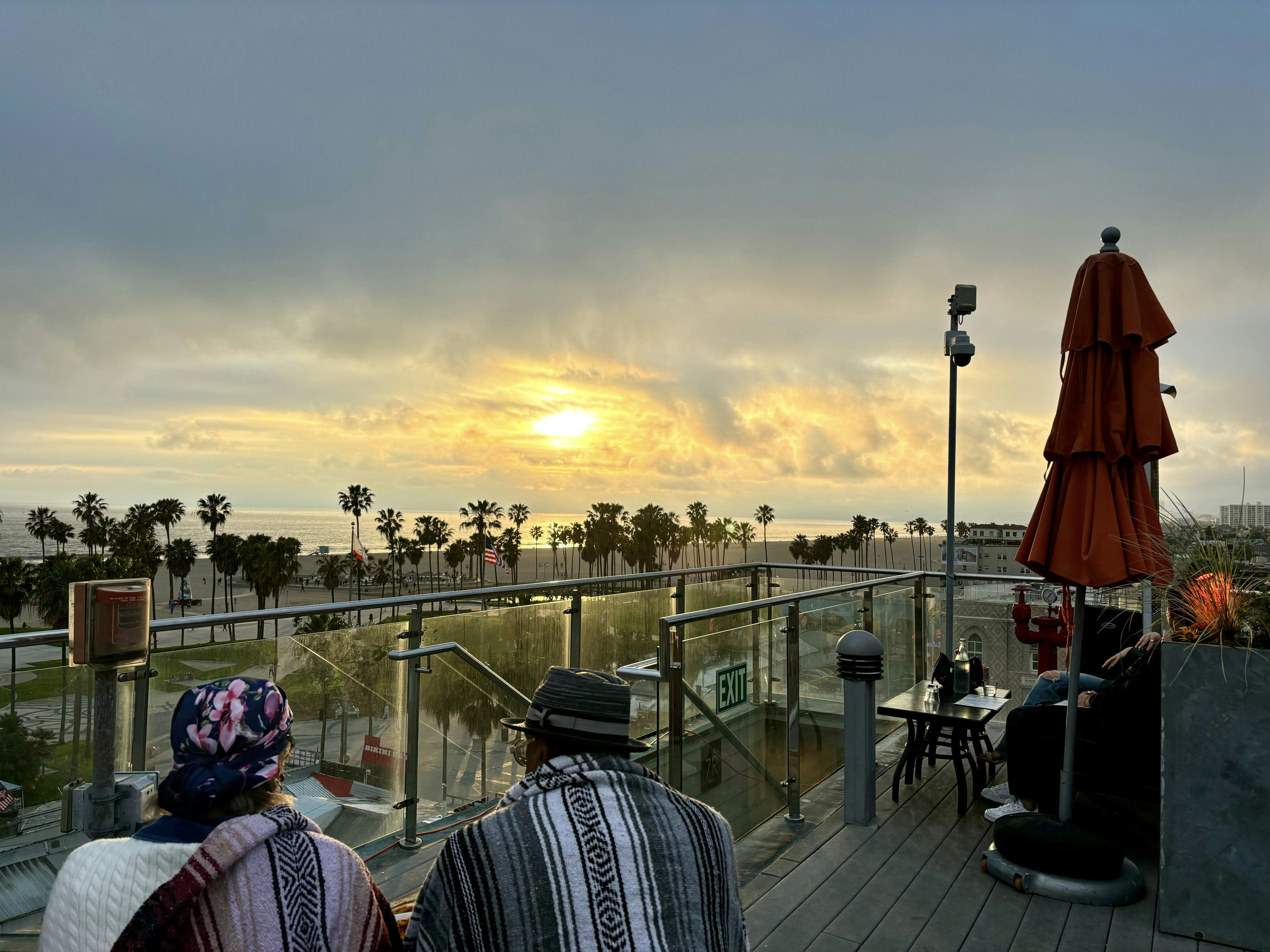
Soak in sunset rooftop views
Surprisingly, there’s only one place in Venice with a rooftop patio, and this is it. Lined by blood orange parasols, the Hotel Erwin’s 7th-floor deck is huge and stretches the entire length of the hotel. And on a clear day the views are genuinely panoramic, with downtown’s hazy skyscrapers visible and the high craggy Malibu Hills stretching east to Hollywood and beyond.
If you time this walk right, you’ll catch a golden sunset settling over the lights of Santa Monica Pier . Many of the sofas will be reserved, but the bar and the high tables on the left-hand side are available to all comers.
You can order food at the Erwin or take the elevator back down to Windward Avenue below for more gastro options (the smoky mezcal served at the Del Monte Speakeasy inside Townhouse is a favorite of mine). But since you’re here and night has fallen, don’t forget to cross over Pacific Avenue and take a photo of the Venice Sign now that it’s all lit up and strung out in its green, white and red glory.
Explore related stories

Walking Tour
Jun 4, 2024 • 7 min read
Get out of the car and pound the pavement along LA’s Sunset Blvd to discover chic hotels, infamous party spots, plenty of laughs and more.

May 24, 2024 • 6 min read

May 15, 2024 • 5 min read
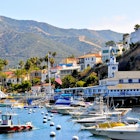
May 7, 2024 • 7 min read

Apr 29, 2024 • 7 min read
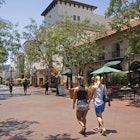
Apr 17, 2024 • 8 min read

Apr 14, 2024 • 8 min read
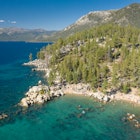
Apr 13, 2024 • 6 min read

Mar 19, 2024 • 8 min read

Mar 15, 2024 • 10 min read

11 Fun Things to Do in Rome with Kids (2024)
T here are so many fun things to do in Rome with kids, but can be overwhelming to plan a trip. It is a wonderful city to enjoy with children, who will love the ruins, the people, and the gelato! The Eternal City is beautiful any time of year, but the crowds will vary depending on the weather and school holidays. Our best advice is to have a plan and make reservations for the more popular tourist sites, but leave time for wandering the squares and enjoying la dolce vita.
*Disclosure: This post may contain affiliate links, which means we may receive a commission if you click a link and purchase something that we have recommended. Please check out our disclosure policy for more details. Thank you for your support!
How to Get Around Rome
From the rome airport to rome’s city center.
Do not plan on arriving at the airport, taking a shuttle to the train station (Termini), and then a taxi to your destination. You will be jet lagged and you will have dead tired children and luggage in tow.
Arrange for a driver through your hotel ahead of time. The cost is comparable to the shuttle/train/taxi formula.
From Termini train station to your hotel
Termini is not a place you want to hang out for a long time, nor is it a place where you want to stick out like a sore thumb. With kids and luggage, it’s hard to hide the fact you are tourists so be sure you know how the taxi system works.
Licensed, official taxis are white, with a TAXI sign on top, a Rome crest on the door, with the letters SPQR. They will also have the taxi license number on the door.
If your group is larger than 3 people, look for a van that can fit everyone in your party. Vans are not as common, but they save you the option of taking two separate taxis and paying double the fare.
Public Transportation in Rome vs. Walking
We did not use the Metro system while we were in Rome, but have on previous visits. It is very efficient and easy to use but we walked everywhere.
Were there complaints about all the walking? Yep? Did we care? Not really. We always tell them it’s exercise and it’s good for them. After we bribe them with gelato they stop complaining, LOL.
What to do in Rome with kids
Our best tip is to avoid Rome during major holidays. The crowds are crazy and things close for no rhyme or reason. We have plenty of ideas on how to skip the lines in Rome .
1. Visit the Vatican Museums and the Sistine Chapel
At least once during your time in Rome, you must head to Vatican City. Vatican City is the smallest country in the world and home to the Pope, Swiss Guards, and others who support the Holy See. While younger children might not be able to fully appreciate the chapel and museums, it’s a must-see for parents and older kids visiting Rome.
The best way to see the Sistine Chapel is by purchasing entrance tickets in advance through their ticket office . Once booked you will receive a voucher that confirms your tour time.
Upon arrival, skip the queue and begin your self-guided tour. If you want a guided tour, we would recommend this guided tour or this private tour with Context Travel.
Before or after your visit to the chapel, head to St. Peter’s Basilica. Here you will find the tombs of former popes, monarchs, and other important figureheads of Ancient Rome.
You can climb to the top of the Basilica’s dome, but you will need to pay a separate entrance fee. Climbing the stairs has one fee, but you will incur an extra cost if you wish to use the elevator. If you want a guided tour of St. Peter’s and the dome, this is the tour for you .
*Note: You will still have to wait in line for security at both the Sistine Chapel and the Vatican. Sometimes lines can be very long, so we recommend going first thing in the morning or the early afternoon.
2. Colosseum – Roman Forum – Palatine Hill
Let me save you some heartache (and money). Do not wait in the long line at the Colosseum. Go to the Forum (or Palatine Hill) and buy your ticket there. It will cover the entrance to each of the sites and is valid for two days. Better yet, buy your tickets online .
The Roman Colosseum is one of the best-known attractions in Rome and a place the whole family can enjoy. Consider taking a tour that allows you to explore the arena floor and the Colosseum underground . This is THE place to go to learn about Rome’s ancient history.
If your kids want to know more about Ancient Rome and learn about life as a gladiator, we highly recommend taking them to Gladiator School.
Classes take place at the Gladiator School of Rome on Via Appia Antica, and ages 6 and up are welcome. Guests will learn fun facts about the ancient city, and basic gladiator skills, and channel their inner warriors.
The Forum used to be the center of Roman society – political, social, and religious events all took place here. Today it has the ruins of public buildings, markets, temples, and other important structures. Palatine Hill is one of the original seven hills the Roman Empire was built on and provides stunning views of the Forum and Circus Maximus. It’s a peaceful place with stunning views of the city.
We toured the Forum and Palatine Hill the day after we toured the Colosseum and were equally impressed by the ancient ruins. There are so many nooks and crannies to explore. The kids loved every minute and never complained about the five hours we spent between the three sights.
3. Throw a coin in the Trevi Fountain
What’s not to like about an enormous fountain with a giant statue of the Roman god Neptune standing atop a shell-shaped chariot pulled by sea stallions?
Children and adults of all ages flock to the Trevi Fountain for people-watching, coin-flipping, and of course, gelato-eating.
I think there are no fewer than five gelato shops surrounding the fountain, so take your pick and find a flavor that suits you. Before leaving, turn your back to the fountain and throw a coin over your left shoulder. Legend has it this will guarantee a return trip to Rome.
4. Piazza Navona
Piazza Navona is one of my favorite places to take the kids in Rome. The piazza is pedestrian friendly so children can run around and parents don’t worry about them getting hit by cars or the ever-present Vespa scooters.
The place is lively, filled with tourists and locals alike admiring the beautiful fountains or lounging at the multiple cafés ringing the piazza.
There are plenty of little shops along the perimeter where adults can grab a cappuccino while the kids burn off some energy. Walking around the square is one of my favorite things to do in Rome at night .
If you are looking for other car-free areas where the kids can run free, head to Piazza del Popolo, Piazza di Spagna, and Campo de’ Fiori (home to Rome’s most popular daily market which is open every day but Sunday).
5. Pantheon
On our first visit to the Pantheon, our boys were unimpressed by the 2,000-year-old sacred temple. All they saw was an old building, columns, and an enormous hole in the roof. They took one look and then headed back outside.
A few days later we returned when we were caught in a torrential downpour. The water came rushing through the ceiling like a raging river, drenching those of us standing nearby.
Our kids will never forget the sonic boom of thunder as it resonated through the dome and the screams of terror shouted by hundreds of people at the same time. Let’s just say they still talk about it to this day.
6. Spanish Steps
This used to be a famous spot for people watching and simply relaxing, but it is officially illegal to sit on the steps these days. So take a quick look and head to the gelato shop for an afternoon treat.
If you have time, check out the McDonald’s next to the Spanish Steps, one of the largest in Europe. The lines inside will be long, but it’s one of those things you should do since you’re there. Trust me on this one, especially if your kids can’t take one more meal of pizza and pasta.
Where to Eat Gelato in Rome
No Rome family vacation would be complete without gelato. We tried four different gelato (ice cream) shops and some we tried more than once (it is vacation after all).
Here were our two favorites in Rome, and if you are traveling around, here is the best gelato in Italy .
Giolitti, Via Uffici del Vicario, 40 – Giolitti has been dishing gelato since 1890 and everyone loves it. Go in the front door, pay for your gelato at the register up front, get a ticket, then get in line to order your gelato. Enjoy the creamy goodness outside like everyone else because there’s an extra charge to eat inside.
La Gelateria Frigidarium , Via del Governo Vecchio, 112-One of our favorite gelato places. Good selection of flavors, including the option of dipping your gelato in chocolate. Yum!
7. Catacombs
If you want a unique archaeological site that is sure to impress kids of all ages, head to the catacombs. There are more than 60 of these underground burial chambers in the city, but only 5 are open to the public.
The Catacombe di San Calissto (Catacombs of Saint Callixtus) is the most visited and it covers over 35 acres across 4 different levels. Saint Domitilla Catacombs is one of the largest.
Several companies offer guided tours of the Catacombs or you can use public transport.
Note: All of the catacombs are found outside of the city and if young children are afraid of the dark, I would not recommend a visit.
8. Castel Sant’Angelo
Castel Sant’Angelo is an experience that will make a big impression on all ages. The site was originally a mausoleum built for Emperor Hadrian in the 2nd century AD, and since then it has been a castle, a prison, and now a museum. Kids will marvel at the stunning statues that line the entrance to the building.
The interior is equally stunning with its beautiful frescoes, lavish rooms, and breathtaking city views from its rooftop terrace. This is a great way to learn about the city’s rich history and it’s a great place to visit on a rainy day.
9. Try a cooking class
If you want to impress the kids, consider booking a pizza or gelato-making class, or maybe one that does both! This hands-on cooking class is perfect for all ages and teaches them how to make two Italian favorites, pizza and gelato, from scratch.
10.Villa Borghese Gardens
The Borghese Gardens are a huge green space in the city center. Think of it like New York City’s Central Park, as it has playgrounds, Bioparco di Roma (Rome’s zoo), bicycle rentals, and even a puppet theater!
For those with older children, there are several museums on the grounds including the popular Borghese Gallery and the National Gallery of Modern Art.
Consider grabbing sandwiches and drinks before heading into the park. There are plenty of places that are perfect for a picnic. If you prefer not to bring your food, there are cafés and restaurants in the park.
In our opinion, there is no better place in Rome to let the kids run free and burn off some energy!
11. Nighttime Vespa tour
This activity might be better if you’re visiting Rome with teens , but it is possible to take a nighttime tour in a vintage Vespa .
With an experienced guide as your driver, you’ll explore the Colosseum, the Mouth of the Truth, Circus Maximus, Palatine Hill, Saint Peter’s Square, and the Trevi Fountain. A nighttime gelato and coffee are included. Children must be 5 years of age to join in the fun.
Where to Eat in Rome with Kids
We ate pizza and pasta at many restaurants that were not worth mentioning, so here are the ones we would recommend. There are plenty of cheap eats in Rome too!
Cantina e Cucina , Via del Governo Vecchio, 87- On a cute, mostly pedestrian street off of Piazza Navona is this charming little restaurant. The focaccia bread is delicious and we enjoyed the pasta, risotto, and pizza.
The waiter was very friendly, my son even gave him a hug when we left. It began to rain as we were leaving so they let us borrow their umbrellas and told us to bring them back the next day! Now that is what I call customer service.
Mastro Ciccia , Via del Governo Vecchio, 76- Right across the street from the above restaurant, is Mastro Ciccia. The place seemed to be equal parts locals and tourists, and plenty of families.
Our kids thought they had the BEST pizza and my husband and I enjoyed the pasta.
Trattoria Antonio al Pantheon , Via dei Pastini, 12- Found this place after we made a mad dash in the rain from the Pantheon to the nearest restaurant recommended on Trip Advisor.
Our waiter was outgoing, the food was delicious (pizza and pasta as always), and the atmosphere was warm and cozy. A convenient location and friendly service always make a winner in my book.
Best Family Tours in Rome
There are a couple of different tour companies we would recommend in Rome. For a cultural tour or even a cooking class, try LivTours. Rome Tours with Kids makes cultural tours of Rome fun for kids.
If you’re looking for a personalized, guided family tour of Rome, we highly recommend The Roman Guy who has some of the best Rome excursions in the city. If your kids are adventurous, check out this Rome food tour .
Planning a weekend in Rome? Don’t miss this 3 days in Rome itinerary . If you’re looking for other Italy posts, don’t miss our things to do in Venice , Florence , Tuscany , and the Amalfi Coast with kids .
Where to Stay in Rome with Kids
We have an article that covers our favorite family-friendly hotels in Rome , but here are some others.
- Gli Scipioni Bed and Breakfast – Excellent bed and breakfast around the corner from the Sistine Chapel and walking distance to Vatican City. The owner is extremely helpful and they have rooms that sleep 5. Easy access to shops and restaurants.
- Navona Gallery & Garden Suites – A quiet oasis in the heart of Rome just steps from Piazza Navona. We recommend the Michaelangelo Suite which is perfect for families. The apartment comes with a fully equipped kitchen, a stocked refrigerator with everything you need for a continental breakfast, and a private terrace, for enjoying afternoon coffee (or vino).
- Sofitel Roma Villa Borghese – Centrally located hotel near the entrance to the Borghese Gardens and the Spanish Steps. The hotel’s rooftop lounge and restaurant has stunning overlooking the gardens and St. Peter’s Basilica in the distance. Sofitel offers a curated Roman Culture Experience which is everything from a tea party with a real princess and watercolor painting to a gelato workshop and a day trip via e-bike. There is a junior suite option for families that sleeps 3.
- Villa Agrippina Gran Meliá – Five minutes from the Vatican and St. Peter Basilica, this property sits between Trastevere and the River Tiber. For families looking for a Rome hotel with a swimming pool, this is the one to choose! Several rooms have private terraces and there’s even a villa with a private pool.
Europe Travel Tips
Book Your Flights – You can find discounted fares using sites like Momondo or Skyscanner . If you want to keep an eye on discount fares, we suggest signing up for Scott’s Cheap Flights , a daily newsletter with flight sales around the world.
If you travel frequently, consider investing in a Priority Pass for airport lounge access. It’s nice to have a space where you can relax before your flight.
Book Your Accommodation
We regularly use Expedia.com and Hotels.com to find lodging when we travel. It’s a great way to compare vacation rentals, hotels, and resorts.
If your family knows they want to stay in a vacation rental, we recommend looking at VRBO and Plum Guide .
Book Your Transportation
For rental car agencies, try Rentalcars.com . We tend to use Hertz simply for the quality of service. If you need airport transfers, we recommend Welcome Pickups .
When traveling in Europe, we use AutoEurope to make our bookings. They find the best rates and allow you to compare different car rental agencies. Europcar is another option. If you plan to take the train, we recommend using Rail Europe .
Book Your Tours and Travel Photos
We regularly used companies like Viator and GetYourGuide to book tours when we travel. Both have great communication and a large variety of activities that work for all ages. Other companies to look at include Tours by Locals and Withlocals .
If you’re visiting a city with multiple attractions, be sure to check out a discount pass, such as CityPASS or Go City . Both are worthwhile investments.
Context Travel is another option and they offer more educational-based activities. The former teacher in me loves their tours. For unique, curated activities, check out Headout .
One of our favorite things to do annually is taking photos with Flytographer . They have photographers around the world and we’ve used them on four separate occasions. This is our favorite travel souvenir.
Don’t Forget Travel Insurance
With the state of travel these days, it’s important to have some type of travel insurance to cover any unforeseen accidents, illnesses, threats, or cancellations. We always travel with insurance and would recommend SquareMouth , Travelex , or Medjet as good options. And if you want to compare different insurance options, use Travel Insurance Master or World Nomads to find the best policy for your group.
The post 11 Fun Things to Do in Rome with Kids (2024) appeared first on Kids Are A Trip™ .


IMAGES
VIDEO
COMMENTS
This 15-stop, self-guided tour will lead you through some of Rome's main attractions, from the Spanish Steps through Trevi Fountain to Campo de' Fiori, with lots of sights along the way covering more than two thousand years of history. It's best to set aside 2-3 hours for walking this route. You'll be seeing plenty of both tourists and ...
6. The Aventine Hill. View from the Giardino degli Aranci. One of Rome's seven hills, the Aventine is another excellent route for a self-guided walk. The old church of Basilica di Santa Sabina, as well as its lovely gardens and panoramic vistas of Rome, are well worth a visit. Take a look at the suggested route below.
Attractions include Villa Giulia, Museo Carlo Bilotti, Borghese Gallery and Museum, Shakespeare Globe Theater , the Water Clock and countless statutes, sculptures, squares, and Bioparco di Roma Zoo. Rome Walking Tour 3: The orange colored attractions map is centered on the Spanish Steps. On the interactive map, attractions are located around ...
Piazza Navona. Distance: 1.5 miles (2.5km) Walking Time: 30 minutes. Total Duration: 90 minutes to 2 hours. DIY Walking Tour of Rome. 1. Il Pincio and Piazza del Popolo. Terrazza del Pincio is one of those places you see all over social media but can't actually find when visiting Rome.
Trastevere walking tour itinerary [self guided in 10 stops] Grading: Medium-Easy. Suggested time of the day: around 11:30 for the cannon shoot at 12:00. Best for: city viewpoint and getting lost in the maze of Trastevere. Let your walk start epically at the Belvedere del Gianicolo viewpoint for a photo session.
1 8 Essential Stops on a Self-Guided Walking Tour of Rome. 1.1 Colosseum and Roman Forum. 1.2 Piazza Venezia. 1.3 Trevi Fountain. 1.4 Spanish Steps. 1.5 Pantheon.
Go on a tantalizing Food Walk in Historic Rome or enhance your visit with a tour of the sites featured in "Roman Holiday", the classic film starring Audrey Hepburn and Gregory Peck. In all, we have prepared 20 self-guided walks for you to explore Rome, which cover everything from charming neighborhoods to famous fountains and squares, shopping ...
At Rome on Foot, we understand that the best way to fully immerse yourself in the character of this majestic city is by wandering its storied paths at your own pace. That's where our expertly crafted self-guided walking tours come into play, allowing you to delve into Rome's enchantments with the freedom that structured tours can't offer.
Exploring Rome on foot is the best way to see everything this amazing city has to offer! Between stunning monuments, artistic fountains, iconic landmarks, and of course, beautiful architecture, there is so much to see in the Eternal City. Follow our self-guided walking tour of Rome to see all of the popular sights. Whether you
Rome is an exciting city, with a wealth of world-famous attractions dating from nearly 3 millennia of history. Use this free self-guided walking tour of Rome to experience the best of the city on foot, including ancient ruins, icons of the Renaissance and charming vine-draped lanes.
The Best Self-Guided Walking Tour of Rome. Table of Contents. Link to the Self-Guided Tour Map; 1. The Colosseum; 2. Roman Forum; 3. Trajan Forum; 4. Piazza Venezia; 5. Trevi Fountain; 6. Spanish Steps; 7. The Pantheon; 8. Piazza Navona and Campo di Fiori; 9. Castel Sant' Angelo and the Tiber River; 10. The Vatican City;
Home » Tours » Walking tours » Self-guided walking tour around the ancient city. This free self-guided walk takes you from the site of Caesar's death to Rome's own pyramid, taking in the original Jewish Ghetto and the most beautiful view of the most beautiful city on earth. Distance: 2.5 miles (3.75 km)
Night Tours of Rome €54.00. Choice - walking or coach tour of Rome by night. Private tours of Rome. Flexible customised private tours of Rome by car. Luxury executive vehicles (1 to 8 passengers) Private sightseeing tour of Rome by golf cart. A novel, fun way to see Rome (1 to 3 passengers) Walking is the best way to visit Rome, here we ...
Walking Map of Rome. The following Rome sightseeing map will lead you on an adventure across 1 day in Rome. It covers about 12 kilometres in total and winds through the city's historic streets, via all those iconic attractions you don't want to miss. To make the most of the free Rome walking tour, it's designed to allow enough time to ...
For this self-guided walking tour of Rome in particular, it's not recommended to attempt it in 35°C / 95°F weather. Travellers who are eager to attend at least one attraction should also know that tickets are sold out for 2-3 weeks ahead of time in the summer. Get Up Early.
Embark on a self guided tour of the Ancient Rome. Starting from Largo di Torre Argentina, the area where Julius Caesar was murdered, reach Piazza Venezia and the impressive Altar of the Fatherland! Climb up the stairs to reach the church of Santa Maria in Aracoeli and Piazza del Campidoglio. Stun at the ruins of the Roman Forum from Via del ...
A tour of either site will take about 3 hours. Then you can enjoy the rest of the day walking around the center where Piazza Navona, the Pantheon, Spanish Steps, and Trevi Fountain are easy to walk between. Conclusion: You can't walk Rome in a day if you plan to visit the Vatican Museum and the Colosseum.
Rome is one of the most charming cities, that will have you under its spell in no time.Self-guided tours of Rome are undoubtedly the best way to see the city. With an abundance of information to take in, be it by foot or car, an audio tour of Rome allows you to take it all in as you go. Simply download the app to your smartphone, plug in your ...
Tour Duration: 3 Hour (s) Travel Distance: 2.6 Km or 1.6 Miles. View all walking tours in Rome, Italy. Self-guided walking tour: Fountains and Squares Walking Tour in Rome, Italy. The detailed walk route map can be downloaded to your mobile device for turn-by-turn travel directions.
Tour Duration: 3 Hour (s) Travel Distance: 2.6 Km or 1.6 Miles. View all walking tours in Rome, Italy. Self-guided walking tour: Holy Sites Walking Tour in Rome, Italy. The detailed walk route map can be downloaded to your mobile device for turn-by-turn travel directions.
Tour: Espresso City: Rome Neighborhood: Centro Storico Mode: Self-Guided Walking Tour Distance: 1.4 km Time: About 2 hours Start: Pantheon Finish: Near the Trevi Fountain When: Best time to start this morning walk is 10:00 am. Follow this guide for a delicious walk through Rome's historic center where you'll enjoy some of the city's most atmospheric sites, stopping along the way to ...
Free walking tours in Rome. Find unique free tours with GuruWalk in any city in the world. Destination. Dates. 3389 free tours in Europe. 318 free tours in Italy. 117 free tours in Rome.
Take this self-guided walking tour to discover Rome's magnificent religious heritage,... view more Tour Duration: 3 Hour(s) Travel Distance: 6.9 Km or 4.3 Miles Rome Introduction Walking Tour I. Legend has it that Rome was founded in 753 BC by twin brothers Romulus and Remus who were raised by a she-wolf. However, the pair argued about who had ...
Visit the three top attractions of Rome's ancient era by booking skip-the-line admission. You won't want to wait in the ticket line at the very popular Colosseum, Roman Forum, and Palatine Hill, which are located near each other in the same archaeological area of the city, making it easy for you to visit all three in one day. Booking in advance allows you to save precious time during your Rome ...
In this one James March takes us around the colorful and chaotic streets and boulevards of Venice Beach. Los Angeles' coast stretches 75 miles, but little of that sun-kissed shore is as iconic, colorful or strange as Venice Beach. Flanked by Santa Monica to the north and Marina Del Ray to the south, Venice's waterfront is one of the most ...
1. Visit the Vatican Museums and the Sistine Chapel. At least once during your time in Rome, you must head to Vatican City. Vatican City is the smallest country in the world and home to the Pope ...